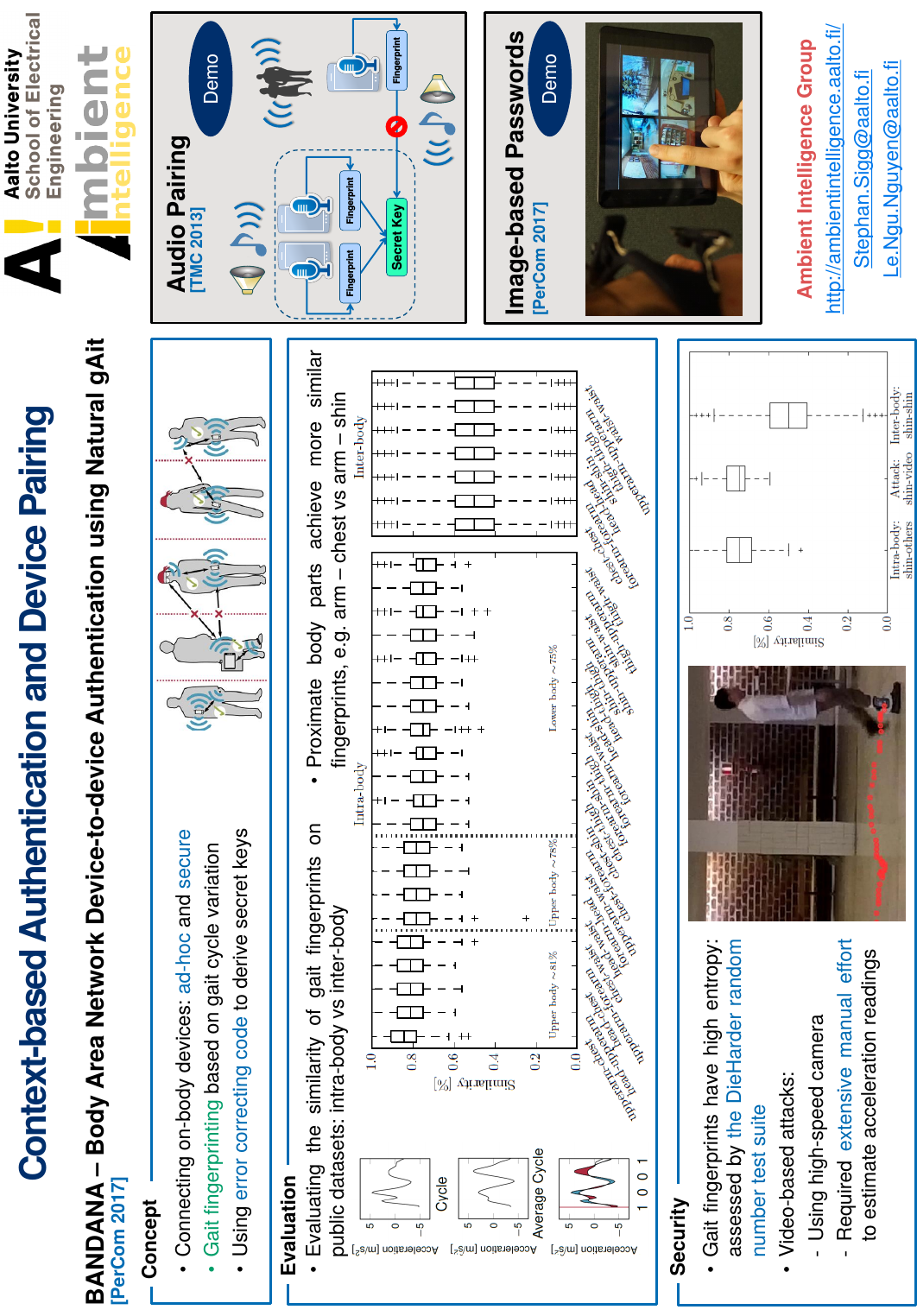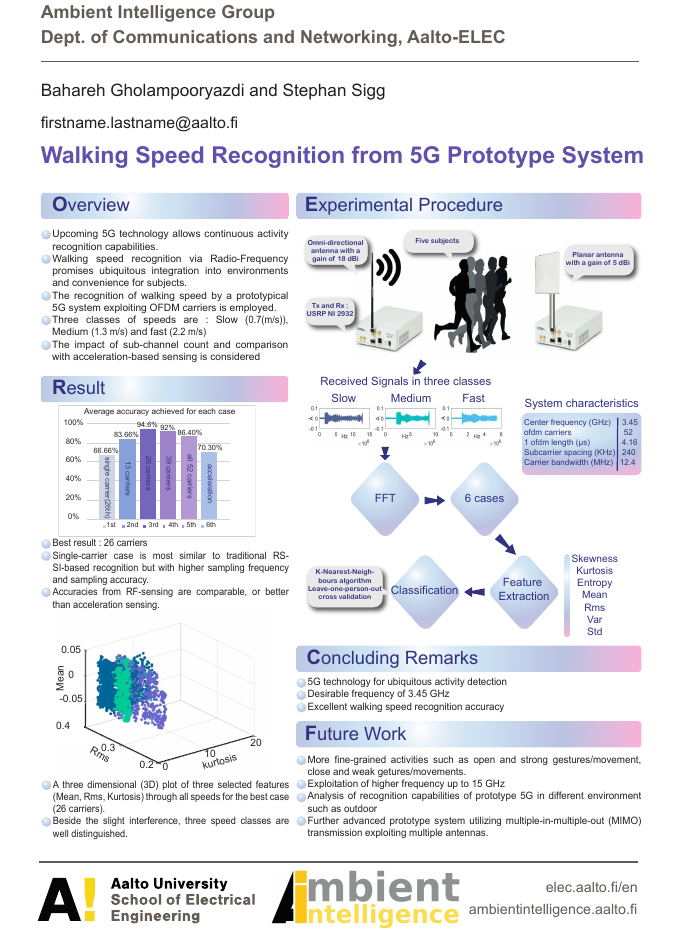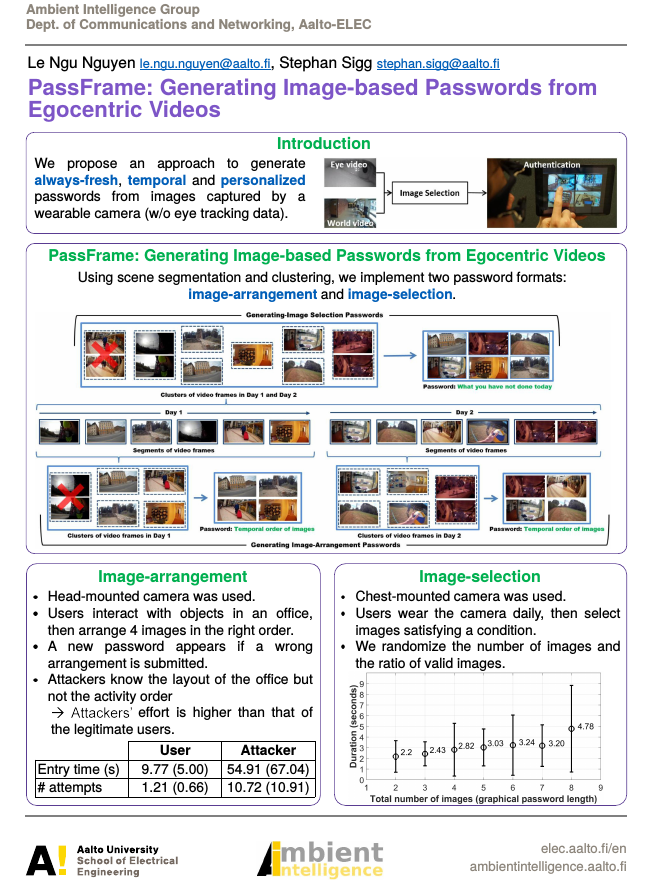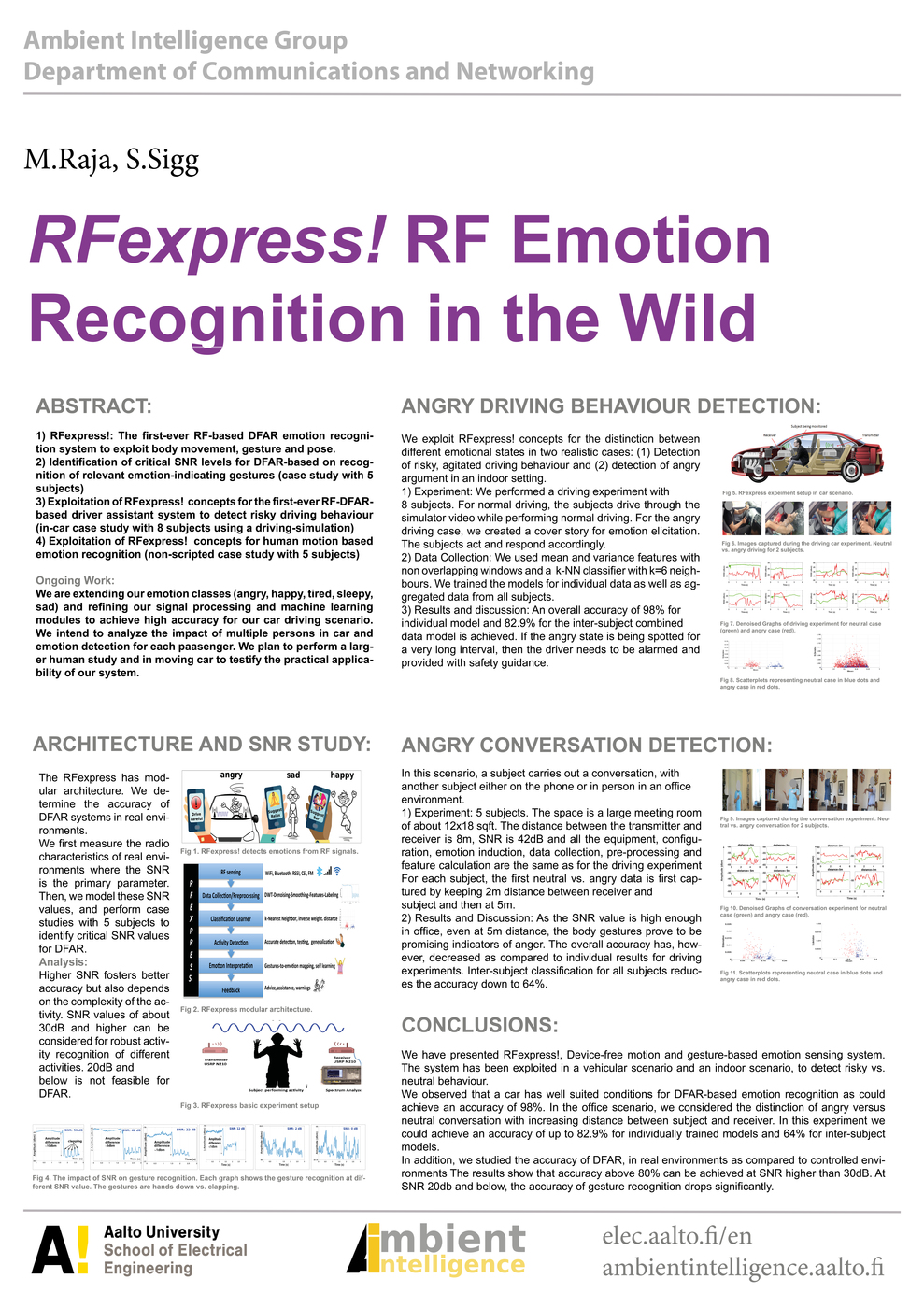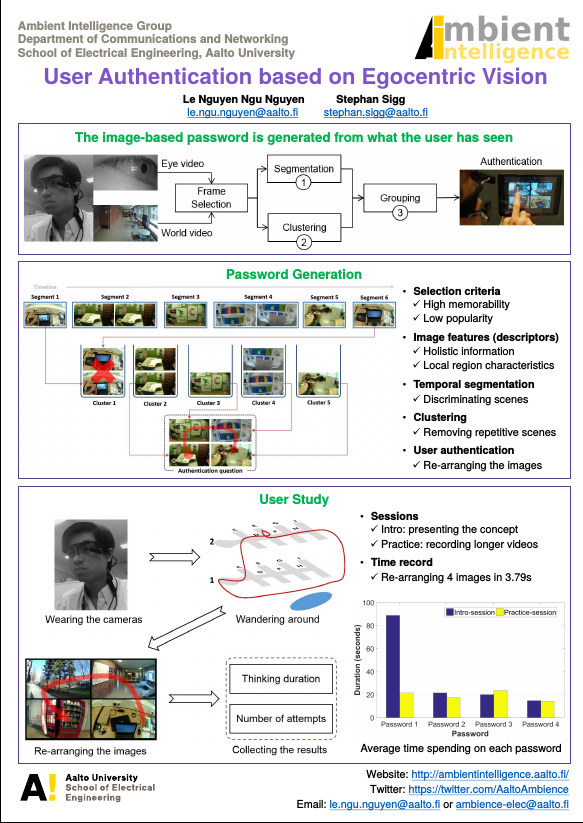
Stephan Sigg
- Aalto University
- Maarintie 8
- 00076 Espoo
- Finland
- +358 (0)50-4666941
- stephan.sigg@aalto.fi (PGP public key)
Stephan's research interests include the design, analysis and optimisation of algorithms for distributed and ubiquitous sensing systems. He has addressed research questions related to context prediction, collaborative transmission in Wireless sensor networks, context-based secure key generation, device-free passive activity recognition and computation of functions in wireless networks at the time of transmission.
Publications
other: Semantic Scholar Google Scholar, Research Gate, DBLP
Excellent! Next you can
create a new website with this list, or
embed it in an existing web page by copying & pasting
any of the following snippets.
JavaScript
(easiest)
PHP
iFrame
(not recommended)
<script src="https://bibbase.org/show?bib=https://ambientintelligence.aalto.fi/bibtex/LiteraturAll&folding=0&filter=author_short:Sigg&jsonp=1"></script>
<?php
$contents = file_get_contents("https://bibbase.org/show?bib=https://ambientintelligence.aalto.fi/bibtex/LiteraturAll&folding=0&filter=author_short:Sigg");
print_r($contents);
?>
<iframe src="https://bibbase.org/show?bib=https://ambientintelligence.aalto.fi/bibtex/LiteraturAll&folding=0&filter=author_short:Sigg"></iframe>
For more details see the documention.
This is a preview! To use this list on your own web site
or create a new web site from it,
create a free account. The file will be added
and you will be able to edit it in the File Manager.
We will show you instructions once you've created your account.
To the site owner:
Action required! Mendeley is changing its API. In order to keep using Mendeley with BibBase past April 14th, you need to:
- renew the authorization for BibBase on Mendeley, and
- update the BibBase URL in your page the same way you did when you initially set up this page.
2025
(1)
Transient Authentication from First-Person-View Video.
Nguyen, L. N.; Findling, R. D.; Poikela, M.; Zuo, S.; and Sigg, S.
Proc. ACM Interact. Mob. Wearable Ubiquitous Technol., 9(1). March 2025.
![Paper Transient Authentication from First-Person-View Video [link]](//bibbase.org/img/filetypes/link.svg) Paper
doi
link
bibtex
abstract
3 downloads
Paper
doi
link
bibtex
abstract
3 downloads
![Paper Transient Authentication from First-Person-View Video [link]](http://bibbase.org/img/filetypes/link.svg) Paper
doi
link
bibtex
abstract
3 downloads
Paper
doi
link
bibtex
abstract
3 downloads
@article{10.1145/3712266,
author = {Nguyen, Le Ngu and Findling, Rainhard Dieter and Poikela, Maija and Zuo, Si and Sigg, Stephan},
title = {Transient Authentication from First-Person-View Video},
year = {2025},
issue_date = {March 2025},
publisher = {Association for Computing Machinery},
address = {New York, NY, USA},
volume = {9},
number = {1},
url = {https://doi.org/10.1145/3712266},
doi = {10.1145/3712266},
abstract = {We propose PassFrame, a system which utilizes first-person-view videos to generate personalized authentication challenges based on human episodic memory of event sequences. From the recorded videos, relevant (memorable) scenes are selected to form image-based authentication challenges. These authentication challenges are compatible with a variety of screen sizes and input modalities. As the popularity of using wearable cameras in daily life is increasing, PassFrame may serve as a convenient personalized authentication mechanism to screen-based appliances and services of a camera wearer. We evaluated the system in various settings including a spatially constrained scenario with 12 participants and a deployment on smartphones with 16 participants and more than 9 hours continuous video per participant. The authentication challenge completion time ranged from 2.1 to 9.7 seconds (average: 6 sec), which could facilitate a secure yet usable configuration of three consecutive challenges for each login. We investigated different versions of the challenges to obfuscate potential privacy leakage or ethical concerns with 27 participants. We also assessed the authentication schemes in the presence of informed adversaries, such as friends, colleagues or spouses and were able to detect attacks from diverging login behaviour.},
journal = {Proc. ACM Interact. Mob. Wearable Ubiquitous Technol.},
month = mar,
articleno = {14},
numpages = {31},
keywords = {Always-fresh challenge, First-person-view video, Shoulder-surfing resistance, Transient authentication challenge, Usable security, User authentication},
group = {ambience}}
%%% 2024 %%%
We propose PassFrame, a system which utilizes first-person-view videos to generate personalized authentication challenges based on human episodic memory of event sequences. From the recorded videos, relevant (memorable) scenes are selected to form image-based authentication challenges. These authentication challenges are compatible with a variety of screen sizes and input modalities. As the popularity of using wearable cameras in daily life is increasing, PassFrame may serve as a convenient personalized authentication mechanism to screen-based appliances and services of a camera wearer. We evaluated the system in various settings including a spatially constrained scenario with 12 participants and a deployment on smartphones with 16 participants and more than 9 hours continuous video per participant. The authentication challenge completion time ranged from 2.1 to 9.7 seconds (average: 6 sec), which could facilitate a secure yet usable configuration of three consecutive challenges for each login. We investigated different versions of the challenges to obfuscate potential privacy leakage or ethical concerns with 27 participants. We also assessed the authentication schemes in the presence of informed adversaries, such as friends, colleagues or spouses and were able to detect attacks from diverging login behaviour.
2024
(11)
A Paradigm Shift From an Experimental-Based to a Simulation-Based Framework Using Motion-Capture Driven MIMO Radar Data Synthesis.
Waqar, S.; Muaaz, M.; Sigg, S.; and Pätzold, M.
IEEE Sensors Journal, 24(10): 16614-16628. 2024.
doi link bibtex
doi link bibtex
@ARTICLE{10500314,
author={Waqar, Sahil and Muaaz, Muhammad and Sigg, Stephan and Pätzold, Matthias},
journal={IEEE Sensors Journal},
title={A Paradigm Shift From an Experimental-Based to a Simulation-Based Framework Using Motion-Capture Driven MIMO Radar Data Synthesis},
year={2024},
volume={24},
number={10},
pages={16614-16628},
keywords={Radar;Human activity recognition;MIMO radar;Radar antennas;Sensors;MIMO;Trajectory;Motion capture;Virtual reality;Deep learning;Aspect angle;data augmentation;data synthesis;deep learning;distributed multiple-input multiple-output (MIMO) radar simulation;human activity recognition (HAR);micro-Doppler analysis;motion capture (MoCap);motion synthesis;multiclass classification;virtual reality},
doi={10.1109/JSEN.2024.3386221},
group = {ambience}}
Angle-Agnostic Radio Frequency Sensing Integrated Into 5G-NR.
Salami, D.; Hasibi, R.; Savazzi, S.; Michoel, T.; and Sigg, S.
IEEE Sensors Journal, 24(21): 36099-36114. 2024.
doi link bibtex
doi link bibtex
@ARTICLE{10684085,
author={Salami, Dariush and Hasibi, Ramin and Savazzi, Stefano and Michoel, Tom and Sigg, Stephan},
journal={IEEE Sensors Journal},
title={Angle-Agnostic Radio Frequency Sensing Integrated Into 5G-NR},
year={2024},
volume={24},
number={21},
pages={36099-36114},
keywords={Sensors;Sidelink;Radar;Radio frequency;Point cloud compression;Millimeter wave communication;Device-to-device communication;Gesture recognition;new radio (NR) sidelink;point cloud;radio frequency (RF) communication and sensing convergence},
doi={10.1109/JSEN.2024.3459428},
group = {ambience}}
%%% 2023 %%%
RFID-based Human Activity Recognition Using Multimodal Convolutional Neural Networks.
Golipoor, S.; and Sigg, S.
In 2024 IEEE 29th International Conference on Emerging Technologies and Factory Automation (ETFA), pages 1-6, 2024.
doi link bibtex
doi link bibtex
@INPROCEEDINGS{10710698,
author={Golipoor, Sahar and Sigg, Stephan},
booktitle={2024 IEEE 29th International Conference on Emerging Technologies and Factory Automation (ETFA)},
title={RFID-based Human Activity Recognition Using Multimodal Convolutional Neural Networks},
year={2024},
volume={},
number={},
pages={1-6},
keywords={Torso;Accuracy;Neural networks;Feature extraction;Reflector antennas;Safety;Convolutional neural networks;Human activity recognition;RFID tags;Manufacturing automation;RFID;activity recognition;human-sensing;multimodal learning},
doi={10.1109/ETFA61755.2024.10710698},
group = {ambience}}
Environment and Person-independent Gesture Recognition with Non-static RFID Tags Leveraging Adaptive Signal Segmentation.
Golipoor, S.; and Sigg, S.
In 2024 IEEE 29th International Conference on Emerging Technologies and Factory Automation (ETFA), pages 1-8, 2024.
doi link bibtex
doi link bibtex
@INPROCEEDINGS{10710733,
author={Golipoor, Sahar and Sigg, Stephan},
booktitle={2024 IEEE 29th International Conference on Emerging Technologies and Factory Automation (ETFA)},
title={Environment and Person-independent Gesture Recognition with Non-static RFID Tags Leveraging Adaptive Signal Segmentation},
year={2024},
volume={},
number={},
pages={1-8},
keywords={Image segmentation;Adaptation models;Accuracy;Gesture recognition;Safety;RFID tags;Usability;Time-domain analysis;Random forests;Manufacturing automation;RFID;gesture recognition;human-sensing;sig-nal processing;signal segmentation},
doi={10.1109/ETFA61755.2024.10710733},
group = {ambience}}
EmotionAware 2024: Eighth International Workshop on Emotion Awareness for Pervasive Computing Beyond Traditional Approaches - Welcome and Committees.
David, K.; Dobbins, C.; Heinisch, J.; Okoshi, T.; Dupré, D.; Gaggioli, A.; Gao, N.; Peltonen, E.; Sugaya, M.; Tag, B.; Van Laerhoven, K.; Mariani, S.; and Sigg, S.
2024 IEEE International Conference on Pervasive Computing and Communications Workshops and other Affiliated Events, PerCom Workshops 2024,23–24. 2024.
2024 IEEE International Conference on Pervasive Computing and Communications Workshops and other Affiliated Events, PerCom Workshops 2024 ; Conference date: 11-03-2024 Through 15-03-2024
doi link bibtex
doi link bibtex
@article{d80aff910d284a788a9a368cb3e5e80f,
title = "EmotionAware 2024: Eighth International Workshop on Emotion Awareness for Pervasive Computing Beyond Traditional Approaches - Welcome and Committees",
author = "Klaus David and Chelsea Dobbins and Judith Heinisch and Tadashi Okoshi and Damien Dupr{\'e} and Andrea Gaggioli and Nan Gao and Ella Peltonen and Midori Sugaya and Benjamin Tag and {Van Laerhoven}, Kristof and Stefano Mariani and Stephan Sigg",
year = "2024",
doi = "10.1109/PerComWorkshops59983.2024.10502380",
language = "English",
pages = "23--24",
journal = "2024 IEEE International Conference on Pervasive Computing and Communications Workshops and other Affiliated Events, PerCom Workshops 2024",
note = "2024 IEEE International Conference on Pervasive Computing and Communications Workshops and other Affiliated Events, PerCom Workshops 2024 ; Conference date: 11-03-2024 Through 15-03-2024",
group = {ambience},
}
Direction-agnostic gesture recognition system using commercial WiFi devices.
Qin, Y.; Sigg, S.; Pan, S.; and Li, Z.
Computer Communications, 216: 34-44. 2024.
![Paper Direction-agnostic gesture recognition system using commercial WiFi devices [link]](//bibbase.org/img/filetypes/link.svg) Paper
doi
link
bibtex
abstract
Paper
doi
link
bibtex
abstract
![Paper Direction-agnostic gesture recognition system using commercial WiFi devices [link]](http://bibbase.org/img/filetypes/link.svg) Paper
doi
link
bibtex
abstract
Paper
doi
link
bibtex
abstract
@article{QIN202434,
title = {Direction-agnostic gesture recognition system using commercial WiFi devices},
journal = {Computer Communications},
volume = {216},
pages = {34-44},
year = {2024},
issn = {0140-3664},
doi = {https://doi.org/10.1016/j.comcom.2023.12.033},
url = {https://www.sciencedirect.com/science/article/pii/S0140366423004747},
author = {Yuxi Qin and Stephan Sigg and Su Pan and Zibo Li},
keywords = {Channel state information, Direction-agnostic, Hand gesture recognition},
abstract = {In recent years, channel state information (CSI) has been used to recognize hand gestures for contactless human–computer interaction. However, most existing solutions require precision hardware or prior learning at the same angle both during training and for inference/training in order to achieve high recognition accuracy. This requirement is unrealistic for practical instrumentation, where the orientation of a subject relative to the RF receiver may be arbitrary. We present direction-agnostic hand gesture recognition utilizing commercial WiFi devices to overcome low accuracy in non-trained observation angles. To achieve equal conditions in all recognition angles, first of all, through the circular antenna arrangement to mitigate the impact of user direction changes. Then, the orientation of users is estimated by the Fresnel zone model. Finally, the feature mapping model of users in different orientations is established, and the gesture features in the estimated direction are mapped to the benchmark direction to eliminate the influence caused by the change of user orientation. Experimental results in a typical indoor environment show that WiNDR has superior performance, and the average recognition accuracy of five common gestures is 92.38\%.},
group = {ambience},
}
In recent years, channel state information (CSI) has been used to recognize hand gestures for contactless human–computer interaction. However, most existing solutions require precision hardware or prior learning at the same angle both during training and for inference/training in order to achieve high recognition accuracy. This requirement is unrealistic for practical instrumentation, where the orientation of a subject relative to the RF receiver may be arbitrary. We present direction-agnostic hand gesture recognition utilizing commercial WiFi devices to overcome low accuracy in non-trained observation angles. To achieve equal conditions in all recognition angles, first of all, through the circular antenna arrangement to mitigate the impact of user direction changes. Then, the orientation of users is estimated by the Fresnel zone model. Finally, the feature mapping model of users in different orientations is established, and the gesture features in the estimated direction are mapped to the benchmark direction to eliminate the influence caused by the change of user orientation. Experimental results in a typical indoor environment show that WiNDR has superior performance, and the average recognition accuracy of five common gestures is 92.38%.
Awareness in Robotics: An Early Perspective from the Viewpoint of the EIC Pathfinder Challenge ``Awareness Inside''.
Della Santina, C.; Corbato, C. H.; Sisman, B.; Leiva, L. A.; Arapakis, I.; Vakalellis, M.; Vanderdonckt, J.; D'Haro, L. F.; Manzi, G.; Becchio, C.; Elamrani, A.; Alirezaei, M.; Castellano, G.; Dimarogonas, D. V.; Ghosh, A.; Haesaert, S.; Soudjani, S.; Stroeve, S.; Verschure, P.; Bacciu, D.; Deroy, O.; Bahrami, B.; Gallicchio, C.; Hauert, S.; Sanz, R.; Lanillos, P.; Iacca, G.; Sigg, S.; Gasulla, M.; Steels, L.; and Sierra, C.
In Secchi, C.; and Marconi, L., editor(s), European Robotics Forum 2024, pages 108–113, Cham, 2024. Springer Nature Switzerland
link bibtex abstract
link bibtex abstract
@InProceedings{10.1007/978-3-031-76424-0_20,
author="Della Santina, Cosimo
and Corbato, Carlos Hernandez
and Sisman, Burak
and Leiva, Luis A.
and Arapakis, Ioannis
and Vakalellis, Michalis
and Vanderdonckt, Jean
and D'Haro, Luis Fernando
and Manzi, Guido
and Becchio, Cristina
and Elamrani, A{\"i}da
and Alirezaei, Mohsen
and Castellano, Ginevra
and Dimarogonas, Dimos V.
and Ghosh, Arabinda
and Haesaert, Sofie
and Soudjani, Sadegh
and Stroeve, Sybert
and Verschure, Paul
and Bacciu, Davide
and Deroy, Ophelia
and Bahrami, Bahador
and Gallicchio, Claudio
and Hauert, Sabine
and Sanz, Ricardo
and Lanillos, Pablo
and Iacca, Giovanni
and Sigg, Stephan
and Gasulla, Manel
and Steels, Luc
and Sierra, Carles",
editor="Secchi, Cristian
and Marconi, Lorenzo",
title="Awareness in Robotics: An Early Perspective from the Viewpoint of the EIC Pathfinder Challenge ``Awareness Inside''",
booktitle="European Robotics Forum 2024",
year="2024",
publisher="Springer Nature Switzerland",
address="Cham",
pages="108--113",
abstract="While consciousness has been historically a heavily debated topic, awareness had less success in raising the interest of scholars. However, more and more researchers are getting interested in answering questions concerning what awareness is and how it can be artificially generated. The landscape is rapidly evolving, with multiple voices and interpretations of the concept being conceived and techniques being developed. The goal of this paper is to summarize and discuss the ones among these voices connected with projects funded by the EIC Pathfinder Challenge ``Awareness Inside'' callwithin Horizon Europe, designed specifically for fostering research on natural and synthetic awareness. In this perspective, we dedicate special attention to challenges and promises of applying synthetic awareness in robotics, as the development of mature techniques in this new field is expected to have a special impact on generating more capable and trustworthy embodied systems.",
isbn="978-3-031-76424-0",
group = {ambience},}
While consciousness has been historically a heavily debated topic, awareness had less success in raising the interest of scholars. However, more and more researchers are getting interested in answering questions concerning what awareness is and how it can be artificially generated. The landscape is rapidly evolving, with multiple voices and interpretations of the concept being conceived and techniques being developed. The goal of this paper is to summarize and discuss the ones among these voices connected with projects funded by the EIC Pathfinder Challenge ``Awareness Inside'' callwithin Horizon Europe, designed specifically for fostering research on natural and synthetic awareness. In this perspective, we dedicate special attention to challenges and promises of applying synthetic awareness in robotics, as the development of mature techniques in this new field is expected to have a special impact on generating more capable and trustworthy embodied systems.
Generating Multivariate Synthetic Time Series Data for Absent Sensors from Correlated Sources.
Bañuelos, J. J.; Sigg, S.; He, J.; Salim, F.; and Costa-Requena, J.
In Proceedings of the 2nd International Workshop on Networked AI Systems, of NetAISys '24, pages 19–24, New York, NY, USA, 2024. Association for Computing Machinery
![Paper Generating Multivariate Synthetic Time Series Data for Absent Sensors from Correlated Sources [link]](//bibbase.org/img/filetypes/link.svg) Paper
doi
link
bibtex
abstract
2 downloads
Paper
doi
link
bibtex
abstract
2 downloads
![Paper Generating Multivariate Synthetic Time Series Data for Absent Sensors from Correlated Sources [link]](http://bibbase.org/img/filetypes/link.svg) Paper
doi
link
bibtex
abstract
2 downloads
Paper
doi
link
bibtex
abstract
2 downloads
@inproceedings{10.1145/3662004.3663553,
author = {Ba\~{n}uelos, Juli\'{a}n Jer\'{o}nimo and Sigg, Stephan and He, Jiayuan and Salim, Flora and Costa-Requena, Jose},
title = {Generating Multivariate Synthetic Time Series Data for Absent Sensors from Correlated Sources},
year = {2024},
isbn = {9798400706615},
publisher = {Association for Computing Machinery},
address = {New York, NY, USA},
url = {https://doi.org/10.1145/3662004.3663553},
doi = {10.1145/3662004.3663553},
abstract = {Missing sensor data in human activity recognition is an active field of research that is being targeted with generative models for synthetic data generation. In contrast to most previous approaches, we aim to generate data of a sensor exclusively from data available at sensors in different body locations. Particularly, we evaluate existing approaches proposed in the literature for their suitability in this scenario. In this paper, we focus on the prediction of acceleration data and generate machine learning models based on generative adversarial networks and trained using correlated data from sensors in different body positions to generate synthetic sensor data that can replace the missing data from a sensor in a specific body position. The accuracy of the generated synthetic data is evaluated using a classification model based on a convolutional neural network for human activity recognition.},
booktitle = {Proceedings of the 2nd International Workshop on Networked AI Systems},
pages = {19–24},
numpages = {6},
keywords = {accelerometer, cnn, gan, human activity recognition, iot, multivariate time series data, sensor data, synthetic data generation},
location = {Minato-ku, Tokyo, Japan},
series = {NetAISys '24},
group = {ambience}}
Missing sensor data in human activity recognition is an active field of research that is being targeted with generative models for synthetic data generation. In contrast to most previous approaches, we aim to generate data of a sensor exclusively from data available at sensors in different body locations. Particularly, we evaluate existing approaches proposed in the literature for their suitability in this scenario. In this paper, we focus on the prediction of acceleration data and generate machine learning models based on generative adversarial networks and trained using correlated data from sensors in different body positions to generate synthetic sensor data that can replace the missing data from a sensor in a specific body position. The accuracy of the generated synthetic data is evaluated using a classification model based on a convolutional neural network for human activity recognition.
Generating Multivariate Synthetic Time Series Data for Absent Sensors from Correlated Sources.
Bañuelos, J. J.; Sigg, S.; He, J.; Salim, F.; and Costa-Requena, J.
In Proceedings of the 2nd International Workshop on Networked AI Systems, of NetAISys '24, pages 19–24, New York, NY, USA, 2024. Association for Computing Machinery
![Paper Generating Multivariate Synthetic Time Series Data for Absent Sensors from Correlated Sources [link]](//bibbase.org/img/filetypes/link.svg) Paper
doi
link
bibtex
abstract
2 downloads
Paper
doi
link
bibtex
abstract
2 downloads
![Paper Generating Multivariate Synthetic Time Series Data for Absent Sensors from Correlated Sources [link]](http://bibbase.org/img/filetypes/link.svg) Paper
doi
link
bibtex
abstract
2 downloads
Paper
doi
link
bibtex
abstract
2 downloads
@inproceedings{10.1145/3662004.3663553,
author = {Ba\~{n}uelos, Juli\'{a}n Jer\'{o}nimo and Sigg, Stephan and He, Jiayuan and Salim, Flora and Costa-Requena, Jose},
title = {Generating Multivariate Synthetic Time Series Data for Absent Sensors from Correlated Sources},
year = {2024},
isbn = {9798400706615},
publisher = {Association for Computing Machinery},
address = {New York, NY, USA},
url = {https://doi.org/10.1145/3662004.3663553},
doi = {10.1145/3662004.3663553},
abstract = {Missing sensor data in human activity recognition is an active field of research that is being targeted with generative models for synthetic data generation. In contrast to most previous approaches, we aim to generate data of a sensor exclusively from data available at sensors in different body locations. Particularly, we evaluate existing approaches proposed in the literature for their suitability in this scenario. In this paper, we focus on the prediction of acceleration data and generate machine learning models based on generative adversarial networks and trained using correlated data from sensors in different body positions to generate synthetic sensor data that can replace the missing data from a sensor in a specific body position. The accuracy of the generated synthetic data is evaluated using a classification model based on a convolutional neural network for human activity recognition.},
booktitle = {Proceedings of the 2nd International Workshop on Networked AI Systems},
pages = {19–24},
numpages = {6},
keywords = {accelerometer, cnn, gan, human activity recognition, iot, multivariate time series data, sensor data, synthetic data generation},
location = {Minato-ku, Tokyo, Japan},
series = {NetAISys '24},
group = {ambience}}
Missing sensor data in human activity recognition is an active field of research that is being targeted with generative models for synthetic data generation. In contrast to most previous approaches, we aim to generate data of a sensor exclusively from data available at sensors in different body locations. Particularly, we evaluate existing approaches proposed in the literature for their suitability in this scenario. In this paper, we focus on the prediction of acceleration data and generate machine learning models based on generative adversarial networks and trained using correlated data from sensors in different body positions to generate synthetic sensor data that can replace the missing data from a sensor in a specific body position. The accuracy of the generated synthetic data is evaluated using a classification model based on a convolutional neural network for human activity recognition.
Towards Green Edge Intelligence.
Ben Cheikh, S.; and Sigg, S.
In Proceedings of the 13th International Conference on the Internet of Things, of IoT '23, pages 197–199, New York, NY, USA, 2024. Association for Computing Machinery
![Paper Towards Green Edge Intelligence [link]](//bibbase.org/img/filetypes/link.svg) Paper
doi
link
bibtex
abstract
Paper
doi
link
bibtex
abstract
![Paper Towards Green Edge Intelligence [link]](http://bibbase.org/img/filetypes/link.svg) Paper
doi
link
bibtex
abstract
Paper
doi
link
bibtex
abstract
@inproceedings{10.1145/3627050.3630737,
author = {Ben Cheikh, Sami and Sigg, Stephan},
title = {Towards Green Edge Intelligence},
year = {2024},
isbn = {9798400708541},
publisher = {Association for Computing Machinery},
address = {New York, NY, USA},
url = {https://doi.org/10.1145/3627050.3630737},
doi = {10.1145/3627050.3630737},
abstract = {This study presents our ongoing activities, along with a demonstration that showcases the integration of these endeavours into a real-world application. We demonstrate the integration of IoT devices with energy harvesting systems, as well as the incorporation of deep learning techniques into IoT devices. Finally, we consider the utilization of radio frequency (RF) technology for gesture detection and classification, based on deep learning algorithms.},
booktitle = {Proceedings of the 13th International Conference on the Internet of Things},
pages = {197–199},
numpages = {3},
keywords = {Cloud computing, E-Health, Edge intelligence, Internet of Things, Smart Cities, Wireless power transfer},
location = {Nagoya, Japan},
series = {IoT '23},
group = {ambience}}
This study presents our ongoing activities, along with a demonstration that showcases the integration of these endeavours into a real-world application. We demonstrate the integration of IoT devices with energy harvesting systems, as well as the incorporation of deep learning techniques into IoT devices. Finally, we consider the utilization of radio frequency (RF) technology for gesture detection and classification, based on deep learning algorithms.
An Application Programming Interface for Android to support dedicated 5G network slicing.
Jerónimo Bañuelos, J.; Costa-Requena, J.; He, J.; Salim, F.; and Sigg, S.
In Proceedings of the 13th International Conference on the Internet of Things, of IoT '23, pages 193–196, New York, NY, USA, 2024. Association for Computing Machinery
![Paper An Application Programming Interface for Android to support dedicated 5G network slicing [link]](//bibbase.org/img/filetypes/link.svg) Paper
doi
link
bibtex
abstract
Paper
doi
link
bibtex
abstract
![Paper An Application Programming Interface for Android to support dedicated 5G network slicing [link]](http://bibbase.org/img/filetypes/link.svg) Paper
doi
link
bibtex
abstract
Paper
doi
link
bibtex
abstract
@inproceedings{10.1145/3627050.3630735,
author = {Jer\'{o}nimo Ba\~{n}uelos, Juli\'{a}n and Costa-Requena, Jose and He, Jiayuan and Salim, Flora and Sigg, Stephan},
title = {An Application Programming Interface for Android to support dedicated 5G network slicing},
year = {2024},
isbn = {9798400708541},
publisher = {Association for Computing Machinery},
address = {New York, NY, USA},
url = {https://doi.org/10.1145/3627050.3630735},
doi = {10.1145/3627050.3630735},
abstract = {Recent technological advances in telecommunications networks such as the development and deployment of the fifth-generation technology standard for broadband cellular networks (5G) have enabled a wide array of new functionalities for mobile networks, also including for the first time, reduced capability (IoT) devices. The possibility to request on-demand specific features of the mobile network such as an improved reliability, faster broadband speed, or low latency depending on the type of content that is consumed by the application through 5G network slicing will allow to provide a better user experience under adequate network conditions. Provisioning devices with 5G network slicing capabilities is of great interest for manufacturers, carriers, and developers, particularly in IoT-type communication which may feature unique bandwidth and resource requirements. As a first step, this paper proposes an Application Programming Interface (API) to act as a bridge between an Android device and the 5G core network to provide Android-based devices with 5G network slicing functionality.},
booktitle = {Proceedings of the 13th International Conference on the Internet of Things},
pages = {193–196},
numpages = {4},
keywords = {5G, AOSP, API, android, mobile devices, network slicing, software interface},
location = {Nagoya, Japan},
series = {IoT '23},
group = {ambience}}
Recent technological advances in telecommunications networks such as the development and deployment of the fifth-generation technology standard for broadband cellular networks (5G) have enabled a wide array of new functionalities for mobile networks, also including for the first time, reduced capability (IoT) devices. The possibility to request on-demand specific features of the mobile network such as an improved reliability, faster broadband speed, or low latency depending on the type of content that is consumed by the application through 5G network slicing will allow to provide a better user experience under adequate network conditions. Provisioning devices with 5G network slicing capabilities is of great interest for manufacturers, carriers, and developers, particularly in IoT-type communication which may feature unique bandwidth and resource requirements. As a first step, this paper proposes an Application Programming Interface (API) to act as a bridge between an Android device and the 5G core network to provide Android-based devices with 5G network slicing functionality.
2023
(9)
A Joint Radar and Communication Approach for 5G NR using Reinforcement Learning.
Salami, D.; Ning, W.; Ruttik, K.; Jäntti, R.; and Sigg, S.
IEEE Communications Magazine, 61(5): 106-112. 2023.
doi link bibtex
doi link bibtex
@ARTICLE{10129041,
author={Salami, Dariush and Ning, Wanru and Ruttik, Kalle and Jäntti, Riku and Sigg, Stephan},
journal={IEEE Communications Magazine},
title={A Joint Radar and Communication Approach for 5G NR using Reinforcement Learning},
year={2023},
volume={61},
number={5},
pages={106-112},
keywords={Communication systems;5G mobile communication;Estimation;Radar;Interference;Reinforcement learning;Air traffic control},
doi={10.1109/MCOM.001.2200474},
group = {ambience}}
Water quality analysis using mmWave radars.
Salami, D.; Juvakoski, A.; Vahala, R.; Beigl, M.; and Sigg, S.
In 2023 IEEE International Conference on Pervasive Computing and Communications Workshops and other Affiliated Events (PerCom Workshops), pages 412-415, 2023.
doi link bibtex
doi link bibtex
@INPROCEEDINGS{10150256,
author={Salami, Dariush and Juvakoski, Anni and Vahala, Riku and Beigl, Michael and Sigg, Stephan},
booktitle={2023 IEEE International Conference on Pervasive Computing and Communications Workshops and other Affiliated Events (PerCom Workshops)},
title={Water quality analysis using mmWave radars},
year={2023},
volume={},
number={},
pages={412-415},
keywords={Meteorological radar;Liquids;Radar detection;Radar;Water quality;Water pollution;Millimeter wave communication;mmWave radar;AI;ML;water quality analysis},
doi={10.1109/PerComWorkshops56833.2023.10150256},
group = {ambience}}
Detecting an Ataxia-Type Disease from Acceleration Data.
Kränzle, E.; and Sigg, S.
In 2023 IEEE International Conference on Pervasive Computing and Communications Workshops and other Affiliated Events (PerCom Workshops), pages 38-43, 2023.
doi link bibtex
doi link bibtex
@INPROCEEDINGS{10150335,
author={Kränzle, Eileen and Sigg, Stephan},
booktitle={2023 IEEE International Conference on Pervasive Computing and Communications Workshops and other Affiliated Events (PerCom Workshops)},
title={Detecting an Ataxia-Type Disease from Acceleration Data},
year={2023},
volume={},
number={},
pages={38-43},
keywords={Pervasive computing;Correlation;Tracking;Conferences;Sensors;High frequency;Task analysis;Ataxia;Miras;IMU},
doi={10.1109/PerComWorkshops56833.2023.10150335},
group = {ambience}}
Fast converging Federated Learning with Non-IID Data.
Naas, S.; and Sigg, S.
In 2023 IEEE 97th Vehicular Technology Conference (VTC2023-Spring), pages 1-6, 2023.
doi link bibtex
doi link bibtex
@INPROCEEDINGS{10200108,
author={Naas, Si-Ahmed and Sigg, Stephan},
booktitle={2023 IEEE 97th Vehicular Technology Conference (VTC2023-Spring)},
title={Fast converging Federated Learning with Non-IID Data},
year={2023},
volume={},
number={},
pages={1-6},
keywords={Performance evaluation;Weight measurement;Federated learning;Computational modeling;Merging;Data models;Bayes methods;Federated learning;communication reduction;non-iid data;edge computing;fog networks;Internet of things},
doi={10.1109/VTC2023-Spring57618.2023.10200108},
group = {ambience}}
Accurate RF-sensing of complex gestures using RFID with variable phase-profiles.
Golipoor, S.; and Sigg, S.
In 2023 IEEE 32nd International Symposium on Industrial Electronics (ISIE), pages 1-4, 2023.
doi link bibtex
doi link bibtex
@INPROCEEDINGS{10228178,
author={Golipoor, Sahar and Sigg, Stephan},
booktitle={2023 IEEE 32nd International Symposium on Industrial Electronics (ISIE)},
title={Accurate RF-sensing of complex gestures using RFID with variable phase-profiles},
year={2023},
volume={},
number={},
pages={1-4},
keywords={Instruments;Pipelines;Laboratories;Signal processing;Solids;Skeleton;Reflection;RF-based human sensing;RFID},
doi={10.1109/ISIE51358.2023.10228178},
group = {ambience}}
Unsupervised statistical feature-guided diffusion model for sensor-based human activity recognition.
Zuo, S.; Rey, V. F.; Suh, S.; Sigg, S.; and Lukowicz, P.
arXiv preprint arXiv:2306.05285. 2023.
link bibtex
link bibtex
@article{zuo2023unsupervised,
title={Unsupervised statistical feature-guided diffusion model for sensor-based human activity recognition},
author={Zuo, Si and Rey, Vitor Fortes and Suh, Sungho and Sigg, Stephan and Lukowicz, Paul},
journal={arXiv preprint arXiv:2306.05285},
year={2023},
group = {ambience}}
Unsupervised Diffusion Model for Sensor-based Human Activity Recognition.
Zuo, S.; Fortes, V.; Suh, S.; Sigg, S.; and Lukowicz, P.
In Adjunct Proceedings of the 2023 ACM International Joint Conference on Pervasive and Ubiquitous Computing & the 2023 ACM International Symposium on Wearable Computing, of UbiComp/ISWC '23 Adjunct, pages 205, New York, NY, USA, 2023. Association for Computing Machinery
![Paper Unsupervised Diffusion Model for Sensor-based Human Activity Recognition [link]](//bibbase.org/img/filetypes/link.svg) Paper
doi
link
bibtex
abstract
1 download
Paper
doi
link
bibtex
abstract
1 download
![Paper Unsupervised Diffusion Model for Sensor-based Human Activity Recognition [link]](http://bibbase.org/img/filetypes/link.svg) Paper
doi
link
bibtex
abstract
1 download
Paper
doi
link
bibtex
abstract
1 download
@inproceedings{10.1145/3594739.3610797,
author = {Zuo, Si and Fortes, Vitor and Suh, Sungho and Sigg, Stephan and Lukowicz, Paul},
title = {Unsupervised Diffusion Model for Sensor-based Human Activity Recognition},
year = {2023},
isbn = {9798400702006},
publisher = {Association for Computing Machinery},
address = {New York, NY, USA},
url = {https://doi.org/10.1145/3594739.3610797},
doi = {10.1145/3594739.3610797},
abstract = {Recognizing human activities from sensor data is a vital task in various domains, but obtaining diverse and labeled sensor data remains challenging and costly. In this paper, we propose an unsupervised statistical feature-guided diffusion model for sensor-based human activity recognition. The proposed method aims to generate synthetic time-series sensor data without relying on labeled data, addressing the scarcity and annotation difficulties associated with real-world sensor data. By conditioning the diffusion model on statistical information such as mean, standard deviation, Z-score, and skewness, we generate diverse and representative synthetic sensor data. We conducted experiments on public human activity recognition datasets and compared the proposed method to conventional oversampling methods and state-of-the-art generative adversarial network methods. The experimental results demonstrate that the proposed method can improve the performance of human activity recognition and outperform existing techniques.},
booktitle = {Adjunct Proceedings of the 2023 ACM International Joint Conference on Pervasive and Ubiquitous Computing \& the 2023 ACM International Symposium on Wearable Computing},
pages = {205},
numpages = {1},
keywords = {Human activity recognition, Sensor data generation, Statistical feature-guided diffusion model, Unsupervised learning},
location = {Cancun, Quintana Roo, Mexico},
series = {UbiComp/ISWC '23 Adjunct},
group = {ambience}}
Recognizing human activities from sensor data is a vital task in various domains, but obtaining diverse and labeled sensor data remains challenging and costly. In this paper, we propose an unsupervised statistical feature-guided diffusion model for sensor-based human activity recognition. The proposed method aims to generate synthetic time-series sensor data without relying on labeled data, addressing the scarcity and annotation difficulties associated with real-world sensor data. By conditioning the diffusion model on statistical information such as mean, standard deviation, Z-score, and skewness, we generate diverse and representative synthetic sensor data. We conducted experiments on public human activity recognition datasets and compared the proposed method to conventional oversampling methods and state-of-the-art generative adversarial network methods. The experimental results demonstrate that the proposed method can improve the performance of human activity recognition and outperform existing techniques.
PPSFL: Privacy-preserving Split Federated Learning via Functional Encryption.
Ma, J.; Xixiang, L.; Yu, Y.; and Sigg, S.
. September 2023.
![Paper PPSFL: Privacy-preserving Split Federated Learning via Functional Encryption [link]](//bibbase.org/img/filetypes/link.svg) Paper
doi
link
bibtex
Paper
doi
link
bibtex
![Paper PPSFL: Privacy-preserving Split Federated Learning via Functional Encryption [link]](http://bibbase.org/img/filetypes/link.svg) Paper
doi
link
bibtex
Paper
doi
link
bibtex
@article{Ma_2023,
title={PPSFL: Privacy-preserving Split Federated Learning via Functional Encryption},
url={http://dx.doi.org/10.36227/techrxiv.24082659.v1},
DOI={10.36227/techrxiv.24082659.v1},
publisher={Institute of Electrical and Electronics Engineers (IEEE)},
author={Ma, Jing and Xixiang, Lv and Yu, Yong and Sigg, Stephan},
year={2023},
month=sep,
group = {ambience}}
Introduction to the Special Issue on Wireless Sensing for IoT.
Ma, H.; He, Y.; Li, M.; Patwari, N.; and Sigg, S.
ACM Trans. Internet Things, 4(4). December 2023.
![Paper Introduction to the Special Issue on Wireless Sensing for IoT [link]](//bibbase.org/img/filetypes/link.svg) Paper
doi
link
bibtex
abstract
Paper
doi
link
bibtex
abstract
![Paper Introduction to the Special Issue on Wireless Sensing for IoT [link]](http://bibbase.org/img/filetypes/link.svg) Paper
doi
link
bibtex
abstract
Paper
doi
link
bibtex
abstract
@article{10.1145/3633078,
author = {Ma, Huadong and He, Yuan and Li, Mo and Patwari, Neal and Sigg, Stephan},
title = {Introduction to the Special Issue on Wireless Sensing for IoT},
year = {2023},
issue_date = {November 2023},
publisher = {Association for Computing Machinery},
address = {New York, NY, USA},
volume = {4},
number = {4},
url = {https://doi.org/10.1145/3633078},
doi = {10.1145/3633078},
abstract = {ACM TIOT launched its first special issue on the theme of wireless sensing for IoT. As an important component of the special issue and a novel practice of the journal, an online virtual workshop will be held, with presentations for each of the accepted articles. Welcome to join us for online discussion! Free registration is required for an attendee of the workshop. The zoom link will be shared to registered attendees before the workshop.},
journal = {ACM Trans. Internet Things},
month = dec,
articleno = {21},
numpages = {4},
group = {ambience}}
%%% 2022 %%%
ACM TIOT launched its first special issue on the theme of wireless sensing for IoT. As an important component of the special issue and a novel practice of the journal, an online virtual workshop will be held, with presentations for each of the accepted articles. Welcome to join us for online discussion! Free registration is required for an attendee of the workshop. The zoom link will be shared to registered attendees before the workshop.
2022
(9)
CardioID: Secure ECG-BCG agnostic interaction-free device pairing.
Zuo, S.; Sigg, S.; Beck, N.; Jähne-Raden, N.; Wolf, M. C.; and others
IEEE Access, 10: 128682–128696. 2022.
link bibtex
link bibtex
@article{zuo2022cardioid,
title={CardioID: Secure ECG-BCG agnostic interaction-free device pairing},
author={Zuo, Si and Sigg, Stephan and Beck, Nils and J{\"a}hne-Raden, Nico and Wolf, Marie Cathrine and others},
journal={IEEE Access},
volume={10},
pages={128682--128696},
year={2022},
publisher={IEEE},
group = {ambience}}
Personalized Gestures Through Motion Transfer: Protecting Privacy in Pervasive Surveillance.
Zuo, S.; and Sigg, S.
IEEE Pervasive Computing, 21(4): 8–16. 2022.
link bibtex
link bibtex
@article{zuo2022personalized,
title={Personalized Gestures Through Motion Transfer: Protecting Privacy in Pervasive Surveillance},
author={Zuo, Si and Sigg, Stephan},
journal={IEEE Pervasive Computing},
volume={21},
number={4},
pages={8--16},
year={2022},
publisher={IEEE},
group = {ambience}}
Personalized Gestures Through Motion Transfer.
Zuo, S.; and Sigg, S.
. 2022.
link bibtex
link bibtex
@article{zuo2022personalized,
title={Personalized Gestures Through Motion Transfer},
author={Zuo, Si and Sigg, Stephan},
year={2022},
publisher={IEEE},
group = {ambience}}
Knowledge Sharing in AI Services: A Market-based Approach.
Mohammed, T.; Naas, S.; Sigg, S.; and Francesco, M. D.
IEEE Internet of Things Journal. 2022.
link bibtex
link bibtex
@article{ahmed2022,
title={Knowledge Sharing in AI Services: A Market-based Approach},
author={Thatha Mohammed and Si-Ahmed Naas and Stephan Sigg and Mario Di Francesco},
journal={IEEE Internet of Things Journal},
year={2022},
publisher={IEEE},
group = {ambience},
project = {redi},
group = {ambience}}
User Localization Using RF Sensing. A Performance Comparison between LIS and mmWave Radars.
Rubio, C. J. V.; Salami, D.; Popovski, P.; Carvalho, E. D.; Tan, Z.; and Sigg, S.
In EUSIPCO, 2022.
link bibtex
link bibtex
@inproceedings{Rubio22,
title={User Localization Using RF Sensing. A Performance Comparison between LIS and mmWave Radars},
author={Cristian Jesus Vaca Rubio and Dariush Salami and Petar Popovski and Elisabeth De Carvalho and Zheng-Hua Tan and Stephan Sigg},
booktitle={EUSIPCO},
year={2022},
group = {ambience},
project = {windmill},
group = {ambience}}
Tesla-rapture: A lightweight gesture recognition system from mmwave radar sparse point clouds.
Salami, D.; Hasibi, R.; Palipana, S.; Popovski, P.; Michoel, T.; and Sigg, S.
IEEE Transactions on Mobile Computing. 2022.
link bibtex
link bibtex
@article{salami2022tesla,
title={Tesla-rapture: A lightweight gesture recognition system from mmwave radar sparse point clouds},
author={Salami, Dariush and Hasibi, Ramin and Palipana, Sameera and Popovski, Petar and Michoel, Tom and Sigg, Stephan},
journal={IEEE Transactions on Mobile Computing},
year={2022},
publisher={IEEE},
group = {ambience},
project = {radiosense},
group = {ambience}}
Energy-Efficient Design for RIS-Assisted UAV Communications in Beyond-5G Networks.
Deshpande, A. A.; Rubio, C. J. V.; Mohebi, S.; Salami, D.; Carvalho, E. D.; Sigg, S.; Zorzi, M.; and Zanella, A.
In IEEE MedComNet, 2022.
link bibtex
link bibtex
@inproceedings{Anay2022RIS,
title={Energy-Efficient Design for RIS-Assisted UAV Communications in Beyond-5G Networks},
author={Anay Ajit Deshpande and Cristian Jesus Vaca Rubio and Salman Mohebi and Dariush Salami and Elisabeth De Carvalho and Stephan Sigg and Michele Zorzi and Andrea Zanella},
booktitle={IEEE MedComNet},
year={2022},
group = {ambience},
project = {windmill},
group = {ambience}}
Privacy-preserving federated learning based on multi-key homomorphic encryption.
Ma, J.; Naas, S.; Sigg, S.; and Lyu, X.
International Journal of Intelligent Systems. 2022.
link bibtex
link bibtex
@article{ma2022privacy,
title={Privacy-preserving federated learning based on multi-key homomorphic encryption},
author={Ma, Jing and Naas, Si-Ahmed and Sigg, Stephan and Lyu, Xixiang},
journal={International Journal of Intelligent Systems},
year={2022},
publisher={Wiley Online Library},
group = {ambience}}
Detection of an Ataxia-type disease from EMG and IMU sensors .
Dorszewski, T.; Jiang, W.; and Sigg, S.
In The 20th International Conference on Pervasive Computing and Communications (PerCom 2021), adjunct, 2022.
link bibtex
link bibtex
@inproceedings{,
title={Detection of an Ataxia-type disease from EMG and IMU sensors },
author={Tobias Dorszewski and Weixuan Jiang and Stephan Sigg},
booktitle={The 20th International Conference on Pervasive Computing and Communications (PerCom 2021), adjunct},
year={2022},
group = {ambience},
project = {MIRAS},
group = {ambience}}
%%% 2021 %%%
2021
(10)
Zero-shot Motion Pattern Recognition from 4D Point Clouds.
Salami, D.; and Sigg, S.
In IEEE 31st International Workshop on Machine Learning for Signal Processing (MLSP), 2021.
link bibtex
link bibtex
@InProceedings{Salami_2021_MLSP,
author = {Dariush Salami and Stephan Sigg},
booktitle = {IEEE 31st International Workshop on Machine Learning for Signal Processing (MLSP)},
title = {Zero-shot Motion Pattern Recognition from 4D Point Clouds},
year = {2021},
project ={radiosense,windmill},
group={ambience}
}
Privacy in Speech Communication Technology.
Bäckström, T.; Zarazaga, P. P.; Das, S.; and Sigg, S.
In Fonetiikan päivät-Phonetics Symposium, 2021.
link bibtex
link bibtex
@inproceedings{backstrom2021privacy,
title={Privacy in Speech Communication Technology},
author={B{\"a}ckstr{\"o}m, Tom and Zarazaga, Pablo Perez and Das, Sneha and Sigg, Stephan},
booktitle={Fonetiikan p{\"a}iv{\"a}t-Phonetics Symposium},
year={2021},
group={ambience}
}
Intuitive Privacy from Acoustic Reach: A Case for Networked Voice User-Interfaces.
Bäckström, T.; Das, S.; Zarazaga, P. P.; Fischer, J.; Findling, R. D.; Sigg, S.; and Nguyen, L. N.
In Proc. 2021 ISCA Symposium on Security and Privacy in Speech Communication, pages 57–61, 2021.
link bibtex
link bibtex
@inproceedings{backstrom2021intuitive,
title={Intuitive Privacy from Acoustic Reach: A Case for Networked Voice User-Interfaces},
author={B{\"a}ckstr{\"o}m, Tom and Das, Sneha and Zarazaga, Pablo P{\'e}rez and Fischer, Johannes and Findling, Rainhard Dieter and Sigg, Stephan and Nguyen, Le Ngu},
booktitle={Proc. 2021 ISCA Symposium on Security and Privacy in Speech Communication},
pages={57--61},
year={2021},
group={ambience}
}
Adversary Models for Mobile Device Authentication.
Mayrhofer, R.; and Sigg, S.
ACM Computing Surveys,1-33. 2021.
doi link bibtex abstract 1 download
doi link bibtex abstract 1 download
@article{Mayrhofer_2021_ACMCS,
author={Rene Mayrhofer and Stephan Sigg},
journal={ACM Computing Surveys},
title={Adversary Models for Mobile Device Authentication},
year={2021},
abstract={Mobile device authentication has been a highly active research topic for over 10 years, with a vast range of methods proposed and analyzed.
In related areas, such as secure channel protocols, remote authentication, or desktop user authentication, strong, systematic, and increasingly formal threat models have been established and are used to qualitatively compare different methods.
However, the analysis of mobile device authentication is often based on weak adversary models, suggesting overly optimistic results on their respective security.
In this article, we introduce a new classification of adversaries to better analyze and compare mobile device authentication methods. We apply this classification to a systematic literature survey. The survey shows that security is still an afterthought and that most proposed protocols lack a comprehensive security analysis.
The proposed classification of adversaries provides a strong and practical adversary model that offers a comparable and transparent classification of security properties in mobile device authentication.
},
issue_date = {to appear},
publisher = {ACM},
volume = { },
number = { },
pages = {1-33},
group = {ambience},
doi = {10.1145/3477601}
}
Mobile device authentication has been a highly active research topic for over 10 years, with a vast range of methods proposed and analyzed. In related areas, such as secure channel protocols, remote authentication, or desktop user authentication, strong, systematic, and increasingly formal threat models have been established and are used to qualitatively compare different methods. However, the analysis of mobile device authentication is often based on weak adversary models, suggesting overly optimistic results on their respective security. In this article, we introduce a new classification of adversaries to better analyze and compare mobile device authentication methods. We apply this classification to a systematic literature survey. The survey shows that security is still an afterthought and that most proposed protocols lack a comprehensive security analysis. The proposed classification of adversaries provides a strong and practical adversary model that offers a comparable and transparent classification of security properties in mobile device authentication.
Camouflage learning. Feature value obscuring ambient intelligence for constrained devices.
Nguyen, L. N.; Sigg, S.; Lietzen, J.; Findling, R. D.; and Ruttik, K.
IEEE Transactions on Mobile Computing,1-17. 2021.
link bibtex abstract
link bibtex abstract
@article{Le_2021_TMC,
author={Le Ngu Nguyen and Stephan Sigg and Jari Lietzen and Rainhard Dieter Findling and Kalle Ruttik},
journal={IEEE Transactions on Mobile Computing},
title={Camouflage learning. Feature value obscuring ambient intelligence for constrained devices},
year={2021},
abstract={Ambient intelligence demands collaboration schemes for distributed constrained devices which are not only highly energy efficient in distributed sensing, processing and communication, but which also respect data privacy. Traditional algorithms for distributed processing suffer in Ambient intelligence domains either from limited data privacy, or from their excessive processing demands for constrained distributed devices.
In this paper, we present Camouflage learning, a distributed machine learning scheme that obscures the trained model via probabilistic collaboration using physical-layer computation offloading and demonstrate the feasibility of the approach on backscatter communication prototypes and in comparison with Federated learning. We show that Camouflage learning is more energy efficient than traditional schemes and that it requires less communication overhead while reducing the computation load through physical-layer computation offloading. The scheme is synchronization-agnostic and thus appropriate for sharply constrained, synchronization-incapable devices. We demonstrate model training and inference on four distinct datasets and investigate the performance of the scheme with respect to communication range, impact of challenging communication environments, power consumption, and the backscatter hardware prototype.
},
issue_date = {July 2021},
publisher = {IEEE},
volume = { },
number = { },
pages = {1-17},
group = {ambience},
project = {abacus}
}
Ambient intelligence demands collaboration schemes for distributed constrained devices which are not only highly energy efficient in distributed sensing, processing and communication, but which also respect data privacy. Traditional algorithms for distributed processing suffer in Ambient intelligence domains either from limited data privacy, or from their excessive processing demands for constrained distributed devices. In this paper, we present Camouflage learning, a distributed machine learning scheme that obscures the trained model via probabilistic collaboration using physical-layer computation offloading and demonstrate the feasibility of the approach on backscatter communication prototypes and in comparison with Federated learning. We show that Camouflage learning is more energy efficient than traditional schemes and that it requires less communication overhead while reducing the computation load through physical-layer computation offloading. The scheme is synchronization-agnostic and thus appropriate for sharply constrained, synchronization-incapable devices. We demonstrate model training and inference on four distinct datasets and investigate the performance of the scheme with respect to communication range, impact of challenging communication environments, power consumption, and the backscatter hardware prototype.
BCG and ECG-based secure communication for medical devices in Body Area Networks.
Beck, N.; Zuo, S.; and Sigg, S.
In The 19th International Conference on Pervasive Computing and Communications (PerCom 2021), adjunct, 2021.
link bibtex abstract
link bibtex abstract
@inproceedings{Beck2020BCGECG,
title={BCG and ECG-based secure communication for medical devices in Body Area Networks},
author={Nils Beck and Si Zuo and Stephan Sigg},
booktitle={The 19th International Conference on Pervasive Computing and Communications (PerCom 2021), adjunct},
year={2021},
abstract={An increasing amount of medical devices, such as pace makers or insulin pumps, is able to communicate in wireless Body Area Networks (BANs). While this facilitates interaction between users and medical devices, something that was previously more complicated or - in the case of implanted devices - often impossible, it also raises security and privacy questions. We exploit the wide availability of ballistocardiographs (BCG) and electocardiographs (ECG) in consumer wearables and propose MEDISCOM, an ad-hoc, implicit and secure communication protocol for medical devices in local BANs. Deriving common secret keys from a body’s BCG or ECG signal. MEDISCOM ensures confidentiality and integrity of sensitive medical data and also continuously authenticates devices, requiring no explicit user interaction and maintaining a low computational overhead. We consider relevant attack vectors and show how MEDISCOM is resilient towards them. Furthermore, we validate the security of the secret keys that our protocol derives on BCG and ECG data from 29 subjects.
},
group = {ambience},
project = {abacus}
}
An increasing amount of medical devices, such as pace makers or insulin pumps, is able to communicate in wireless Body Area Networks (BANs). While this facilitates interaction between users and medical devices, something that was previously more complicated or - in the case of implanted devices - often impossible, it also raises security and privacy questions. We exploit the wide availability of ballistocardiographs (BCG) and electocardiographs (ECG) in consumer wearables and propose MEDISCOM, an ad-hoc, implicit and secure communication protocol for medical devices in local BANs. Deriving common secret keys from a body’s BCG or ECG signal. MEDISCOM ensures confidentiality and integrity of sensitive medical data and also continuously authenticates devices, requiring no explicit user interaction and maintaining a low computational overhead. We consider relevant attack vectors and show how MEDISCOM is resilient towards them. Furthermore, we validate the security of the secret keys that our protocol derives on BCG and ECG data from 29 subjects.
Camouflage Learning.
Sigg, S.; Nguyen, L. N.; and Ma, J.
In The 19th International Conference on Pervasive Computing and Communications (PerCom 2021), adjunct, 2021.
link bibtex abstract
link bibtex abstract
@inproceedings{Sigg2020Camouflage,
title={Camouflage Learning},
author={Stephan Sigg and Le Ngu Nguyen and Jing Ma},
booktitle={The 19th International Conference on Pervasive Computing and Communications (PerCom 2021), adjunct},
year={2021},
abstract={Federated learning has been proposed as a concept for distributed machine learning which enforces privacy by avoiding sharing private data with a coordinator or distributed nodes. Instead of gathering datasets to a central server for model training in traditional machine learning, in federated learning, model updates are computed locally at distributed devices and merged at a coordinator. However, information on local data might be leaked through the model updates. We propose Camouflage learning, a distributed machine learning scheme that distributes both the data and the model. Neither the distributed devices nor the coordinator is at any point in time in possession of the complete model. Furthermore, data and model are obfuscated during distributed model inference and distributed model training. Camouflage learning can be implemented with various Machine learning schemes.
},
group = {ambience},
project = {radiosense, abacus}
}
Federated learning has been proposed as a concept for distributed machine learning which enforces privacy by avoiding sharing private data with a coordinator or distributed nodes. Instead of gathering datasets to a central server for model training in traditional machine learning, in federated learning, model updates are computed locally at distributed devices and merged at a coordinator. However, information on local data might be leaked through the model updates. We propose Camouflage learning, a distributed machine learning scheme that distributes both the data and the model. Neither the distributed devices nor the coordinator is at any point in time in possession of the complete model. Furthermore, data and model are obfuscated during distributed model inference and distributed model training. Camouflage learning can be implemented with various Machine learning schemes.
Towards battery-less RF sensing.
Kodali, M.; Nguyen, L. N.; and Sigg, S.
In The 19th International Conference on Pervasive Computing and Communications (PerCom 2021), WiP, 2021.
link bibtex abstract
link bibtex abstract
@inproceedings{Manila2020BatteryLess,
title={Towards battery-less RF sensing},
author={Manila Kodali and Le Ngu Nguyen and Stephan Sigg},
booktitle={The 19th International Conference on Pervasive Computing and Communications (PerCom 2021), WiP},
year={2021},
abstract={Recent work has demonstrated the use of the radio interface as a sensing modality for gestures, activities and situational perception. The field generally moves towards larger bandwidths, multiple antennas, and higher, mmWave frequency domains, which allow for the recognition of minute movements. We envision another set of applications for RF sensing: battery-less autonomous sensing devices. In this work, we investigate transceiver-less passive RF-sensors which are excited by the fluctuation of the received power over the wireless channel. In particular, we demonstrate the use of battery-less RF-sensing for applications of on-body gesture recognition integrated into smart garment, as well as the integration of such sensing capabilities into smart surfaces.
},
group = {ambience},
project = {radiosense,abacus}
}
Recent work has demonstrated the use of the radio interface as a sensing modality for gestures, activities and situational perception. The field generally moves towards larger bandwidths, multiple antennas, and higher, mmWave frequency domains, which allow for the recognition of minute movements. We envision another set of applications for RF sensing: battery-less autonomous sensing devices. In this work, we investigate transceiver-less passive RF-sensors which are excited by the fluctuation of the received power over the wireless channel. In particular, we demonstrate the use of battery-less RF-sensing for applications of on-body gesture recognition integrated into smart garment, as well as the integration of such sensing capabilities into smart surfaces.
Pantomime: Mid-Air Gesture Recognition with Sparse Millimeter-Wave Radar Point Clouds.
Palipana, S.; Salami, D.; Leiva, L.; and Sigg, S.
Proceedings of the ACM on Interactive, Mobile, Wearable and Ubiquitous Technologies (IMWUT), 5(1): 1-27. 2021.
link bibtex abstract
link bibtex abstract
@article{Sameera_2021_IMWUT,
author={Sameera Palipana and Dariush Salami and Luis Leiva and Stephan Sigg},
journal={Proceedings of the ACM on Interactive, Mobile, Wearable and Ubiquitous Technologies (IMWUT)},
title={Pantomime: Mid-Air Gesture Recognition with Sparse Millimeter-Wave Radar Point Clouds},
year={2021},
abstract={We introduce Pantomime, a novel mid-air gesture recognition system exploiting spatio-temporal properties of millimeter-wave radio frequency (RF) signals. Pantomime is positioned in a unique region of the RF landscape: mid-resolution mid-range high-frequency sensing, which makes it ideal for motion gesture interaction. We configure a commercial frequency-modulated continuous-wave radar device to promote spatial information over temporal resolution by means of sparse 3D point clouds, and contribute a deep learning architecture that directly consumes the point cloud, enabling real-time performance with low computational demands. Pantomime achieves 95\% accuracy and 99\% AUC in a challenging set of 21 gestures articulated by 45 participants in two indoor environments, outperforming four state-of-the-art 3D point cloud recognizers. We also analyze the effect of environment, articulation speed, angle, and distance to the sensor. We conclude that Pantomime is resilient to various input conditions and that it may enable novel applications in industrial, vehicular, and smart home scenarios.
},
issue_date = {March 2021},
publisher = {ACM New York, NY, USA},
volume = {5},
number = {1},
pages = {1-27},
group = {ambience},
project = {radiosense,windmill}
}
We introduce Pantomime, a novel mid-air gesture recognition system exploiting spatio-temporal properties of millimeter-wave radio frequency (RF) signals. Pantomime is positioned in a unique region of the RF landscape: mid-resolution mid-range high-frequency sensing, which makes it ideal for motion gesture interaction. We configure a commercial frequency-modulated continuous-wave radar device to promote spatial information over temporal resolution by means of sparse 3D point clouds, and contribute a deep learning architecture that directly consumes the point cloud, enabling real-time performance with low computational demands. Pantomime achieves 95% accuracy and 99% AUC in a challenging set of 21 gestures articulated by 45 participants in two indoor environments, outperforming four state-of-the-art 3D point cloud recognizers. We also analyze the effect of environment, articulation speed, angle, and distance to the sensor. We conclude that Pantomime is resilient to various input conditions and that it may enable novel applications in industrial, vehicular, and smart home scenarios.
Sharing geotagged pictures for an Emotion-based Recommender System.
Hitz, A.; Naas, S.; and Sigg, S.
In The 19th International Conference on Pervasive Computing and Communications (PerCom 2021), adjunct, 2021.
link bibtex abstract
link bibtex abstract
@inproceedings{hitz2020Emotion,
title={Sharing geotagged pictures for an Emotion-based Recommender System},
author={Andreas Hitz and Si-Ahmed Naas and Stephan Sigg},
booktitle={The 19th International Conference on Pervasive Computing and Communications (PerCom 2021), adjunct},
year={2021},
abstract={Recommender systems are prominently used for movie or app recommendation or in e-commerce by considering profiles, past preferences and increasingly also further personalized measures. We designed and implemented an emotion-based recommender system for city visitors that takes into account user emotion and user location for the recommendation process. We conducted a comparative study between the emotion-based recommender system and recommender systems based on traditional measures. Our evaluation study involved 28 participators and the experiments showed that the emotion-based recommender system increased the average rating of the recommendation by almost 19%. We conclude that the use of emotion can significantly improve the results and especially their level of personalization.
},
group = {ambience}
}
%%% 2020 %%%
Recommender systems are prominently used for movie or app recommendation or in e-commerce by considering profiles, past preferences and increasingly also further personalized measures. We designed and implemented an emotion-based recommender system for city visitors that takes into account user emotion and user location for the recommendation process. We conducted a comparative study between the emotion-based recommender system and recommender systems based on traditional measures. Our evaluation study involved 28 participators and the experiments showed that the emotion-based recommender system increased the average rating of the recommendation by almost 19%. We conclude that the use of emotion can significantly improve the results and especially their level of personalization.
2020
(16)
A Global Brain fuelled by Local intelligence: Optimizing Mobile Services and Networks with AI.
Naas, S.; Mohammed, T.; and Sigg, S.
In 2020 16th International Conference on Mobility, Sensing and Networking (MSN), pages 23–32, 2020. IEEE
link bibtex
link bibtex
@inproceedings{naas2020global,
title={A Global Brain fuelled by Local intelligence: Optimizing Mobile Services and Networks with AI},
author={Naas, Si-Ahmed and Mohammed, Thaha and Sigg, Stephan},
booktitle={2020 16th International Conference on Mobility, Sensing and Networking (MSN)},
pages={23--32},
year={2020},
organization={IEEE},
group={ambience}
}
Functional Gaze Prediction in Egocentric Video.
Naas, S. A.; Jiang, X.; Sigg, S.; and Ji, Y.
In 18th International Conference on Advances in Mobile Computing and Multimedia (MoMM2020), 2020.
link bibtex
link bibtex
@inproceedings{Ahmed2020gaze,
title={Functional Gaze Prediction in Egocentric Video},
author={Si Ahmed Naas and Xiaolan Jiang and Stephan Sigg and Yusheng Ji},
booktitle={18th International Conference on Advances in Mobile Computing and Multimedia (MoMM2020)},
year={2020},
group = {ambience}
}
Acoustic Fingerprints for Access Management in Ad-Hoc Sensor Networks.
Zarazaga, P. P.; Bäckström, T.; and Sigg, S.
IEEE Access. 2020.
doi link bibtex abstract
doi link bibtex abstract
@article{Pablo_2020_Acoustic,
author={Pablo Pérez Zarazaga and Tom B\"ackstr\"om and Stephan Sigg},
journal={IEEE Access},
title={Acoustic Fingerprints for Access Management in Ad-Hoc Sensor Networks},
year={2020},
abstract={Voice user interfaces can offer intuitive interaction with our devices, but the usability and audio quality could be further improved if multiple devices could collaborate to provide a distributed voice user interface. To ensure that users' voices are not shared with unauthorized devices, it is however necessary to design an access management system that adapts to the users' needs. Prior work has demonstrated that a combination of audio fingerprinting and fuzzy cryptography yields a robust pairing of devices without sharing the information that they record. However, the robustness of these systems is partially based on the extensive duration of the recordings that are required to obtain the fingerprint. This paper analyzes methods for robust generation of acoustic fingerprints in short periods of time to enable the responsive pairing of devices according to changes in the acoustic scenery and can be integrated into other typical speech processing tools.},
group = {ambience},
doi = {10.1109/ACCESS.2020.3022618}
}
Voice user interfaces can offer intuitive interaction with our devices, but the usability and audio quality could be further improved if multiple devices could collaborate to provide a distributed voice user interface. To ensure that users' voices are not shared with unauthorized devices, it is however necessary to design an access management system that adapts to the users' needs. Prior work has demonstrated that a combination of audio fingerprinting and fuzzy cryptography yields a robust pairing of devices without sharing the information that they record. However, the robustness of these systems is partially based on the extensive duration of the recordings that are required to obtain the fingerprint. This paper analyzes methods for robust generation of acoustic fingerprints in short periods of time to enable the responsive pairing of devices according to changes in the acoustic scenery and can be integrated into other typical speech processing tools.
Analysing Ballistocardiography for Pervasive Healthcare.
Hytönen, R.; Tshala, A.; Schreier, J.; Holopainen, M.; Forsman, A.; Oksanen, M.; Findling, R.; Nguyen, L. N.; Jähne-Raden, N.; and Sigg, S.
In 16th International Conference on Mobility, Sensing and Networking (MSN 2020) , 2020.
link bibtex
link bibtex
@inproceedings{hytonen2020BCG,
title={Analysing Ballistocardiography for Pervasive Healthcare},
author={Roni Hytönen and Alison Tshala and Jan Schreier and Melissa Holopainen and Aada Forsman and Minna Oksanen and Rainhard Findling and Le Ngu Nguyen and Nico Jähne-Raden and Stephan Sigg},
booktitle={16th International Conference on Mobility, Sensing and Networking (MSN 2020) },
year={2020},
group = {ambience}
}
A Global Brain fuelled by Local intelligence Optimizing Mobile Services and Networks with AI.
Naas, S. A.; Mohammed, T.; and Sigg, S.
In 16th International Conference on Mobility, Sensing and Networking (MSN 2020) , 2020.
link bibtex
link bibtex
@inproceedings{naas2020GlobalBrain,
title={A Global Brain fuelled by Local intelligence Optimizing Mobile Services and Networks with AI},
author={Si Ahmed Naas and Thaha Mohammed and Stephan Sigg},
booktitle={16th International Conference on Mobility, Sensing and Networking (MSN 2020) },
year={2020},
group = {ambience}
}
A FAIR Extension for the MQTT Protocol.
Salami, D.; Streibel, O.; and Sigg, S.
In 16th International Conference on Mobility, Sensing and Networking (MSN 2020) , 2020.
link bibtex
link bibtex
@inproceedings{salami2020MQTT,
title={A FAIR Extension for the MQTT Protocol},
author={Dariush Salami and Olga Streibel and Stephan Sigg},
booktitle={16th International Conference on Mobility, Sensing and Networking (MSN 2020) },
year={2020},
group = {ambience},
project={abacus}
}
Real-time Emotion Recognition for Sales.
Naas, S. A.; and Sigg, S.
In 16th International Conference on Mobility, Sensing and Networking (MSN 2020) , 2020.
link bibtex
link bibtex
@inproceedings{naas2020RealTime,
title={Real-time Emotion Recognition for Sales},
author={Si Ahmed Naas and Stephan Sigg},
booktitle={16th International Conference on Mobility, Sensing and Networking (MSN 2020) },
year={2020},
group = {ambience}
}
A Multisensory Edge-Cloud Platform for Opportunistic Sensing in Cobot Environments.
Kianoush, S.; Savazzi, S.; Beschi, M.; Sigg, S.; and Rampa, V.
IEEE Internet of Things Journal. 2020.
doi link bibtex
doi link bibtex
@article{Sanaz_2020_IoT,
author={Sanaz Kianoush and Stefano Savazzi and Manuel Beschi and Stephan Sigg and Vittorio Rampa},
journal={IEEE Internet of Things Journal},
title={A Multisensory Edge-Cloud Platform for Opportunistic Sensing in Cobot Environments},
year={2020},
doi = {10.1109/JIOT.2020.3011809},
project={radiosense},
group = {ambience}
}
SVP: Sinusoidal Viewport Predictionfor 360-Degree Video Streaming.
Jiang, X.; Naas, S. A.; Chiang, Y.; Sigg, S.; and Ji, Y.
IEEE Access, 8. 2020.
doi link bibtex abstract
doi link bibtex abstract
@article{Chiang_2020_Viewpoint,
author={Xiaolan Jiang and Si Ahmed Naas and Yi-Han Chiang and Stephan Sigg and Yusheng Ji},
journal={IEEE Access},
title={SVP: Sinusoidal Viewport Predictionfor 360-Degree Video Streaming},
year={2020},
abstract={The rapid growth of user expectations and network technologies has proliferated the service needs of 360-degree video streaming. In the light of the unprecedented bitrates required to deliver entire 360-degree videos, tile-based streaming, which associates viewport and non-viewport tiles with different qualities, has emerged as a promising way to facilitate 360-degree video streaming in practice. Existing work on viewport prediction primarily targets prediction accuracy, which potentially gives rise to excessive computational overhead and latency. In this paper, we propose a sinusoidal viewport prediction (SVP) system for 360-degree video streaming to overcome the aforementioned issues. In particular, the SVP system leverages 1) sinusoidal values of rotation angles to predict orientation, 2) the relationship between prediction errors, prediction time window and head movement velocities to improve the prediction accuracy, and 3) the normalized viewing probabilities of tiles to further improve adaptive bitrate (ABR) streaming performance. To evaluate the performance of the SVP system, we conduct extensive simulations based on real-world datasets. Simulation results demonstrate that the SVP system outperforms state-of-the-art schemes under various buffer thresholds and bandwidth settings in terms of viewport prediction accuracy and video quality, revealing its applicability to both live and video-on-demand streaming in practical scenarios.},
group = {ambience},
volume = {8},
doi = {10.1109/ACCESS.2020.3022062}
}
The rapid growth of user expectations and network technologies has proliferated the service needs of 360-degree video streaming. In the light of the unprecedented bitrates required to deliver entire 360-degree videos, tile-based streaming, which associates viewport and non-viewport tiles with different qualities, has emerged as a promising way to facilitate 360-degree video streaming in practice. Existing work on viewport prediction primarily targets prediction accuracy, which potentially gives rise to excessive computational overhead and latency. In this paper, we propose a sinusoidal viewport prediction (SVP) system for 360-degree video streaming to overcome the aforementioned issues. In particular, the SVP system leverages 1) sinusoidal values of rotation angles to predict orientation, 2) the relationship between prediction errors, prediction time window and head movement velocities to improve the prediction accuracy, and 3) the normalized viewing probabilities of tiles to further improve adaptive bitrate (ABR) streaming performance. To evaluate the performance of the SVP system, we conduct extensive simulations based on real-world datasets. Simulation results demonstrate that the SVP system outperforms state-of-the-art schemes under various buffer thresholds and bandwidth settings in terms of viewport prediction accuracy and video quality, revealing its applicability to both live and video-on-demand streaming in practical scenarios.
Development of a Presentation Interface for Seismo- and Ballistocardiographic Data.
Jähne-Raden, N.; Wolf, M. C.; Sigg, S.; and Kulau, U.
In Studies in health technology and Informatics, 2020.
link bibtex
link bibtex
@InProceedings{Nico_2020_BCG,
author = {Nico Jähne-Raden and Marie Cathrine Wolf and Stephan Sigg and Ulf Kulau},
booktitle = {Studies in health technology and Informatics},
title = {Development of a Presentation Interface for Seismo- and Ballistocardiographic Data},
year = {2020},
project ={ballisto},
group={ambience}
}
A structured measurement of highly synchronous real-time ballistocardiography signal data of heart failure patients.
Jähne-Raden, N.; Bavendiek, U.; Gutschleg, H.; Kulau, U.; Sigg, S.; Wolf, M. C.; Zeppernick, T.; and Marschollek, M.
In Studies in health technology and Informatics, 2020.
link bibtex
link bibtex
@InProceedings{Nico_2020_HeartFailure,
author = {Nico Jähne-Raden and Udo Bavendiek and Henrike Gutschleg and Ulf Kulau and Stephan Sigg and Marie Cathrine Wolf and Tanja Zeppernick and Michael Marschollek},
booktitle = {Studies in health technology and Informatics},
title = {A structured measurement of highly synchronous real-time ballistocardiography signal data of heart failure patients},
year = {2020},
project ={ballisto},
group={ambience}
}
Motion Pattern Recognition in 4D Point Clouds.
Salami, D.; Palipana, S.; Kodali, M.; and Sigg, S.
In IEEE 30th International Workshop on Machine Learning for Signal Processing (MLSP), 2020.
link bibtex
link bibtex
@InProceedings{Salami_2020_MLSP,
author = {Dariush Salami and Sameera Palipana and Manila Kodali and Stephan Sigg},
booktitle = {IEEE 30th International Workshop on Machine Learning for Signal Processing (MLSP)},
title = {Motion Pattern Recognition in 4D Point Clouds},
year = {2020},
project ={radiosense,windmill},
group={ambience}
}
3D head motion detection using millimeter-wave Doppler radar.
Raja, M.; Vali, Z.; Palipana, S.; Michelson, D. G.; and Sigg, S.
IEEE Access. 2020.
doi link bibtex
doi link bibtex
@article{Muneeba_2020_3D,
author={ Muneeba Raja and Zahra Vali and Sameera Palipana and David G. Michelson and Stephan Sigg },
journal={IEEE Access},
title={3D head motion detection using millimeter-wave Doppler radar},
year={2020},
doi = {10.1109/ACCESS.2020.2973957},
project={radiosense},
group = {ambience}
}
Provable Consent for Voice User Interfaces.
Sigg, S.; Nguyen, L. N.; Zarazaga, P. P.; and Backstrom, T.
In 18th Annual IEEE International Conference on Pervasive Computing and Communications (PerCom) adjunct, 2020.
PerCom 2020 BEST WIP PAPER
link bibtex abstract
link bibtex abstract
@InProceedings{Sigg_2020_ProvableConsent,
author = {Stephan Sigg and Le Ngu Nguyen and Pablo Perez Zarazaga and Tom Backstrom},
booktitle = {18th Annual IEEE International Conference on Pervasive Computing and Communications (PerCom) adjunct},
title = {Provable Consent for Voice User Interfaces},
year = {2020},
abstract = {The proliferation of acoustic human-computer interaction raises privacy concerns since it allows Voice User Interfaces (VUI) to overhear human speech and to analyze and share content of overheard conversation in cloud datacenters and with third parties. This process is non-transparent regarding when and which audio is recorded, the reach of the speech recording, the information extracted from a recording and the purpose for which it is used. To return control over the use of audio content to the individual who generated it, we promote intuitive privacy for VUIs, featuring a lightweight consent mechanism as well as means of secure verification (proof of consent) for any recorded piece of audio. In particular, through audio fingerprinting and fuzzy cryptography, we establish a trust zone, whose area is implicitly controlled by voice loudness with respect to environmental noise (Signal-to-Noise Ratio (SNR)). Secure keys are exchanged to verify consent on the use of an audio sequence via digital signatures. We performed experiments with different levels of human voice, corresponding to various trust situations (e.g. whispering and group discussion). A second scenario was investigated in which a VUI outside of the trust zone could not obtain the shared secret key.},
note = {PerCom 2020 BEST WIP PAPER},
group = {ambience}
}
The proliferation of acoustic human-computer interaction raises privacy concerns since it allows Voice User Interfaces (VUI) to overhear human speech and to analyze and share content of overheard conversation in cloud datacenters and with third parties. This process is non-transparent regarding when and which audio is recorded, the reach of the speech recording, the information extracted from a recording and the purpose for which it is used. To return control over the use of audio content to the individual who generated it, we promote intuitive privacy for VUIs, featuring a lightweight consent mechanism as well as means of secure verification (proof of consent) for any recorded piece of audio. In particular, through audio fingerprinting and fuzzy cryptography, we establish a trust zone, whose area is implicitly controlled by voice loudness with respect to environmental noise (Signal-to-Noise Ratio (SNR)). Secure keys are exchanged to verify consent on the use of an audio sequence via digital signatures. We performed experiments with different levels of human voice, corresponding to various trust situations (e.g. whispering and group discussion). A second scenario was investigated in which a VUI outside of the trust zone could not obtain the shared secret key.
Beamsteering for training-free Recognition of Multiple Humans Performing Distinct Activities.
Palipana, S.; Malm, N.; and Sigg, S.
In 18th Annual IEEE International Conference on Pervasive Computing and Communications (PerCom) , 2020.
doi link bibtex abstract
doi link bibtex abstract
@InProceedings{Sameera_2020_Beamsteering,
author = {Sameera Palipana and Nicolas Malm and Stephan Sigg},
booktitle = {18th Annual IEEE International Conference on Pervasive Computing and Communications (PerCom) },
title = {Beamsteering for training-free Recognition of Multiple Humans Performing Distinct Activities},
year = {2020},
doi = {10.1109/PerCom45495.2020.9127374},
abstract = {Recognition of the context of humans plays an important role in pervasive applications such as intrusion detection, human density estimation for heating, ventilation and air-conditioning in smart buildings, as well as safety guarantee for workers during human-robot interaction. Radio vision is able to provide these sensing capabilities with low privacy intrusion. A common challenge though, for current radio sensing solutions is to distinguish simultaneous movement from multiple subjects. We present an approach that exploits multi-antenna installations, for instance, found in upcoming 5G instrumentations, to detect and extract activities from spatially scattered human targets in an ad-hoc manner in arbitrary environments and without prior training of the multi-subject detection. We perform receiver-side beamforming and beam-steering over different azimuth angles to detect human presence in those regions separately. We characterize the resultant fluctuations in the spatial streams due to human influence using a case study and make the traces publicly available. We demonstrate the potential of this approach through two applications: 1) By feeding the similarities of the resulting spatial streams into a clustering algorithm, we count the humans in a given area without prior training. (up to 6 people in a 22.4m2 area with an accuracy that significantly exceeds the related work). 2) We further demonstrate that simultaneously conducted activities and gestures can be extracted from the spatial streams through blind source separation.},
%url_Paper = {http://ambientintelligence.aalto.fi/paper/findling_closed_eye_eog.pdf},
project = {radiosense},
group = {ambience}
}
Recognition of the context of humans plays an important role in pervasive applications such as intrusion detection, human density estimation for heating, ventilation and air-conditioning in smart buildings, as well as safety guarantee for workers during human-robot interaction. Radio vision is able to provide these sensing capabilities with low privacy intrusion. A common challenge though, for current radio sensing solutions is to distinguish simultaneous movement from multiple subjects. We present an approach that exploits multi-antenna installations, for instance, found in upcoming 5G instrumentations, to detect and extract activities from spatially scattered human targets in an ad-hoc manner in arbitrary environments and without prior training of the multi-subject detection. We perform receiver-side beamforming and beam-steering over different azimuth angles to detect human presence in those regions separately. We characterize the resultant fluctuations in the spatial streams due to human influence using a case study and make the traces publicly available. We demonstrate the potential of this approach through two applications: 1) By feeding the similarities of the resulting spatial streams into a clustering algorithm, we count the humans in a given area without prior training. (up to 6 people in a 22.4m2 area with an accuracy that significantly exceeds the related work). 2) We further demonstrate that simultaneously conducted activities and gestures can be extracted from the spatial streams through blind source separation.
Contactless Body Movement Recognition during Sleep via WiFi Signals.
Lin, N.; Cao, Y.; Wang, F.; Lu, X.; Zhang, B.; Liu, Z.; and Sigg, S.
IEEE Internet of Things Journal. 2020.
doi link bibtex
doi link bibtex
@article{Lin_2020_Contactless,
author={Nan Lin and Yangjie Cao and Fuchao Wang and Xinxin Lu and Bo Zhang and Zhi Liu and Stephan Sigg},
journal={IEEE Internet of Things Journal},
title={Contactless Body Movement Recognition during Sleep via WiFi Signals},
year={2020},
doi = {10.1109/JIOT.2019.2960823},
group = {ambience},
project = {radiosense}
}
2019
(18)
High-Resolution Synchronous Digital Ballistocardiography Setup.
Jähne-Raden, N.; Kulau, U.; Gütschleg, H.; Clausen, T.; Jura, T.; Sigg, S.; and Wolf, L.
In 2019 Computing in Cardiology (CinC), 2019. IEEE
link bibtex
link bibtex
@inproceedings{jahne2019high,
title={High-Resolution Synchronous Digital Ballistocardiography Setup},
author={Nico J{\"a}hne-Raden and Ulf Kulau and Henrike G{\"u}tschleg and Thiemo Clausen and Tobias Jura and Stephan Sigg and Lars Wolf},
booktitle={2019 Computing in Cardiology (CinC)},
year={2019},
group = {ambience},
organization={IEEE}
}
AF-DCGAN: Amplitude Feature Deep Convolutional GAN for Fingerprint Construction in Indoor Localization Systems.
Li, Q.; Qu, H.; Liu, Z.; Zhou, N.; Sun, W.; Sigg, S.; and Li, J.
IEEE Transactions on Emerging Topics in Computational Intelligence. 2019.
doi link bibtex abstract
doi link bibtex abstract
@article{Qiyue_2019_DCGAN,
author={Qiyue Li and Heng Qu and Zhi Liu and Nana Zhou and Wei Sun and Stephan Sigg and Jie Li},
journal={IEEE Transactions on Emerging Topics in Computational Intelligence},
title={AF-DCGAN: Amplitude Feature Deep Convolutional GAN for Fingerprint Construction in Indoor Localization Systems},
year={2019},
abstract = {With widely deployed WiFi network and the uniqueness feature (fingerprint) of wireless channel information, fingerprinting based WiFi positioning is currently the mainstream indoor positioning method, in which fingerprint database construction is crucial.
However, for accuracy, this approach requires enough data to be sampled at many reference points, which consumes excessive efforts and time.
In this paper, we collect Channel State Information (CSI) data at reference points by the method of device-free localization, then we convert collected CSI data into amplitude feature maps and extend the fingerprint
database using the proposed Amplitude-Feature Deep Convolutional Generative Adversarial Network (AF-DCGAN) model.
The use of AF-DCGAN accelerates convergence during the training phase, and substantially increases the diversity of the CSI amplitude feature map. The extended fingerprint database both reduces the human effort involved in fingerprint database construction and the accuracy of an indoor localization system, as demonstrated in the experiments.
},
doi = {10.1109/TETCI.2019.2948058},
project = {radiosense},
group = {ambience}
}
With widely deployed WiFi network and the uniqueness feature (fingerprint) of wireless channel information, fingerprinting based WiFi positioning is currently the mainstream indoor positioning method, in which fingerprint database construction is crucial. However, for accuracy, this approach requires enough data to be sampled at many reference points, which consumes excessive efforts and time. In this paper, we collect Channel State Information (CSI) data at reference points by the method of device-free localization, then we convert collected CSI data into amplitude feature maps and extend the fingerprint database using the proposed Amplitude-Feature Deep Convolutional Generative Adversarial Network (AF-DCGAN) model. The use of AF-DCGAN accelerates convergence during the training phase, and substantially increases the diversity of the CSI amplitude feature map. The extended fingerprint database both reduces the human effort involved in fingerprint database construction and the accuracy of an indoor localization system, as demonstrated in the experiments.
Extracting Human Context through Receiver-end Beamforming.
Palipana, S.; and Sigg, S.
IEEE Access. 2019.
link bibtex abstract
link bibtex abstract
@article{Sameera_2019_access,
author={Sameera Palipana and Stephan Sigg},
journal={IEEE Access},
title={Extracting Human Context through Receiver-end Beamforming},
year={2019},
abstract = {Device-free passive sensing of the human targets using wireless signals have acquired much attention in the recent past because of its importance in many applications including security, heating, ventilation
and air conditioning (HVACs), activity recognition, and elderly care. In this paper, we use receiver-side beamforming to isolate the array response of a human target when the line of sight array response is several
magnitudes stronger than the human response. The solution is implemented in a 5G testbed using a software-defined radio (SDR) platform. As beamforming with SDRs faces the challenge to train the beamformer to
different azimuth angles, we present an algorithm to generate the steering vectors for all azimuth angles from a few training directions amidst imprecise prior information on the training steering vectors. We extract the
direction of arrival (DoA) from the array response of the human target, and conducting experiments in a semi-anechoic chamber, we detect the DoAs of up to four stationary human targets and track the DoA of up
to two walking persons simultaneously.
},
project = {radiosense},
group = {ambience}
}
Device-free passive sensing of the human targets using wireless signals have acquired much attention in the recent past because of its importance in many applications including security, heating, ventilation and air conditioning (HVACs), activity recognition, and elderly care. In this paper, we use receiver-side beamforming to isolate the array response of a human target when the line of sight array response is several magnitudes stronger than the human response. The solution is implemented in a 5G testbed using a software-defined radio (SDR) platform. As beamforming with SDRs faces the challenge to train the beamformer to different azimuth angles, we present an algorithm to generate the steering vectors for all azimuth angles from a few training directions amidst imprecise prior information on the training steering vectors. We extract the direction of arrival (DoA) from the array response of the human target, and conducting experiments in a semi-anechoic chamber, we detect the DoAs of up to four stationary human targets and track the DoA of up to two walking persons simultaneously.
Hide my Gaze with EOG! Towards Closed-Eye Gaze Gesture Passwords that Resist Observation-Attacks with Electrooculography in Smart Glasses.
Findling, R. D.; Quddus, T.; and Sigg, S.
In 17th International Conference on Advances in Mobile Computing and Multimedia, 2019.
![paper Hide my Gaze with EOG! Towards Closed-Eye Gaze Gesture Passwords that Resist Observation-Attacks with Electrooculography in Smart Glasses [pdf]](//bibbase.org/img/filetypes/pdf.svg) paper
link
bibtex
abstract
8 downloads
paper
link
bibtex
abstract
8 downloads
![paper Hide my Gaze with EOG! Towards Closed-Eye Gaze Gesture Passwords that Resist Observation-Attacks with Electrooculography in Smart Glasses [pdf]](http://bibbase.org/img/filetypes/pdf.svg) paper
link
bibtex
abstract
8 downloads
paper
link
bibtex
abstract
8 downloads
@InProceedings{Findling_19_HidemyGaze,
author = {Rainhard Dieter Findling and Tahmid Quddus and Stephan Sigg},
booktitle = {17th International Conference on Advances in Mobile Computing and Multimedia},
title = {Hide my Gaze with {EOG}! {T}owards Closed-Eye Gaze Gesture Passwords that Resist Observation-Attacks with Electrooculography in Smart Glasses},
year = {2019},
abstract = {Smart glasses allow for gaze gesture passwords as a hands-free form of mobile authentication. However, pupil movements for password input are easily observed by attackers, who thereby can derive the password. In this paper we investigate closed-eye gaze gesture passwords with EOG sensors in smart glasses. We propose an approach to detect and recognize closed-eye gaze gestures, together with a 7 and 9 character gaze gesture alphabet. Our evaluation indicates good gaze gesture detection rates. However, recognition is challenging specifically for vertical eye movements with 71.2\%-86.5\% accuracy and better results for opened than closed eyes. We further find that closed-eye gaze gesture passwords are difficult to attack from observations with 0% success rate in our evaluation, while attacks on open eye passwords succeed with 61\%. This indicates that closed-eye gaze gesture passwords protect the authentication secret significantly better than their open eye counterparts.},
url_Paper = {http://ambientintelligence.aalto.fi/paper/findling_closed_eye_eog.pdf},
project = {hidemygaze},
group = {ambience}
}
Smart glasses allow for gaze gesture passwords as a hands-free form of mobile authentication. However, pupil movements for password input are easily observed by attackers, who thereby can derive the password. In this paper we investigate closed-eye gaze gesture passwords with EOG sensors in smart glasses. We propose an approach to detect and recognize closed-eye gaze gestures, together with a 7 and 9 character gaze gesture alphabet. Our evaluation indicates good gaze gesture detection rates. However, recognition is challenging specifically for vertical eye movements with 71.2%-86.5% accuracy and better results for opened than closed eyes. We further find that closed-eye gaze gesture passwords are difficult to attack from observations with 0% success rate in our evaluation, while attacks on open eye passwords succeed with 61%. This indicates that closed-eye gaze gesture passwords protect the authentication secret significantly better than their open eye counterparts.
Free-Form Gaze Passwords from Cameras Embedded in Smart Glasses.
Friström, E.; Lius, E.; Ulmanen, N.; Hietala, P.; Kärkkäinen, P.; Mäkinen, T.; Sigg, S.; and Findling, R. D.
In 17th International Conference on Advances in Mobile Computing and Multimedia, 2019.
![paper Free-Form Gaze Passwords from Cameras Embedded in Smart Glasses [pdf]](//bibbase.org/img/filetypes/pdf.svg) paper
link
bibtex
abstract
13 downloads
paper
link
bibtex
abstract
13 downloads
![paper Free-Form Gaze Passwords from Cameras Embedded in Smart Glasses [pdf]](http://bibbase.org/img/filetypes/pdf.svg) paper
link
bibtex
abstract
13 downloads
paper
link
bibtex
abstract
13 downloads
@InProceedings{Fristroem_19_FreeFormGaze,
author = {Eira Fristr\"om and Elias Lius and Niki Ulmanen and Paavo Hietala and Pauliina K\"arkk\"ainen and Tommi M\"akinen and Stephan Sigg and Rainhard Dieter Findling},
booktitle = {17th International Conference on Advances in Mobile Computing and Multimedia},
title = {Free-Form Gaze Passwords from Cameras Embedded in Smart Glasses},
year = {2019},
abstract = {Contemporary personal mobile devices support a variety of authentication approaches, featuring different levels of security and usability. With cameras embedded in smart glasses, seamless, hands-free mobile authentication based on gaze is possible. Gaze authentication relies on knowledge as a secret, and gaze passwords are composed from a series of gaze points or gaze gestures. This paper investigates the concept of free-form mobile gaze passwords. Instead of relying on gaze gestures or points, free-form gaze gestures exploit the trajectory of the gaze over time. We collect and investigate a set of 29 different free-form gaze passwords from 19 subjects. In addition, the practical security of the approach is investigated in a study with 6 attackers observing eye movements during password input to subsequently perform spoofing. Our investigation indicates that most free-form gaze passwords can be expressed as a set of common geometrical shapes. Further, our free-form gaze authentication yields a true positive rate of 81\% and a false positive rate with other gaze passwords of 12\%, while targeted observation and spoofing is successful in 17.5\% of all cases. Our usability study reveals that further work on the usability of gaze input is required as subjects reported that they felt uncomfortable creating and performing free-form passwords.},
url_Paper = {http://ambientintelligence.aalto.fi/paper/momm19_freeformgaze.pdf},
project = {hidemygaze},
group = {ambience}
}
Contemporary personal mobile devices support a variety of authentication approaches, featuring different levels of security and usability. With cameras embedded in smart glasses, seamless, hands-free mobile authentication based on gaze is possible. Gaze authentication relies on knowledge as a secret, and gaze passwords are composed from a series of gaze points or gaze gestures. This paper investigates the concept of free-form mobile gaze passwords. Instead of relying on gaze gestures or points, free-form gaze gestures exploit the trajectory of the gaze over time. We collect and investigate a set of 29 different free-form gaze passwords from 19 subjects. In addition, the practical security of the approach is investigated in a study with 6 attackers observing eye movements during password input to subsequently perform spoofing. Our investigation indicates that most free-form gaze passwords can be expressed as a set of common geometrical shapes. Further, our free-form gaze authentication yields a true positive rate of 81% and a false positive rate with other gaze passwords of 12%, while targeted observation and spoofing is successful in 17.5% of all cases. Our usability study reveals that further work on the usability of gaze input is required as subjects reported that they felt uncomfortable creating and performing free-form passwords.
Receiver-Side Beamforming to Isolate Channel Perturbations from a Human Target in a Device-Free Setting.
Palipana, S.; and Sigg, S.
In Conference on Systems for Energy-Efficient Buildings, Cities and Transportation (Buildsys) (adjunct), 2019.
link bibtex abstract
link bibtex abstract
@InProceedings{Palipana_2019_buildsys,
author={Sameera Palipana and Stephan Sigg},
booktitle={Conference on Systems for Energy-Efficient Buildings, Cities and Transportation (Buildsys) (adjunct)},
title={Receiver-Side Beamforming to Isolate Channel Perturbations from a Human Target in a Device-Free Setting},
year={2019},
abstract={We present an approach to isolate the angular response of a human on a receiver-side beamformer when the line of sight is sevaral magnitudes stronger than the human response.
The solution is implemented in a 5G testbed using a software-defined radio (SDR) platform.
Beamforming with SDRs faces the challenge to train the beamformer to different azimuth angles.
We present an algorithm to generate the steering vectors from a few training points amidst imprecise prior information.
In particular, we assign asimuth angles to steering vectors converted from phase rotations of signals transmitted from reference directions.
Furthermore, we detect a human and estimate the direction from strong signal perturbations towards that angle.
Experiments for a person performing in-place activities in a semi-anechoic chamber show a detection accuracy of 100% and a maximum median direction of arrival error of 40 degree.},
project = {radiosense},
group = {ambience}
}
We present an approach to isolate the angular response of a human on a receiver-side beamformer when the line of sight is sevaral magnitudes stronger than the human response. The solution is implemented in a 5G testbed using a software-defined radio (SDR) platform. Beamforming with SDRs faces the challenge to train the beamformer to different azimuth angles. We present an algorithm to generate the steering vectors from a few training points amidst imprecise prior information. In particular, we assign asimuth angles to steering vectors converted from phase rotations of signals transmitted from reference directions. Furthermore, we detect a human and estimate the direction from strong signal perturbations towards that angle. Experiments for a person performing in-place activities in a semi-anechoic chamber show a detection accuracy of 100% and a maximum median direction of arrival error of 40 degree.
Capturing human-machine interaction events from radio sensors in Industry 4.0 environments.
Sigg, S.; Palipana, S.; Savazzi, S.; and Kianoush, S.
In International Conference on Business Process Management (adjunct), 2019.
link bibtex abstract
link bibtex abstract
@InProceedings{Sigg_2019_miel,
author={Stephan Sigg and Sameera Palipana and Stefano Savazzi and Sanaz Kianoush},
booktitle={International Conference on Business Process Management (adjunct)},
title={Capturing human-machine interaction events from radio sensors in Industry 4.0 environments},
year={2019},
abstract={In manufacturing environments, human workers interact with increasingly autonomous machinery.
To ensure workspace safety and production efficiency during human-robot cooperation, continuous and accurate tracking and perception of workers activities is required.
The RadioSense project intends to move forward the state-of-the-art in advanced sensing and perception for next generation manufacturing workspace.
In this paper, we describe our ongoing efforts towards multi-subject recognition cases with multiple persons conducting several simultaneous activities.
Perturbations induced by moving bodies/objects on the electro-magnetic wavefield can be processed for environmental perception.
In particular, we will adopt next generation (5G) high-frequency technologies as well as distributed massive MIMO systems.
},
project = {radiosense},
group = {ambience}}
In manufacturing environments, human workers interact with increasingly autonomous machinery. To ensure workspace safety and production efficiency during human-robot cooperation, continuous and accurate tracking and perception of workers activities is required. The RadioSense project intends to move forward the state-of-the-art in advanced sensing and perception for next generation manufacturing workspace. In this paper, we describe our ongoing efforts towards multi-subject recognition cases with multiple persons conducting several simultaneous activities. Perturbations induced by moving bodies/objects on the electro-magnetic wavefield can be processed for environmental perception. In particular, we will adopt next generation (5G) high-frequency technologies as well as distributed massive MIMO systems.
With whom are you talking? Privacy in Speech Interfaces.
Backstrom, T.; Das, S.; Zarazaga, P. P.; Sigg, S.; Findling, R.; and Laakasuo, M.
In Proceedings of the 4th annual conference of the MyData Global network (MyData 2019), Helsinki, Finland, September 2019.
link bibtex abstract
link bibtex abstract
@inproceedings{Backstrom_2019_MyData,
author = {Tom Backstrom and Sneha Das and Pablo Perez Zarazaga and Stephan Sigg and Rainhard Findling and Michael Laakasuo},
title = {With whom are you talking? Privacy in Speech Interfaces},
booktitle = {Proceedings of the 4th annual conference of the MyData Global network ({MyData} 2019)},
year = {2019},
address = {Helsinki, Finland},
month = sep,
abstract = {Speech is about interaction. It is more than just passing messages – the listener nods and finishes the sentence for you. Interaction is so essentially a part of normal speech, that non-interactive speech has its own name: it is a monologue. It's not normal. Normal speech is about interaction. Privacy is a very natural part of such spoken interactions. We intuitively lower our voices to a whisper when we want to tell a secret. We thus change the way we speak depending on the level of privacy. In a public speech, we would not reveal intimate secrets. We thus change the content of our speech depending on the level of privacy. Furthermore, in a cafeteria, we would match our speaking volume to the background noise. We therefore change our speech in an interaction with the surroundings. Overall, we change both the manner of speaking and its content, in an interaction with our environment. Our research team is interested in the question of how such notions of privacy should be taken into account in the design of speech interfaces, such as Alexa/Amazon, Siri/Apple, Google and Mycroft. We believe that in the design of good user-interfaces, you should strive for technology which is intuitive to use. If your speech assistant handles privacy in a similar way as a natural person does, then most likely it would feel natural to the user. A key concept for us is modelling the users’ experience of privacy. Technology should understand our feelings towards privacy, how we experience it and act accordingly. From the myData-perspective, this means that all (speech) data is about interactions, between two or more parties. Ownership of such data is then also shared among the participating parties. There is no singular owner of data, but access and management of data must always happen in mutual agreement. In fact, the same applies to many other media as well. It is obvious that chatting on WhatsApp is a shared experience. Interesting (=good) photographs are those which entail a story; "This is when we went to the beach with Sophie." The myData concept should be adapted to take into account such frequently appearing real-life data. In our view, data becomes more interesting when it is about an interaction. In other words, since interaction is so central to our understanding of the world, it should then also be reflected in our data representations. To include the most significant data, we should turn our attention from myData to focus on ourData. Here, the importance of data is then dependent on, and even defined by, with whom are you talking?},
group = {ambience}}
Speech is about interaction. It is more than just passing messages – the listener nods and finishes the sentence for you. Interaction is so essentially a part of normal speech, that non-interactive speech has its own name: it is a monologue. It's not normal. Normal speech is about interaction. Privacy is a very natural part of such spoken interactions. We intuitively lower our voices to a whisper when we want to tell a secret. We thus change the way we speak depending on the level of privacy. In a public speech, we would not reveal intimate secrets. We thus change the content of our speech depending on the level of privacy. Furthermore, in a cafeteria, we would match our speaking volume to the background noise. We therefore change our speech in an interaction with the surroundings. Overall, we change both the manner of speaking and its content, in an interaction with our environment. Our research team is interested in the question of how such notions of privacy should be taken into account in the design of speech interfaces, such as Alexa/Amazon, Siri/Apple, Google and Mycroft. We believe that in the design of good user-interfaces, you should strive for technology which is intuitive to use. If your speech assistant handles privacy in a similar way as a natural person does, then most likely it would feel natural to the user. A key concept for us is modelling the users’ experience of privacy. Technology should understand our feelings towards privacy, how we experience it and act accordingly. From the myData-perspective, this means that all (speech) data is about interactions, between two or more parties. Ownership of such data is then also shared among the participating parties. There is no singular owner of data, but access and management of data must always happen in mutual agreement. In fact, the same applies to many other media as well. It is obvious that chatting on WhatsApp is a shared experience. Interesting (=good) photographs are those which entail a story; "This is when we went to the beach with Sophie." The myData concept should be adapted to take into account such frequently appearing real-life data. In our view, data becomes more interesting when it is about an interaction. In other words, since interaction is so central to our understanding of the world, it should then also be reflected in our data representations. To include the most significant data, we should turn our attention from myData to focus on ourData. Here, the importance of data is then dependent on, and even defined by, with whom are you talking?
Robust and Responsive Acoustic Pairing of Devices Using Decorrelating Time-Frequency Modelling.
Perez, P.; Backstrom, T.; and Sigg, S.
In 27th European Signal Processing Conference (EUSIPCO), 2019.
![paper Robust and Responsive Acoustic Pairing of Devices Using Decorrelating Time-Frequency Modelling [pdf]](//bibbase.org/img/filetypes/pdf.svg) paper
link
bibtex
abstract
4 downloads
paper
link
bibtex
abstract
4 downloads
![paper Robust and Responsive Acoustic Pairing of Devices Using Decorrelating Time-Frequency Modelling [pdf]](http://bibbase.org/img/filetypes/pdf.svg) paper
link
bibtex
abstract
4 downloads
paper
link
bibtex
abstract
4 downloads
@InProceedings{Perez_2019_eusipco,
author={Pablo Perez and Tom Backstrom and Stephan Sigg},
title={Robust and Responsive Acoustic Pairing of Devices Using Decorrelating Time-Frequency Modelling},
booktitle={27th European Signal Processing Conference (EUSIPCO)},
year={2019},
abstract = {Voice user interfaces have increased in popularity, as
they enable natural interaction with different applications using
one’s voice. To improve their usability and audio quality, several
devices could interact to provide a unified voice user interface.
However, with devices cooperating and sharing voice-related
information, user privacy may be at risk. Therefore, access
management rules that preserve user privacy are important.
State-of-the-art methods for acoustic pairing of devices provide
fingerprinting based on the time-frequency representation of the
acoustic signal and error-correction. We propose to use such
acoustic fingerprinting to authorise devices which are acoustically
close. We aim to obtain fingerprints of ambient audio adapted to
the requirements of voice user interfaces. Our experiments show
that the responsiveness and robustness is improved by combining
overlapping windows and decorrelating transforms.},
url_Paper = {http://ambientintelligence.aalto.fi/paper/perezEusipco2019.pdf},
group = {ambience}}
Voice user interfaces have increased in popularity, as they enable natural interaction with different applications using one’s voice. To improve their usability and audio quality, several devices could interact to provide a unified voice user interface. However, with devices cooperating and sharing voice-related information, user privacy may be at risk. Therefore, access management rules that preserve user privacy are important. State-of-the-art methods for acoustic pairing of devices provide fingerprinting based on the time-frequency representation of the acoustic signal and error-correction. We propose to use such acoustic fingerprinting to authorise devices which are acoustically close. We aim to obtain fingerprints of ambient audio adapted to the requirements of voice user interfaces. Our experiments show that the responsiveness and robustness is improved by combining overlapping windows and decorrelating transforms.
Learning a Classification Model over Vertically-Partitioned Healthcare Data.
Nguyen, L. N.; and Sigg, S.
IEEE Multimedia Communications – Frontiers, SI on Social and Mobile Connected Smart Objects. 2019.
link bibtex
link bibtex
@article{Le_2019_multimedia,
author={Le Ngu Nguyen and Stephan Sigg},
journal={IEEE Multimedia Communications -- Frontiers, SI on Social and Mobile Connected Smart Objects},
title={Learning a Classification Model over Vertically-Partitioned Healthcare Data},
year={2019},
project = {abacus},
group = {ambience}}
On the use of stray wireless signals for sensing: a look beyond 5G for the next generation industry.
Savazzi, S.; Sigg, S.; Vicentini, F.; Kianoush, S.; and Findling, R.
IEEE Computer, SI on on Transformative Computing and Communication, 52(7): 25-36. 2019.
doi link bibtex abstract
doi link bibtex abstract
@article{Savazzi_2019_transformative,
author={Stefano Savazzi and Stephan Sigg and Federico Vicentini and Sanaz Kianoush and Rainhard Findling},
journal={IEEE Computer, SI on on Transformative Computing and Communication},
title={On the use of stray wireless signals for sensing: a look beyond 5G for the next generation industry},
year={2019},
number = {7},
pages = {25-36},
volume = {52},
doi = {10.1109/MC.2019.2913626},
abstract = {Transformative techniques to capture and process wireless stray radiation originated from different radio sources are gaining increasing attention. They can be applied to human sensing, behavior recognition, localization and mapping. The omnipresent radio-frequency (RF) stray radiation of wireless devices (WiFi, Cellular or any Personal/Body Area Network) encodes a 3D view of all objects traversed by its propagation. A trained machine learning model is then applied to features extracted in real-time from radio signals to isolate body-induced footprints or environmental alterations. The technology can augment and transform existing radio-devices into ubiquitously distributed sensors that simultaneously act as wireless transmitters and receivers (e.g. fast time-multiplexed). Thereby, 5G-empowered tiny device networks transform into a dense web of RF-imaging links that extract a view of an environment, for instance, to monitor manufacturing processes in next generation industrial set-ups (Industry 4.0, I4.0). This article highlights emerging transformative computing tools for radio sensing, promotes key technology enablers in 5G communication and reports deployment experiences.},
project = {radiosense},
group = {ambience}}
Transformative techniques to capture and process wireless stray radiation originated from different radio sources are gaining increasing attention. They can be applied to human sensing, behavior recognition, localization and mapping. The omnipresent radio-frequency (RF) stray radiation of wireless devices (WiFi, Cellular or any Personal/Body Area Network) encodes a 3D view of all objects traversed by its propagation. A trained machine learning model is then applied to features extracted in real-time from radio signals to isolate body-induced footprints or environmental alterations. The technology can augment and transform existing radio-devices into ubiquitously distributed sensors that simultaneously act as wireless transmitters and receivers (e.g. fast time-multiplexed). Thereby, 5G-empowered tiny device networks transform into a dense web of RF-imaging links that extract a view of an environment, for instance, to monitor manufacturing processes in next generation industrial set-ups (Industry 4.0, I4.0). This article highlights emerging transformative computing tools for radio sensing, promotes key technology enablers in 5G communication and reports deployment experiences.
Closed-Eye Gaze Gestures: Detection and Recognition of Closed-Eye Movements with Cameras in Smart Glasses.
Findling, R. D.; Nguyen, L. N.; and Sigg, S.
In International Work-Conference on Artificial Neural Networks, 2019.
![paper Closed-Eye Gaze Gestures: Detection and Recognition of Closed-Eye Movements with Cameras in Smart Glasses [pdf]](//bibbase.org/img/filetypes/pdf.svg) paper
doi
link
bibtex
abstract
7 downloads
paper
doi
link
bibtex
abstract
7 downloads
![paper Closed-Eye Gaze Gestures: Detection and Recognition of Closed-Eye Movements with Cameras in Smart Glasses [pdf]](http://bibbase.org/img/filetypes/pdf.svg) paper
doi
link
bibtex
abstract
7 downloads
paper
doi
link
bibtex
abstract
7 downloads
@InProceedings{Rainhard_2019_iwann,
author={Rainhard Dieter Findling and Le Ngu Nguyen and Stephan Sigg},
title={Closed-Eye Gaze Gestures: Detection and Recognition of Closed-Eye Movements with Cameras in Smart Glasses},
booktitle={International Work-Conference on Artificial Neural Networks},
year={2019},
doi = {10.1007/978-3-030-20521-8_27},
abstract ={Gaze gestures bear potential for user input with mobile devices, especially smart glasses, due to being always available and hands-free. So far, gaze gesture recognition approaches have utilized open-eye movements only and disregarded closed-eye movements. This paper is a first investigation of the feasibility of detecting and recognizing closed-eye gaze gestures from close-up optical sources, e.g. eye-facing cameras embedded in smart glasses. We propose four different closed-eye gaze gesture protocols, which extend the alphabet of existing open-eye gaze gesture approaches. We further propose a methodology for detecting and extracting the corresponding closed-eye movements with full optical flow, time series processing, and machine learning. In the evaluation of the four protocols we find closed-eye gaze gestures to be detected 82.8%-91.6% of the time, and extracted gestures to be recognized correctly with an accuracy of 92.9%-99.2%.},
url_Paper = {http://ambientintelligence.aalto.fi/findling/pdfs/publications/Findling_19_ClosedEyeGaze.pdf},
project = {hidemygaze},
group = {ambience}}
Gaze gestures bear potential for user input with mobile devices, especially smart glasses, due to being always available and hands-free. So far, gaze gesture recognition approaches have utilized open-eye movements only and disregarded closed-eye movements. This paper is a first investigation of the feasibility of detecting and recognizing closed-eye gaze gestures from close-up optical sources, e.g. eye-facing cameras embedded in smart glasses. We propose four different closed-eye gaze gesture protocols, which extend the alphabet of existing open-eye gaze gesture approaches. We further propose a methodology for detecting and extracting the corresponding closed-eye movements with full optical flow, time series processing, and machine learning. In the evaluation of the four protocols we find closed-eye gaze gestures to be detected 82.8%-91.6% of the time, and extracted gestures to be recognized correctly with an accuracy of 92.9%-99.2%.
Workout Type Recognition and Repetition Counting with CNNs from 3D Acceleration Sensed on the Chest.
Skawinski, K.; Roca, F. M.; Findling, R. D.; and Sigg, S.
In International Work-Conference on Artificial Neural Networks, volume 11506, of LNCS, pages 347–359, June 2019.
![paper Workout Type Recognition and Repetition Counting with CNNs from 3D Acceleration Sensed on the Chest [pdf]](//bibbase.org/img/filetypes/pdf.svg) paper
doi
link
bibtex
abstract
paper
doi
link
bibtex
abstract
![paper Workout Type Recognition and Repetition Counting with CNNs from 3D Acceleration Sensed on the Chest [pdf]](http://bibbase.org/img/filetypes/pdf.svg) paper
doi
link
bibtex
abstract
paper
doi
link
bibtex
abstract
@InProceedings{Ferran_2019_iwann,
author={Kacper Skawinski and Ferran Montraveta Roca and Rainhard Dieter Findling and Stephan Sigg},
title={Workout Type Recognition and Repetition Counting with CNNs from 3D Acceleration Sensed on the Chest},
booktitle={International Work-Conference on Artificial Neural Networks},
year={2019},
doi = {10.1007/978-3-030-20521-8_29},
volume = {11506},
series = {LNCS},
pages = {347--359},
month = jun,
abstract = {Sports and workout activities have become important parts of modern life. Nowadays, many people track characteristics about their sport activities with their mobile devices, which feature inertial measurement unit (IMU) sensors. In this paper we present a methodology to detect and recognize workout, as well as to count repetitions done in a recognized type of workout, from a single 3D accelerometer worn at the chest. We consider four different types of workout (pushups, situps, squats and jumping jacks). Our technical approach to workout type recognition and repetition counting is based on machine learning with a convolutional neural network. Our evaluation utilizes data of 10 subjects, which wear a Movesense sensors on their chest during their workout. We thereby find that workouts are recognized correctly on average 89.9% of the time, and the workout repetition counting yields an average detection accuracy of 97.9% over all types of workout.},
url_Paper = {http://ambientintelligence.aalto.fi/findling/pdfs/publications/Skawinski_19_WorkoutTypeRecognition.pdf},
group = {ambience}}
Sports and workout activities have become important parts of modern life. Nowadays, many people track characteristics about their sport activities with their mobile devices, which feature inertial measurement unit (IMU) sensors. In this paper we present a methodology to detect and recognize workout, as well as to count repetitions done in a recognized type of workout, from a single 3D accelerometer worn at the chest. We consider four different types of workout (pushups, situps, squats and jumping jacks). Our technical approach to workout type recognition and repetition counting is based on machine learning with a convolutional neural network. Our evaluation utilizes data of 10 subjects, which wear a Movesense sensors on their chest during their workout. We thereby find that workouts are recognized correctly on average 89.9% of the time, and the workout repetition counting yields an average detection accuracy of 97.9% over all types of workout.
Wireless Multi-frequency Feature Set to Simplify Human 3D Pose Estimation.
Raja, M.; Hughes, A.; Xu, Y.; zarei , P.; Michelson, D. G.; and Sigg, S.
IEEE Antennas and Wireless Propagation letters, 18(5): 876-880. 2019.
doi link bibtex abstract
doi link bibtex abstract
@article{Raja_2019_antenna,
author={Muneeba Raja and Aidan Hughes and Yixuan Xu and Parham zarei and David G. Michelson and Stephan Sigg},
journal={IEEE Antennas and Wireless Propagation letters},
title={Wireless Multi-frequency Feature Set to Simplify Human 3D Pose Estimation},
year={2019},
volume={18},
number={5},
pages={876-880},
doi = {10.1109/LAWP.2019.2904580},
abstract = {We present a multifrequency feature set to detect driver's three-dimensional (3-D) head and torso movements from fluctuations in the radio frequency channel due to body movements. Current features used for movement detection are based on the time-of-flight, received signal strength, and channel state information and come with the limitations of coarse tracking, sensitivity toward multipath effects, and handling corrupted phase data, respectively. There is no standalone feature set that accurately detects small and large movements and determines the direction in 3-D space. We resolve this problem by using two radio signals at widely separated frequencies in a monostatic configuration. By combining information about displacement, velocity, and direction of movements derived from the Doppler effect at each frequency, we expand the number of existing features. We separate pitch, roll, and yaw movements of head from torso and arm. The extracted feature set is used to train a K-Nearest Neighbor classification algorithm, which could provide behavioral awareness to cars while being less invasive as compared to camera-based systems. The training results on data from four participants reveal that the classification accuracy is 77.4% at 1.8 GHz, it is 87.4% at 30 GHz, and multifrequency feature set improves the accuracy to 92%.},
project = {radiosense},
group = {ambience}}
We present a multifrequency feature set to detect driver's three-dimensional (3-D) head and torso movements from fluctuations in the radio frequency channel due to body movements. Current features used for movement detection are based on the time-of-flight, received signal strength, and channel state information and come with the limitations of coarse tracking, sensitivity toward multipath effects, and handling corrupted phase data, respectively. There is no standalone feature set that accurately detects small and large movements and determines the direction in 3-D space. We resolve this problem by using two radio signals at widely separated frequencies in a monostatic configuration. By combining information about displacement, velocity, and direction of movements derived from the Doppler effect at each frequency, we expand the number of existing features. We separate pitch, roll, and yaw movements of head from torso and arm. The extracted feature set is used to train a K-Nearest Neighbor classification algorithm, which could provide behavioral awareness to cars while being less invasive as compared to camera-based systems. The training results on data from four participants reveal that the classification accuracy is 77.4% at 1.8 GHz, it is 87.4% at 30 GHz, and multifrequency feature set improves the accuracy to 92%.
Learning with Vertically Partitioned Data, Binary Feedback and Random Parameter update.
Nguyen, L. N.; and Sigg, S.
In Workshop on Hot Topics in Social and Mobile Connected Smart Objects, in conjuction with IEEE International Conference on Computer Communications (INFOCOM), 2019.
link bibtex
link bibtex
@InProceedings{Le_2019_hotsalsa,
author={Le Ngu Nguyen and Stephan Sigg},
title={Learning with Vertically Partitioned Data, Binary Feedback and Random Parameter update},
booktitle={Workshop on Hot Topics in Social and Mobile Connected Smart Objects, in conjuction with IEEE International Conference on Computer Communications (INFOCOM)},
year={2019},
project = {abacus},
group = {ambience}}
Exploiting usage to predict instantaneous app popularity: Trend filters and retention rates.
Sigg, S.; Peltonen, E.; Lagerspetz, E.; Nurmi, P.; and Tarkoma, S.
ACM Transactions on the WEB. 2019.
doi link bibtex abstract 1 download
doi link bibtex abstract 1 download
@article{Sigg_2019_tweb,
author={Stephan Sigg and Ella Peltonen and Eemil Lagerspetz and Petteri Nurmi and Sasu Tarkoma},
journal={ACM Transactions on the WEB},
title={Exploiting usage to predict instantaneous app popularity: Trend filters and retention rates},
year={2019},
abstract = {Popularity of mobile apps is traditionally measured by metrics such as the number of downloads, installations, or user ratings. A problem with these measures is that they reflect usage only indirectly. Indeed, retention rates, i.e., the number of days users continue to interact with an installed app, have been suggested to predict successful app lifecycles. We conduct the first independent and large-scale study of retention rates and usage trends on a dataset of app-usage data from a community of 339,842 users and more than 213,667 apps. Our analysis shows that, on average, applications lose 65% of their users in the first week, while very popular applications (top 100) lose only 35%. It also reveals, however, that many applications have more complex usage behaviour patterns due to seasonality, marketing, or other factors. To capture such effects, we develop a novel app-usage trend measure which provides instantaneous information about the popularity of an application. Analysis of our data using this trend filter shows that roughly 40% of all apps never gain more than a handful of users (Marginal apps). Less than 0.1% of the remaining 60% are constantly popular (Dominant apps), 1% have a quick drain of usage after an initial steep rise (Expired apps), and 6% continuously rise in popularity (Hot apps). From these, we can distinguish, for instance, trendsetters from copycat apps. We conclude by demonstrating that usage behaviour trend information can be used to develop better mobile app recommendations.},
doi = {10.1145/3199677},
group = {ambience}}
Popularity of mobile apps is traditionally measured by metrics such as the number of downloads, installations, or user ratings. A problem with these measures is that they reflect usage only indirectly. Indeed, retention rates, i.e., the number of days users continue to interact with an installed app, have been suggested to predict successful app lifecycles. We conduct the first independent and large-scale study of retention rates and usage trends on a dataset of app-usage data from a community of 339,842 users and more than 213,667 apps. Our analysis shows that, on average, applications lose 65% of their users in the first week, while very popular applications (top 100) lose only 35%. It also reveals, however, that many applications have more complex usage behaviour patterns due to seasonality, marketing, or other factors. To capture such effects, we develop a novel app-usage trend measure which provides instantaneous information about the popularity of an application. Analysis of our data using this trend filter shows that roughly 40% of all apps never gain more than a handful of users (Marginal apps). Less than 0.1% of the remaining 60% are constantly popular (Dominant apps), 1% have a quick drain of usage after an initial steep rise (Expired apps), and 6% continuously rise in popularity (Hot apps). From these, we can distinguish, for instance, trendsetters from copycat apps. We conclude by demonstrating that usage behaviour trend information can be used to develop better mobile app recommendations.
Security Properties of Gait for Mobile Device Pairing.
Bruesch, A.; Nguyen, L. N.; Schuermann, D.; Sigg, S.; and Wolf, L.
IEEE Transactions on Mobile Computing. 2019.
doi link bibtex abstract
doi link bibtex abstract
@article{Schuermann_2019_tmc,
author={Arne Bruesch and Le Ngu Nguyen and Dominik Schuermann and Stephan Sigg and Lars Wolf},
journal={IEEE Transactions on Mobile Computing},
title={Security Properties of Gait for Mobile Device Pairing},
year={2019},
abstract = {Gait has been proposed as a feature for mobile device pairing across arbitrary positions on the human body. Results indicate that the correlation in gait-based features across different body locations is sufficient to establish secure device pairing. However, the population size of the studies is limited and powerful attackers with e.g. capability of video recording are not considered. We present a concise discussion of security properties of gait-based pairing schemes including quantization, classification and analysis of attack surfaces, of statistical properties of generated sequences, an entropy analysis, as well as possible threats and security weaknesses. For one of the schemes considered, we present modifications to fix an identified security flaw. As a general limitation of gait-based authentication or pairing systems, we further demonstrate that an adversary with video support can create key sequences that are sufficiently close to on-body generated acceleration sequences to breach gait-based security mechanisms.},
doi = {10.1109/TMC.2019.2897933},
project = {bandana},
group = {ambience}}
Gait has been proposed as a feature for mobile device pairing across arbitrary positions on the human body. Results indicate that the correlation in gait-based features across different body locations is sufficient to establish secure device pairing. However, the population size of the studies is limited and powerful attackers with e.g. capability of video recording are not considered. We present a concise discussion of security properties of gait-based pairing schemes including quantization, classification and analysis of attack surfaces, of statistical properties of generated sequences, an entropy analysis, as well as possible threats and security weaknesses. For one of the schemes considered, we present modifications to fix an identified security flaw. As a general limitation of gait-based authentication or pairing systems, we further demonstrate that an adversary with video support can create key sequences that are sufficiently close to on-body generated acceleration sequences to breach gait-based security mechanisms.
Mobile Brainwaves: On the Interchangeability of Simple Authentication Tasks with Low-Cost, Single-Electrode EEG Devices.
Haukipuro, E.; Kolehmainen, V.; Myllarinen, J.; Remander, S.; Salo, J. T.; Takko, T.; Nguyen, L. N.; Sigg, S.; and Findling, R.
IEICE Transactions, Special issue on Sensing, Wireless Networking, Data Collection, Analysis and Processing Technologies for Ambient Intelligence with Internet of Things. 2019.
![paper Mobile Brainwaves: On the Interchangeability of Simple Authentication Tasks with Low-Cost, Single-Electrode EEG Devices [pdf]](//bibbase.org/img/filetypes/pdf.svg) paper
doi
link
bibtex
abstract
paper
doi
link
bibtex
abstract
![paper Mobile Brainwaves: On the Interchangeability of Simple Authentication Tasks with Low-Cost, Single-Electrode EEG Devices [pdf]](http://bibbase.org/img/filetypes/pdf.svg) paper
doi
link
bibtex
abstract
paper
doi
link
bibtex
abstract
@article{Haukipuro_2019_IEICE,
author={Eeva-Sofia Haukipuro and Ville Kolehmainen and Janne Myllarinen and Sebastian Remander and Janne T. Salo and Tuomas Takko and Le Ngu Nguyen and Stephan Sigg and Rainhard Findling},
journal={IEICE Transactions, Special issue on Sensing, Wireless Networking, Data Collection, Analysis and Processing Technologies for Ambient Intelligence with Internet of Things},
title={Mobile Brainwaves: On the Interchangeability of Simple Authentication Tasks with Low-Cost, Single-Electrode EEG Devices},
year={2019},
url_Paper = {http://ambientintelligence.aalto.fi/findling/pdfs/publications/Haukipuro_19_MobileBrainwavesInterchangeability.pdf},
abstract = {Electroencephalography (EEG) for biometric authentication has received some attention in recent years. In this paper, we explore the effect of three simple EEG related authentication tasks, namely resting, thinking about a picture, and moving a single finger, on mobile, low-cost, single electrode based EEG authentication. We present details of our authentication pipeline, including extracting features from the frequency power spectrum and MFCC, and training a multilayer perceptron classifier for authentication. For our evaluation we record an EEG dataset of 27 test subjects. We use a baseline, task-agnostic, and task-specific evaluation setup to investigate if different tasks can be used in place of each other for authentication. We further evaluate if tasks themselves can be told apart from each other. Evaluation results suggest that tasks differ, hence to some extent are distinguishable, as well as that our authentication approach can work in a task-specific as well as in a task-agnostic manner.},
doi = {10.1587/transcom.2018SEP0016},
group = {ambience}
}
%%% 2018 %%%
Electroencephalography (EEG) for biometric authentication has received some attention in recent years. In this paper, we explore the effect of three simple EEG related authentication tasks, namely resting, thinking about a picture, and moving a single finger, on mobile, low-cost, single electrode based EEG authentication. We present details of our authentication pipeline, including extracting features from the frequency power spectrum and MFCC, and training a multilayer perceptron classifier for authentication. For our evaluation we record an EEG dataset of 27 test subjects. We use a baseline, task-agnostic, and task-specific evaluation setup to investigate if different tasks can be used in place of each other for authentication. We further evaluate if tasks themselves can be told apart from each other. Evaluation results suggest that tasks differ, hence to some extent are distinguishable, as well as that our authentication approach can work in a task-specific as well as in a task-agnostic manner.
2018
(12)
A cloud-IoT platform for passive radio sensing: challenges and application case studies.
Kianoush, S.; Raja, M.; Savazzi, S.; and Sigg, S.
IEEE Internet of Things Journal. 2018.
doi link bibtex
doi link bibtex
@article{Kianoush_2018_IoTJ,
author={Sanaz Kianoush and Muneeba Raja and Stefano Savazzi and Stephan Sigg},
journal={IEEE Internet of Things Journal},
title={A cloud-IoT platform for passive radio sensing: challenges and application case studies},
year={2018},
doi={10.1109/JIOT.2018.2834530},
group = {ambience}}
Moves like Jagger: Exploiting variations in instantaneous gait for spontaneous device pairing .
Schürmann, D.; Brüsch, A.; Nguyen, N.; Sigg, S.; and Wolf, L.
Pervasive and Mobile Computing , 47. July 2018.
![paper Moves like Jagger: Exploiting variations in instantaneous gait for spontaneous device pairing [link]](//bibbase.org/img/filetypes/link.svg) paper
doi
link
bibtex
abstract
7 downloads
paper
doi
link
bibtex
abstract
7 downloads
![paper Moves like Jagger: Exploiting variations in instantaneous gait for spontaneous device pairing [link]](http://bibbase.org/img/filetypes/link.svg) paper
doi
link
bibtex
abstract
7 downloads
paper
doi
link
bibtex
abstract
7 downloads
@article{Schuermann_2018_pmc,
title = "Moves like Jagger: Exploiting variations in instantaneous gait for spontaneous device pairing ",
journal = "Pervasive and Mobile Computing ",
year = "2018",
volume = "47",
month = "July",
doi = "https://doi.org/10.1016/j.pmcj.2018.03.006",
url_Paper = {https://authors.elsevier.com/c/1WufU5bwSmo0nk},
author = "Dominik Schürmann and Arne Brüsch and Ngu Nguyen and Stephan Sigg and Lars Wolf",
abstract = "Abstract Seamless device pairing conditioned on the context of use fosters novel application domains and ease of use. Examples are automatic device pairings with objects interacted with, such as instrumented shopping baskets, electronic tourist guides (e.g. tablets), fitness trackers or other fitness equipment. We propose a cryptographically secure spontaneous authentication scheme, BANDANA, that exploits correlation in acceleration sequences from devices worn or carried together by the same person to extract always-fresh secure secrets. On two real world datasets with 15 and 482 subjects, \{BANDANA\} generated fingerprints achieved intra- (50%) and inter-body ( > 75 % ) similarity sufficient for secure key generation via fuzzy cryptography. Using \{BCH\} codes, best results are achieved with 48 bit fingerprints from 12 gait cycles generating 16 bit long keys. Statistical bias of the generated fingerprints has been evaluated as well as vulnerabilities towards relevant attack scenarios. ",
project = {bandana},
group = {ambience}
}
Abstract Seamless device pairing conditioned on the context of use fosters novel application domains and ease of use. Examples are automatic device pairings with objects interacted with, such as instrumented shopping baskets, electronic tourist guides (e.g. tablets), fitness trackers or other fitness equipment. We propose a cryptographically secure spontaneous authentication scheme, BANDANA, that exploits correlation in acceleration sequences from devices worn or carried together by the same person to extract always-fresh secure secrets. On two real world datasets with 15 and 482 subjects, \BANDANA\ generated fingerprints achieved intra- (50%) and inter-body ( > 75 % ) similarity sufficient for secure key generation via fuzzy cryptography. Using \BCH\ codes, best results are achieved with 48 bit fingerprints from 12 gait cycles generating 16 bit long keys. Statistical bias of the generated fingerprints has been evaluated as well as vulnerabilities towards relevant attack scenarios.
Accurate Location Tracking from CSI-based Passive Device-free Probabilistic Fingerprinting.
Shi, S.; Sigg, S.; Chen, L.; and Ji, Y.
IEEE Transactions on Vehicular Technology. 2018.
![paper Accurate Location Tracking from CSI-based Passive Device-free Probabilistic Fingerprinting [link]](//bibbase.org/img/filetypes/link.svg) paper
doi
link
bibtex
paper
doi
link
bibtex
![paper Accurate Location Tracking from CSI-based Passive Device-free Probabilistic Fingerprinting [link]](http://bibbase.org/img/filetypes/link.svg) paper
doi
link
bibtex
paper
doi
link
bibtex
@article{Shi_2017_tvt,
author={Shuyu Shi and Stephan Sigg and Lin Chen and Yusheng Ji},
journal={IEEE Transactions on Vehicular Technology},
title={Accurate Location Tracking from CSI-based Passive Device-free Probabilistic Fingerprinting},
year={2018},
doi={10.1109/TVT.2018.2810307},
url_Paper={http://dx.doi.org/10.1109/TVT.2018.2810307},
group = {ambience}}
WiBot! In-Vehicle Behaviour and Gesture Recognition Using Wireless Network Edge.
Raja, M.; Ghaderi, V.; and Sigg, S.
In 38th IEEE International Conference on Distributed Computing Systems (ICDCS 2018), 2018.
link bibtex
link bibtex
@InProceedings{Raja_2018_icdcs,
author={Muneeba Raja and Viviane Ghaderi and Stephan Sigg},
title={WiBot! In-Vehicle Behaviour and Gesture Recognition Using Wireless Network Edge},
booktitle={38th IEEE International Conference on Distributed Computing Systems (ICDCS 2018)},
year={2018},
group = {ambience}
}
Detecting Driver's Disracted Behaviour from Wi-Fi.
Raja, M.; Ghaderi, V.; and Sigg, S.
In Vehicular Technology Conference (vtc 2018-spring), 2018.
link bibtex
link bibtex
@InProceedings{Raja_2018_vtc,
author={Muneeba Raja and Viviane Ghaderi and Stephan Sigg},
title={Detecting Driver's Disracted Behaviour from Wi-Fi},
booktitle={Vehicular Technology Conference (vtc 2018-spring)},
year={2018},
group = {ambience}}
A cloud-IoT Model for Reconfigurable Radio Sensing: The Radio.Sense Platform.
Savazzi, S.; Sigg, S.; Nicoli, M.; Kianoush, S.; Gall, F. L.; Baqa, H.; and Remon, D.
In 2018 IEEE 4th World Forum on Internet of Things (WF-IoT), February 2018.
link bibtex
link bibtex
@InProceedings{Savazzi_2018_wfiot,
author={Stefano Savazzi and Stephan Sigg and Monica Nicoli and Sanash Kianoush and Franck Le Gall and Hamza Baqa and David Remon},
title={A cloud-IoT Model for Reconfigurable Radio Sensing: The Radio.Sense Platform},
booktitle={2018 IEEE 4th World Forum on Internet of Things (WF-IoT)},
year={2018},
month={February},
group = {ambience}}
Preliminary Investigation of Position Independent Gesture Recognition Using Wi-Fi CSI.
Ohara, K.; Maekawa, T.; Sigg, S.; and Youssef, M.
In 2018 IEEE International Conference on Pervasive Computing and Communication (WiP), March 2018.
link bibtex
link bibtex
@INPROCEEDINGS{Kazuya_2018_PerCom,
author={Kazuya Ohara and Takuya Maekawa and Stephan Sigg and Moustafa Youssef},
booktitle={2018 IEEE International Conference on Pervasive Computing and Communication (WiP)},
title={Preliminary Investigation of Position Independent Gesture Recognition Using Wi-Fi CSI},
year={2018},
month={March},
group = {ambience}}
Representation Learning for Sensor-based Device Pairing.
Nguyen, L. N.; Sigg, S.; and Kulau, U.
In 2018 IEEE International Conference on Pervasive Computing and Communication (WiP), March 2018.
link bibtex
link bibtex
@INPROCEEDINGS{Le_2018_PerCom,
author={Le Ngu Nguyen and Stephan Sigg and Ulf Kulau},
booktitle={2018 IEEE International Conference on Pervasive Computing and Communication (WiP)},
title={Representation Learning for Sensor-based Device Pairing},
year={2018},
month={March},
group = {ambience}}
Demo of BANDANA – Body Area Network Device-to-device Authentication Using Natural gAit.
Nguyen, L. N.; Kaya, C. Y.; Bruesch, A.; Schuermann, D.; Sigg, S.; and Wolf, L.
In 2018 IEEE International Conference on Pervasive Computing and Communication (Demo), March 2018.
link bibtex
link bibtex
@INPROCEEDINGS{Le_2018_PerComDemo,
author={Le Ngu Nguyen and Caglar Yuce Kaya and Arne Bruesch and Dominik Schuermann and Stephan Sigg and Lars Wolf},
booktitle={2018 IEEE International Conference on Pervasive Computing and Communication (Demo)},
title={Demo of BANDANA -- Body Area Network Device-to-device Authentication Using Natural gAit},
year={2018},
month={March},
project = {bandana},
group = {ambience}}
Local emotions – using social media to understnad human-environment interaction in cities.
Strengell, N.; and Sigg, S.
In 2018 IEEE International Conference on Pervasive Computing and Communication (adjunct), March 2018.
link bibtex
link bibtex
@INPROCEEDINGS{Niklas_2018_PerComWS,
author={Niklas Strengell and Stephan Sigg},
booktitle={2018 IEEE International Conference on Pervasive Computing and Communication (adjunct)},
title={Local emotions -- using social media to understnad human-environment interaction in cities},
year={2018},
month={March},
group = {ambience}}
Secure Context-based Pairing for Unprecedented Devices.
Nguyen, L. N.; and Sigg, S.
In 2018 IEEE International Conference on Pervasive Computing and Communication (adjunct), March 2018.
link bibtex
link bibtex
@INPROCEEDINGS{Le_2018_PerComWS,
author={Le Ngu Nguyen and Stephan Sigg},
booktitle={2018 IEEE International Conference on Pervasive Computing and Communication (adjunct)},
title={Secure Context-based Pairing for Unprecedented Devices},
year={2018},
month={March},
group = {ambience}}
User Authentication based on Personal Image Experiences.
Nguyen, L. N.; and Sigg, S.
In 2018 IEEE International Conference on Pervasive Computing and Communication (adjunct), March 2018.
link bibtex
link bibtex
@INPROCEEDINGS{Le_2018_PerComWS2,
author={Le Ngu Nguyen and Stephan Sigg},
booktitle={2018 IEEE International Conference on Pervasive Computing and Communication (adjunct)},
title={User Authentication based on Personal Image Experiences},
year={2018},
month={March},
group = {ambience}}
2017
(12)
Some aspects of physical prototyping in Pervasive Computing.
Sigg, S.
April 2017.
TU Braunschweig, habilitation thesis
![paper Some aspects of physical prototyping in Pervasive Computing [pdf]](//bibbase.org/img/filetypes/pdf.svg) paper
link
bibtex
paper
link
bibtex
![paper Some aspects of physical prototyping in Pervasive Computing [pdf]](http://bibbase.org/img/filetypes/pdf.svg) paper
link
bibtex
paper
link
bibtex
@MISC{Sigg_2017_habil,
type = {habilitation},
author = "Stephan Sigg",
title = "Some aspects of physical prototyping in Pervasive Computing",
school = "TU Braunschweig",
year = "2017",
month = "April",
note = "TU Braunschweig, habilitation thesis",
url_Paper = "../paper/Habil_180105_v7_STS.pdf",
group = {ambience}
}
Towards pervasive geospatial affect perception.
Raja, M.; Exler, A.; Hemminki, S.; Konomi, S.; Sigg, S.; and Inoue, S.
Springer GeoInformatica. 2017.
![Paper Towards pervasive geospatial affect perception [link]](//bibbase.org/img/filetypes/link.svg) Paper
doi
link
bibtex
abstract
2 downloads
Paper
doi
link
bibtex
abstract
2 downloads
![Paper Towards pervasive geospatial affect perception [link]](http://bibbase.org/img/filetypes/link.svg) Paper
doi
link
bibtex
abstract
2 downloads
Paper
doi
link
bibtex
abstract
2 downloads
@ARTICLE{Muneeba_2017_Geospatial,
author={Muneeba Raja and Anja Exler and Samuli Hemminki and ShinIchi Konomi and Stephan Sigg and Sozo Inoue},
journal={Springer GeoInformatica},
title={Towards pervasive geospatial affect perception},
year={2017},
abstract = {Due to the enormous penetration of connected computing devices with diverse sensing and localization capabilities, a good fraction of an individual’s activities, locations, and social connections can be sensed and spatially pinpointed. We see significant potential to advance the field of personal activity sensing and tracking beyond its current state of simple activities, at the same time linking activities geospatially. We investigate the detection of sentiment from environmental, on-body and smartphone sensors and propose an affect map as an interface to accumulate and interpret data about emotion and mood from diverse set of sensing sources. In this paper, we first survey existing work on affect sensing and geospatial systems, before presenting a taxonomy of large-scale affect sensing. We discuss model relationships among human emotions and geo-spaces using networks, apply clustering algorithms to the networks and visualize clusters on a map considering space, time and mobility. For the recognition of emotion and mood, we report from two stud-
ies exploiting environmental and on-body sensors. Thereafter, we propose a framework for large-scale affect sensing and discuss challenges and open issues for future work.
},
doi={10.1007/s10707-017-0294-1},
url={http://dx.doi.org/10.1007/s10707-017-0294-1},
keywords={Geospatial mapping, Emotion recognition, Device-free sensing, Activity recognition},
group = {ambience}}
Due to the enormous penetration of connected computing devices with diverse sensing and localization capabilities, a good fraction of an individual’s activities, locations, and social connections can be sensed and spatially pinpointed. We see significant potential to advance the field of personal activity sensing and tracking beyond its current state of simple activities, at the same time linking activities geospatially. We investigate the detection of sentiment from environmental, on-body and smartphone sensors and propose an affect map as an interface to accumulate and interpret data about emotion and mood from diverse set of sensing sources. In this paper, we first survey existing work on affect sensing and geospatial systems, before presenting a taxonomy of large-scale affect sensing. We discuss model relationships among human emotions and geo-spaces using networks, apply clustering algorithms to the networks and visualize clusters on a map considering space, time and mobility. For the recognition of emotion and mood, we report from two stud- ies exploiting environmental and on-body sensors. Thereafter, we propose a framework for large-scale affect sensing and discuss challenges and open issues for future work.
Wireless Sensing for Device-Free Recognition of Human Motion.
Savazzi, S.; Sigg, S.; Nicoli, M.; Rampa, V.; Kianoush, S.; and Spagnolini, U.
Radar for In-Door Monitoring: Detection, Localization, and Assessment. Taylor and Francis Group, 2017.
link bibtex
link bibtex
@InBook{savazzi2017,
title = {Radar for In-Door Monitoring: Detection, Localization, and Assessment},
chapter = {Wireless Sensing for Device-Free Recognition of Human Motion},
publisher = {Taylor and Francis Group},
year = {2017},
author = {Stefano Savazzi and Stephan Sigg and Monica Nicoli and Vittorio Rampa and Sanaz Kianoush and Umberto Spagnolini},
group = {ambience}}
GI-Dagstuhl Seminar 16353 on Aware Machine to Machine Communication.
Sigg, S.; Arumaithurai, M.; and Wang, X.
Informatik-Spektrum, 40. 2017.
![paper GI-Dagstuhl Seminar 16353 on Aware Machine to Machine Communication [pdf]](//bibbase.org/img/filetypes/pdf.svg) paper
link
bibtex
1 download
paper
link
bibtex
1 download
![paper GI-Dagstuhl Seminar 16353 on Aware Machine to Machine Communication [pdf]](http://bibbase.org/img/filetypes/pdf.svg) paper
link
bibtex
1 download
paper
link
bibtex
1 download
@article{sigggi,
title={GI-Dagstuhl Seminar 16353 on Aware Machine to Machine Communication},
author={Sigg, Stephan and Arumaithurai, Mayutan and Wang, Xiaoyan},
journal={Informatik-Spektrum},
year={2017},
volume = {40},
url_Paper = {https://link.springer.com/content/pdf/10.1007%2Fs00287-017-1065-y.pdf},
group = {ambience}}
Smart City Environmental perception from ambient cellular signals.
Singh, I.; and Sigg, S.
In International Workshop on Distributed Autonomous Computing in Smart City, August 2017.
link bibtex
link bibtex
@InProceedings{Singh_2017_dacsc,
author={Isha Singh and Stephan Sigg},
title={Smart City Environmental perception from ambient cellular signals},
booktitle={International Workshop on Distributed Autonomous Computing in Smart City},
year={2017},
month={August},
group = {ambience}}
5G Ubiquitous Sensing: Passive Environmental Perception in Cellular Systems.
Gholampooryazdi, B.; Singh, I.; and Sigg, S.
In Vehicular Technology Conference (vtc 2017-fall), September 2017.
link bibtex
link bibtex
@InProceedings{Bahareh_2017_vtc,
author={Bahareh Gholampooryazdi and Isha Singh and Stephan Sigg},
title={5G Ubiquitous Sensing: Passive Environmental Perception in Cellular Systems},
booktitle={Vehicular Technology Conference (vtc 2017-fall)},
year={2017},
month={September},
group = {ambience}}
BANDANA – Body Area Network Device-to-device Authentication using Natural gAit.
Schuermann, D.; Bruesch, A.; Sigg, S.; and Wolf, L.
In 2017 IEEE International Conference on Pervasive Computing and Communication, March 2017.
link bibtex abstract
link bibtex abstract
@INPROCEEDINGS{Schuermann_2017_PerCom,
author={Dominik Schuermann and Arne Bruesch and Stephan Sigg and Lars Wolf},
booktitle={2017 IEEE International Conference on Pervasive Computing and Communication},
title={BANDANA – Body Area Network Device-to-device Authentication using Natural gAit},
year={2017},
abstract={Abstract—Secure spontaneous authentication between devices worn at arbitrary location on the same body is a challenging, yet unsolved problem. We propose BANDANA, the first-ever implicit secure device-to-device authentication scheme for devices worn on the same body. Our approach leverages instantaneous variation
in acceleration patterns from gait sequences to extract always-fresh secure secrets. It enables secure spontaneous pairing of
devices worn on the same body or interacted with. The method is robust against noise in sensor readings and active attackers. We
demonstrate the robustness of BANDANA on two gait datasets and discuss the discriminability of intra- and inter-body cases,
robustness to statistical bias, as well as possible attack scenarios.},
%doi={10.1109/PERCOMW.2016.7457119},
month={March},
project = {bandana},
group = {ambience}}
Abstract—Secure spontaneous authentication between devices worn at arbitrary location on the same body is a challenging, yet unsolved problem. We propose BANDANA, the first-ever implicit secure device-to-device authentication scheme for devices worn on the same body. Our approach leverages instantaneous variation in acceleration patterns from gait sequences to extract always-fresh secure secrets. It enables secure spontaneous pairing of devices worn on the same body or interacted with. The method is robust against noise in sensor readings and active attackers. We demonstrate the robustness of BANDANA on two gait datasets and discuss the discriminability of intra- and inter-body cases, robustness to statistical bias, as well as possible attack scenarios.
PassFrame: Generating Image-based Passwords from Egocentric Videos.
Nguyen, L. N.; and Sigg, S.
In 2017 IEEE International Conference on Pervasive Computing and Communication (WiP), March 2017.
link bibtex abstract
link bibtex abstract
@INPROCEEDINGS{LeWiP_2017_PerCom,
author={Le Ngu Nguyen and Stephan Sigg},
booktitle={2017 IEEE International Conference on Pervasive Computing and Communication (WiP)},
title={PassFrame: Generating Image-based Passwords from Egocentric Videos},
year={2017},
abstract={Wearable cameras have been widely used not only in sport and public safety but also as life-logging gadgets. They record diverse visual information that is meaningful to the users. In this paper, we analyse first-person-view videos to develop a personalized user authentication mechanism. Our proposed algorithm generates provisional passwords which benefit a variety of purposes such as normally unlocking a mobile device or fallback authentication. First, representative frames are extracted from the egocentric videos. Then, they are split into distinguishable segments before a clustering procedure is applied to discard repetitive scenes. The whole process aims to retain memorable images to form the authentication challenges. We integrate eye tracking data to select informative sequences of video frames and suggest another alternative method if an eye-facing camera is not available. To evaluate our system, we perform the experiments in different settings including object-interaction activities and traveling contexts. Even though our mechanism produces variable passwords, the log-in effort is comparable with approaches based on static challenges.
},
%doi={10.1109/PERCOMW.2016.7457119},
month={March},
project={passframe},
group = {ambience}}
Wearable cameras have been widely used not only in sport and public safety but also as life-logging gadgets. They record diverse visual information that is meaningful to the users. In this paper, we analyse first-person-view videos to develop a personalized user authentication mechanism. Our proposed algorithm generates provisional passwords which benefit a variety of purposes such as normally unlocking a mobile device or fallback authentication. First, representative frames are extracted from the egocentric videos. Then, they are split into distinguishable segments before a clustering procedure is applied to discard repetitive scenes. The whole process aims to retain memorable images to form the authentication challenges. We integrate eye tracking data to select informative sequences of video frames and suggest another alternative method if an eye-facing camera is not available. To evaluate our system, we perform the experiments in different settings including object-interaction activities and traveling contexts. Even though our mechanism produces variable passwords, the log-in effort is comparable with approaches based on static challenges.
Demo of PassFrame: Generating Image-based Passwords from Egocentric Videos.
Nguyen, L. N.; and Sigg, S.
In 2017 IEEE International Conference on Pervasive Computing and Communication (demo), March 2017.
link bibtex abstract
link bibtex abstract
@INPROCEEDINGS{LeDemo_2017_PerCom,
author={Le Ngu Nguyen and Stephan Sigg},
booktitle={2017 IEEE International Conference on Pervasive Computing and Communication (demo)},
title={Demo of PassFrame: Generating Image-based Passwords from Egocentric Videos},
year={2017},
abstract={We demonstrate a personalized user authentication mechanism based on first-person-view videos. Our proposed algorithm forms temporary image-based authentication challenges which benefit a variety of purposes such as unlocking a mobile device or fallback authentication. First, representative frames are extracted from the egocentric videos. Then, they are split into distinguishable segments before repetitive scenes are discarded through a clustering procedure. We integrate eye tracking data to select informative sequences of video frames and suggest an alternative method based on image quality. For evaluation, we perform experiments in different settings including object-interaction activities and traveling contexts. We assessed the authentication scheme in the presence of an informed attacker and observed that the entry time is significantly higher than that of the legitimate user.
},
%doi={10.1109/PERCOMW.2016.7457119},
month={March},
project={passframe},
group = {ambience}}
We demonstrate a personalized user authentication mechanism based on first-person-view videos. Our proposed algorithm forms temporary image-based authentication challenges which benefit a variety of purposes such as unlocking a mobile device or fallback authentication. First, representative frames are extracted from the egocentric videos. Then, they are split into distinguishable segments before repetitive scenes are discarded through a clustering procedure. We integrate eye tracking data to select informative sequences of video frames and suggest an alternative method based on image quality. For evaluation, we perform experiments in different settings including object-interaction activities and traveling contexts. We assessed the authentication scheme in the presence of an informed attacker and observed that the entry time is significantly higher than that of the legitimate user.
RFexpress! – Exploiting the wireless network edge for RF-based emotion sensing.
Raja, M.; and Sigg, S.
In 22nd IEEE International Conference on Emerging Technologies And Factory Automation (ETFA'17), 2017.
link bibtex
link bibtex
@INPROCEEDINGS{Muneeba_2017_ETFA,
author={Muneeba Raja and Stephan Sigg},
booktitle={22nd IEEE International Conference on Emerging Technologies And Factory Automation (ETFA'17)},
title={RFexpress! – Exploiting the wireless network edge for RF-based emotion sensing},
year={2017},
group = {ambience}}
RFexpress! - RF Emotion Recognition in the Wild.
Raja, M.; and Sigg, S.
In 2017 IEEE International Conference on Pervasive Computing and Communication (WiP), March 2017.
link bibtex abstract
link bibtex abstract
@INPROCEEDINGS{MuneebaWiP_2017_PerCom,
author={Muneeba Raja and Stephan Sigg},
booktitle={2017 IEEE International Conference on Pervasive Computing and Communication (WiP)},
title={RFexpress! - RF Emotion Recognition in the Wild},
year={2017},
abstract={We present RFexpress! the first-ever system to recognize emotion from body movements and gestures via DeviceFree Activity Recognition (DFAR). We focus on the distinction between neutral and agitated states in realistic environments. In particular, the system is able to detect risky driving behaviour in a vehicular setting as well as spotting angry conversations in an indoor environment. In case studies with 8 and 5 subjects the system could achieve recognition accuracies of 82.9% and 64%. We study the effectiveness of DFAR emotion and activity recognition systems in real environments such as cafes, malls, outdoor and office spaces. We measure radio characteristics in these environments at different days and times and analyse the impact of variations in the Signal to Noise Ratio (SNR) on the accuracy of DFAR emotion and activity recognition. In a case study with 5 subjects, we then find critical SNR values under which activity and emotion recognition results are no longer reliable.
},
%doi={10.1109/PERCOMW.2016.7457119},
month={March},
group = {ambience}}
We present RFexpress! the first-ever system to recognize emotion from body movements and gestures via DeviceFree Activity Recognition (DFAR). We focus on the distinction between neutral and agitated states in realistic environments. In particular, the system is able to detect risky driving behaviour in a vehicular setting as well as spotting angry conversations in an indoor environment. In case studies with 8 and 5 subjects the system could achieve recognition accuracies of 82.9% and 64%. We study the effectiveness of DFAR emotion and activity recognition systems in real environments such as cafes, malls, outdoor and office spaces. We measure radio characteristics in these environments at different days and times and analyse the impact of variations in the Signal to Noise Ratio (SNR) on the accuracy of DFAR emotion and activity recognition. In a case study with 5 subjects, we then find critical SNR values under which activity and emotion recognition results are no longer reliable.
Walking Speed Recognition from 5G Prototype System.
Gholampooryazdi, B.; and Sigg, S.
In 2017 IEEE International Conference on Pervasive Computing and Communication (WiP), March 2017.
link bibtex abstract
link bibtex abstract
@INPROCEEDINGS{BaharehWiP_2017_PerCom,
author={Bahareh Gholampooryazdi and Stephan Sigg},
booktitle={2017 IEEE International Conference on Pervasive Computing and Communication (WiP)},
title={Walking Speed Recognition from 5G Prototype System},
year={2017},
abstract={We investigate the recognition of walking speed by a prototypical 5G system exploiting 52 OFDM carriers over 12.48 MHz bandwidth at 3.45 GHz. We consider the impact of the number of channels exploited and compare the recognition performance with the accuracy achieved by acceleration-based sensing. Our results achieved in an experimental setting with five subjects suggest that accurate recognition of activities and environmental situations can be a reliable implicit service of future 5G installations.
},
%doi={10.1109/PERCOMW.2016.7457119},
month={March},
group = {ambience}}
We investigate the recognition of walking speed by a prototypical 5G system exploiting 52 OFDM carriers over 12.48 MHz bandwidth at 3.45 GHz. We consider the impact of the number of channels exploited and compare the recognition performance with the accuracy achieved by acceleration-based sensing. Our results achieved in an experimental setting with five subjects suggest that accurate recognition of activities and environmental situations can be a reliable implicit service of future 5G installations.
2016
(5)
CoCo (Context vs. Content): Behavior-Inspired Social Media Recommendation for Mobile Apps.
Yang, B.; Wu, C.; Sigg, S.; and Zhang, Y.
In 2016 IEEE Global Communications Conference (Globecom), December 2016.
link bibtex abstract
link bibtex abstract
@InProceedings{Wu_2016_globecom,
author={Bowen Yang and Chao Wu and Stephan Sigg and Yaoxue Zhang},
title={CoCo (Context vs. Content): Behavior-Inspired Social Media Recommendation for Mobile Apps},
booktitle={2016 IEEE Global Communications Conference (Globecom)},
year={2016},
month={December},
abstract={Exponential growth of media generated in online social networks demands effective recommendation to improve the efficiency of media access especially for mobile users. In particular, content, objective quality or general popularity are less decisive for the prediction of user-click behavior than friendship-conditioned patterns. Existing recommender systems however, rarely consider user behavior in real-life. By means of a large-scale data-driven analysis over real-life mobile Twitter traces from 15,144 users over a period of one year, we reveal the importance of social closeness related behavior features. This paper proposes CoCo, the first-ever behavior-inspired mobile social media recommender system to improve the media access experience. CoCo exploits representative behavior features via a latent bias based machine learning approach. Our comprehensive evaluation through trace-driven emulations on the Android app exposes a superior accuracy of 72.3%, with a small additional daily energy consumption of 1.3% and a monthly data overhead of 9.1MB.},
group = {ambience}}
Exponential growth of media generated in online social networks demands effective recommendation to improve the efficiency of media access especially for mobile users. In particular, content, objective quality or general popularity are less decisive for the prediction of user-click behavior than friendship-conditioned patterns. Existing recommender systems however, rarely consider user behavior in real-life. By means of a large-scale data-driven analysis over real-life mobile Twitter traces from 15,144 users over a period of one year, we reveal the importance of social closeness related behavior features. This paper proposes CoCo, the first-ever behavior-inspired mobile social media recommender system to improve the media access experience. CoCo exploits representative behavior features via a latent bias based machine learning approach. Our comprehensive evaluation through trace-driven emulations on the Android app exposes a superior accuracy of 72.3%, with a small additional daily energy consumption of 1.3% and a monthly data overhead of 9.1MB.
Device-Free Radio Vision for Assisted Living: Leveraging wireless channel quality information for human sensing.
Savazzi, S.; Sigg, S.; Nicoli, M.; Rampa, V.; Kianoush, S.; and Spagnolini, U.
IEEE Signal Processing Magazine, 33(2): 45-58. March 2016.
![paper Device-Free Radio Vision for Assisted Living: Leveraging wireless channel quality information for human sensing [link]](//bibbase.org/img/filetypes/link.svg) paper
doi
link
bibtex
abstract
paper
doi
link
bibtex
abstract
![paper Device-Free Radio Vision for Assisted Living: Leveraging wireless channel quality information for human sensing [link]](http://bibbase.org/img/filetypes/link.svg) paper
doi
link
bibtex
abstract
paper
doi
link
bibtex
abstract
@ARTICLE{Savazzi_2016_AAL,
author={S. Savazzi and S. Sigg and M. Nicoli and V. Rampa and S. Kianoush and U. Spagnolini},
journal={IEEE Signal Processing Magazine},
title={Device-Free Radio Vision for Assisted Living: Leveraging wireless channel quality information for human sensing},
year={2016},
volume={33},
number={2},
pages={45-58},
abstract = {Wireless propagation is conventionally considered as the enabling tool for transporting information in digital communications. However, recent research has shown that the perturbations of the same electromagnetic (EM) fields that are adopted for data transmission can be used as a powerful sensing tool for device-free radio vision. Applications range from human body motion detection and localization to passive gesture recognition. In line with the current evolution of mobile phone sensing [1], radio terminals are not only ubiquitous communication interfaces, but they also incorporate novel or augmented sensing potential, capable of acquiring an accurate human-scale understanding of space and motion. This article shows how radio-frequency (RF) signals can be employed to provide a device-free environmental vision and investigates the detection and tracking capabilities for potential benefits in daily life.},
keywords={assisted living,object detection,EM fields,device-free environmental vision,device-free radio vision,human body motion detection,human sensing wireless propagation,passive gesture recognition},
doi={10.1109/MSP.2015.2496324},
ISSN={1053-5888},
month={March},
url_Paper={http://dx.doi.org/10.1109/MSP.2015.2496324},
group = {ambience}}
Wireless propagation is conventionally considered as the enabling tool for transporting information in digital communications. However, recent research has shown that the perturbations of the same electromagnetic (EM) fields that are adopted for data transmission can be used as a powerful sensing tool for device-free radio vision. Applications range from human body motion detection and localization to passive gesture recognition. In line with the current evolution of mobile phone sensing [1], radio terminals are not only ubiquitous communication interfaces, but they also incorporate novel or augmented sensing potential, capable of acquiring an accurate human-scale understanding of space and motion. This article shows how radio-frequency (RF) signals can be employed to provide a device-free environmental vision and investigates the detection and tracking capabilities for potential benefits in daily life.
Probabilistic Fingerprinting Based Passive Device-free Localization from Channel State Information.
Shi, S.; Sigg, S.; and Ji, Y.
In Vehicular Technology Conference (vtc 2016-spring), May 2016.
link bibtex abstract
link bibtex abstract
@InProceedings{Shi_2016_vtc,
author={Shuyu Shi and Stephan Sigg and Yusheng Ji},
title={Probabilistic Fingerprinting Based Passive Device-free Localization from Channel State Information},
booktitle={Vehicular Technology Conference (vtc 2016-spring)},
year={2016},
month={May},
abstract={Given the ubiquitous distribution of electronic devices equipped with a radio frequency (RF) interface, researchers
have shown great interest in analyzing signal ?uctuation on
this interface for environmental perception. A popular example
is the enabling of indoor localization with RF signals. As an
alternative to active device-based positioning, device-free passive
(DfP) indoor localization has the advantage that the sensed
individuals do not require to carry RF sensors.
We propose a probabilistic ?ngerprinting-based technique for
DfP indoor localization. Our system adopts CSI readings derived
from off-the-shelf WiFi 802.11n wireless cards which can provide fine-grained subchannel measurements in the context of MIMOOFDM PHY layer parameters. This complex channel information enables accurate localization of non-equipped individualsOur scheme further boosts the localization efficiency by using
principal component analysis (PCA) to identify the most relevanfeature vectors. The experimental results demonstrate that our
system can achieve an accuracy of over 92% and an error
distance smaller than 0:5m. We also investigate the effect of other
parameters on the performance of our system, including packetransmission rate the number of links as well as the number of principle components.
},
group = {ambience}}
Given the ubiquitous distribution of electronic devices equipped with a radio frequency (RF) interface, researchers have shown great interest in analyzing signal ?uctuation on this interface for environmental perception. A popular example is the enabling of indoor localization with RF signals. As an alternative to active device-based positioning, device-free passive (DfP) indoor localization has the advantage that the sensed individuals do not require to carry RF sensors. We propose a probabilistic ?ngerprinting-based technique for DfP indoor localization. Our system adopts CSI readings derived from off-the-shelf WiFi 802.11n wireless cards which can provide fine-grained subchannel measurements in the context of MIMOOFDM PHY layer parameters. This complex channel information enables accurate localization of non-equipped individualsOur scheme further boosts the localization efficiency by using principal component analysis (PCA) to identify the most relevanfeature vectors. The experimental results demonstrate that our system can achieve an accuracy of over 92% and an error distance smaller than 0:5m. We also investigate the effect of other parameters on the performance of our system, including packetransmission rate the number of links as well as the number of principle components.
Applicability of RF-based methods for emotion recognition: A survey.
Raja, M.; and Sigg, S.
In 2016 IEEE International Conference on Pervasive Computing and Communication Workshops (PerCom Workshops), pages 1-6, March 2016.
doi link bibtex abstract
doi link bibtex abstract
@INPROCEEDINGS{Raja_2016_CoSDEO,
author={Muneeba Raja and Stephan Sigg},
booktitle={2016 IEEE International Conference on Pervasive Computing and Communication Workshops (PerCom Workshops)},
title={Applicability of RF-based methods for emotion recognition: A survey},
year={2016},
pages={1-6},
abstract={Human emotion recognition has attracted a lot of research in recent years. However, conventional methods for sensing human emotions are either expensive or privacy intrusive. In this paper, we explore a connection between emotion recognition and RF-based activity recognition that can lead to a novel ubiquitous emotion sensing technology. We discuss the latest literature from both domains, highlight the potential of body movements for accurate emotion detection and focus on how emotion recognition could be done using inexpensive, less privacy intrusive, device-free RF sensing methods. Applications include environment and crowd behaviour tracking in real time, assisted living, health monitoring, or also domestic appliance control. As a result of this survey, we propose RF-based device free recognition for emotion detection based on body movements. However, it requires overcoming challenges, such as accuracy, to outperform classical methods.},
keywords={Emotion recognition;Feature extraction;Mood;Sensors;Speech;Speech recognition;Tracking},
doi={10.1109/PERCOMW.2016.7457119},
month={March},
group = {ambience}}
Human emotion recognition has attracted a lot of research in recent years. However, conventional methods for sensing human emotions are either expensive or privacy intrusive. In this paper, we explore a connection between emotion recognition and RF-based activity recognition that can lead to a novel ubiquitous emotion sensing technology. We discuss the latest literature from both domains, highlight the potential of body movements for accurate emotion detection and focus on how emotion recognition could be done using inexpensive, less privacy intrusive, device-free RF sensing methods. Applications include environment and crowd behaviour tracking in real time, assisted living, health monitoring, or also domestic appliance control. As a result of this survey, we propose RF-based device free recognition for emotion detection based on body movements. However, it requires overcoming challenges, such as accuracy, to outperform classical methods.
Empty Scene and Non-empty Scene Detection from Wi-Sun Acceleration Sensor.
Liu, Z.; Sigg, S.; Tsuda, T.; and Watanabe, H.
. 2016.
![paper Empty Scene and Non-empty Scene Detection from Wi-Sun Acceleration Sensor [pdf]](//bibbase.org/img/filetypes/pdf.svg) paper
link
bibtex
abstract
paper
link
bibtex
abstract
![paper Empty Scene and Non-empty Scene Detection from Wi-Sun Acceleration Sensor [pdf]](http://bibbase.org/img/filetypes/pdf.svg) paper
link
bibtex
abstract
paper
link
bibtex
abstract
@article{Liu_2016_Empty,
title={Empty Scene and Non-empty Scene Detection from Wi-Sun Acceleration Sensor},
author={Liu, Zhi and Sigg, Stephan and Tsuda, Toshitaka and Watanabe, Hiroshi},
year={2016},
abstract = {Wireless sensor networks (WSNs) are widely deployed to help detect disaster such as landslides, etc. in countries like Japan due to their efficiency and low cost. But there are various problems in these systems, such as the different kind of noise (such as random visit from animals, which leads to unnecessary false alarms). Orthogonally, context aware activity recognition draws increasing attention recently, where different environmental or martial sensors are adopted for activity recognition in various application scenarios. This paper studies a disaster detection system utilizing the Wi-Sun acceleration sensors together with the Wi-Sun signal fluctuation and considers the detection of human beings in the scene of interest. Hence, the false alarms introduced by the animals’ walk in, etc. could be detected using similar method. During the detection process, not only the wireless signal but also the acceleration value collected by the sensors are adopted for a better detection result. Then feature values are calculated for event detection based on the data samples. K nearest neighbors (KNN) is used to classify the events in the scene of interest: empty and non-empty. The detection results are promising as shown in the result section and the proposed method is applicable to a real landslide to avoid animal-induced false alarms.},
url_Paper = {http://www.ams.giti.waseda.ac.jp/pdf-files/2016_IEICE_bs_03_027.pdf},
group = {ambience}
}
%%% 2015 %%%
Wireless sensor networks (WSNs) are widely deployed to help detect disaster such as landslides, etc. in countries like Japan due to their efficiency and low cost. But there are various problems in these systems, such as the different kind of noise (such as random visit from animals, which leads to unnecessary false alarms). Orthogonally, context aware activity recognition draws increasing attention recently, where different environmental or martial sensors are adopted for activity recognition in various application scenarios. This paper studies a disaster detection system utilizing the Wi-Sun acceleration sensors together with the Wi-Sun signal fluctuation and considers the detection of human beings in the scene of interest. Hence, the false alarms introduced by the animals’ walk in, etc. could be detected using similar method. During the detection process, not only the wireless signal but also the acceleration value collected by the sensors are adopted for a better detection result. Then feature values are calculated for event detection based on the data samples. K nearest neighbors (KNN) is used to classify the events in the scene of interest: empty and non-empty. The detection results are promising as shown in the result section and the proposed method is applicable to a real landslide to avoid animal-induced false alarms.
2015
(4)
Contact-free Sensing for Collective Activity Recognition.
Sigg, S.
In Adjunct Proceedings of the 2015 ACM International Joint Conference on Pervasive and Ubiquitous Computing and Proceedings of the 2015 ACM International Symposium on Wearable Computers, of UbiComp/ISWC'15 Adjunct, pages 885–886, New York, NY, USA, 2015. ACM
doi link bibtex abstract
doi link bibtex abstract
@inproceedings{Sigg_2015_ubicomp,
author = {Sigg, Stephan},
title = {Contact-free Sensing for Collective Activity Recognition},
booktitle = {Adjunct Proceedings of the 2015 ACM International Joint Conference on Pervasive and Ubiquitous Computing and Proceedings of the 2015 ACM International Symposium on Wearable Computers},
series = {UbiComp/ISWC'15 Adjunct},
year = {2015},
isbn = {978-1-4503-3575-1},
location = {Osaka, Japan},
pages = {885--886},
numpages = {2},
doi = {10.1145/2800835.2809504},
acmid = {2809504},
publisher = {ACM},
address = {New York, NY, USA},
keywords = {contact-free sensing, device-free RF, sentiment sensing, smart city},
abstract={We are surrounded by a multitude of communicating sensing devices. Furnished with wearables to serve our very needs, we traverse sensor-rich environments of smart cities. Through new open standards and novel protocols this loose collection of devices increasingly evolves into a superorganism of wearables and environmental devices. All these devices share a single ubiquitous sensor type: the RF-interface. Ubiquitously available signals from e.g. FM-radio, WiFi or UMTS can be exploited as sensor for presence, location, crowd-size, activity or gestures. On-site training of these systems will soon be replaced by offline-raytracing techniques and recognition accuracies will further increase with the Channel State Information (CSI) on recent OFDM receivers. In contrast to RSSI, CSI features channel response information as a PHY layer power feature, revealing amplitudes and phases of each subcarrier.
Exemplary, enabled by this superorganism of wireless devices, we envision the advance of sentiment sensing, smart city architectures as well as autonomous intelligent spaces.
},
group = {ambience}
}
We are surrounded by a multitude of communicating sensing devices. Furnished with wearables to serve our very needs, we traverse sensor-rich environments of smart cities. Through new open standards and novel protocols this loose collection of devices increasingly evolves into a superorganism of wearables and environmental devices. All these devices share a single ubiquitous sensor type: the RF-interface. Ubiquitously available signals from e.g. FM-radio, WiFi or UMTS can be exploited as sensor for presence, location, crowd-size, activity or gestures. On-site training of these systems will soon be replaced by offline-raytracing techniques and recognition accuracies will further increase with the Channel State Information (CSI) on recent OFDM receivers. In contrast to RSSI, CSI features channel response information as a PHY layer power feature, revealing amplitudes and phases of each subcarrier. Exemplary, enabled by this superorganism of wireless devices, we envision the advance of sentiment sensing, smart city architectures as well as autonomous intelligent spaces.
Recent Advances and Challenges in Ubiquitous Sensing.
Sigg, S.; Kunze, K.; and Fu, X.
CoRR, abs/1503.04973. 2015.
![Paper Recent Advances and Challenges in Ubiquitous Sensing [link]](//bibbase.org/img/filetypes/link.svg) Paper
link
bibtex
abstract
Paper
link
bibtex
abstract
![Paper Recent Advances and Challenges in Ubiquitous Sensing [link]](http://bibbase.org/img/filetypes/link.svg) Paper
link
bibtex
abstract
Paper
link
bibtex
abstract
@article{Sigg_2015_sensing,
author = {Stephan Sigg and
Kai Kunze and
Xiaoming Fu},
title = {Recent Advances and Challenges in Ubiquitous Sensing},
journal = {CoRR},
volume = {abs/1503.04973},
year = {2015},
url = {http://arxiv.org/abs/1503.04973},
timestamp = {Thu, 09 Apr 2015 11:33:20 +0200},
biburl = {http://dblp.uni-trier.de/rec/bib/journals/corr/SiggKF15},
bibsource = {dblp computer science bibliography, http://dblp.org},
abstract= {Ubiquitous sensing is tightly coupled with activity recognition. This survey reviews recent advances in Ubiquitous sensing and looks ahead on promising future directions. In particular, Ubiquitous sensing crosses new barriers giving us new ways to interact with the environment or to inspect our psyche. Through sensing paradigms that parasitically utilise stimuli from the noise of environmental, third-party pre-installed systems, sensing leaves the boundaries of the personal domain. Compared to previous environmental sensing approaches, these new systems mitigate high installation and placement cost by providing a robustness towards process noise. On the other hand, sensing focuses inward and attempts to capture mental activities such as cognitive load, fatigue or emotion through advances in, for instance, eye-gaze sensing systems or interpretation of body gesture or pose. This survey summarises these developments and discusses current research questions and promising future directions. },
group = {ambience}}
Ubiquitous sensing is tightly coupled with activity recognition. This survey reviews recent advances in Ubiquitous sensing and looks ahead on promising future directions. In particular, Ubiquitous sensing crosses new barriers giving us new ways to interact with the environment or to inspect our psyche. Through sensing paradigms that parasitically utilise stimuli from the noise of environmental, third-party pre-installed systems, sensing leaves the boundaries of the personal domain. Compared to previous environmental sensing approaches, these new systems mitigate high installation and placement cost by providing a robustness towards process noise. On the other hand, sensing focuses inward and attempts to capture mental activities such as cognitive load, fatigue or emotion through advances in, for instance, eye-gaze sensing systems or interpretation of body gesture or pose. This survey summarises these developments and discusses current research questions and promising future directions.
Demo abstract: Use the force, Luke: Implementation of RF-based gesture interaction on an android phone.
Rauterberg, C.; Sigg, S.; and Fu, X.
In Pervasive Computing and Communication Workshops (PerCom Workshops), 2015 IEEE International Conference on, pages 190-192, March 2015.
doi link bibtex abstract
doi link bibtex abstract
@INPROCEEDINGS{Rauterberg_2015_demo,
author={C. Rauterberg and S. Sigg and X. Fu},
booktitle={Pervasive Computing and Communication Workshops (PerCom Workshops), 2015 IEEE International Conference on},
title={Demo abstract: Use the force, Luke: Implementation of RF-based gesture interaction on an android phone},
year={2015},
pages={190-192},
abstract={Various approaches exist to detect gestures and movements via smartphones. Most of them, however, require that the smartphone is carried on-body. The abscence of reliable ad-hoc on-line gesture detection from environmental sources inspired this project for on-line hand gesture detection on a smartphone using only WiFi RSSI. We highlight our line of work and explain problems at hand to provide information for possible future work. We will furthermore introduce wifiJedi, a smartphone application, that is able to detect movement in front of the smartphone by reading the WiFi RSSI and use this information to control a Slideshow.},
keywords={RSSI;smart phones;user interfaces;wireless LAN;WiFi RSSI;environmental sources;on-line hand gesture detection;reliable ad-hoc on-line gesture detection;smartphones;Accuracy;Gesture recognition;IEEE 802.11 Standards;Receivers;Smart phones;Training},
doi={10.1109/PERCOMW.2015.7134018},
month={March},
group = {ambience}}
Various approaches exist to detect gestures and movements via smartphones. Most of them, however, require that the smartphone is carried on-body. The abscence of reliable ad-hoc on-line gesture detection from environmental sources inspired this project for on-line hand gesture detection on a smartphone using only WiFi RSSI. We highlight our line of work and explain problems at hand to provide information for possible future work. We will furthermore introduce wifiJedi, a smartphone application, that is able to detect movement in front of the smartphone by reading the WiFi RSSI and use this information to control a Slideshow.
Simply Use the Force.
Rauterberg, C.; Velten, M.; Sigg, S.; and Fu, X.
IEEE/KuVS NetSys. 2015.
![paper Simply Use the Force [pdf]](//bibbase.org/img/filetypes/pdf.svg) paper
link
bibtex
paper
link
bibtex
![paper Simply Use the Force [pdf]](http://bibbase.org/img/filetypes/pdf.svg) paper
link
bibtex
paper
link
bibtex
@article{Rauterberg_2015_force,
title={Simply Use the Force},
author={Rauterberg, Christoph and Velten, Matthias and Sigg, Stephan and Fu, Xiaoming},
journal={IEEE/KuVS NetSys},
year={2015},
url_Paper = {https://www.netsys2015.com/wp-content/uploads/NetSys2015_Demo_Rauterberg.pdf},
group = {ambience}
}
%%% 2014 %%%
2014
(7)
Towards Mobile Sensor-Aware Crowdsourcing: Architecture, Opportunities and Challenges.
He, J.; Kunze, K.; Lofi, C.; Madria, S. K.; and Sigg, S.
In UnCrowd 2014: DASFAA Workshop on Uncertain and Crowdsourced Data, 2014.
doi link bibtex abstract
doi link bibtex abstract
@inproceedings{He_2014_crowdsensing,
author={Jiyin He and Kai Kunze and Christoph Lofi and Sanjay K. Madria and Stephan Sigg},
title={Towards Mobile Sensor-Aware Crowdsourcing: Architecture, Opportunities and Challenges},
booktitle={UnCrowd 2014: DASFAA Workshop on Uncertain and Crowdsourced Data},
year={2014},
abstract={The recent success of general purpose crowdsourcing platforms like Amazon Mechanical Turk paved the way for a plethora of crowd-enabled applications and workflows. However, the variety of tasks which can be approached via such crowdsourcing platforms is limited by constraints of the web-based interface. In this paper, we propose mobile user interface clients. Switching to mobile clients has the potential to radically change the way crowdsourcing is performed, and allows for a new breed of crowdsourcing tasks. Here, especially the ability to tap into the wealth of precision sensors embedded in modern mobile hardware is a game changer. In this paper, we will discuss opportunities and challenges resulting from such a platform, and discuss a reference architecture},
doi={http://dx.doi.org/10.1007/978-3-662-43984-5_31},
group = {ambience}}
The recent success of general purpose crowdsourcing platforms like Amazon Mechanical Turk paved the way for a plethora of crowd-enabled applications and workflows. However, the variety of tasks which can be approached via such crowdsourcing platforms is limited by constraints of the web-based interface. In this paper, we propose mobile user interface clients. Switching to mobile clients has the potential to radically change the way crowdsourcing is performed, and allows for a new breed of crowdsourcing tasks. Here, especially the ability to tap into the wealth of precision sensors embedded in modern mobile hardware is a game changer. In this paper, we will discuss opportunities and challenges resulting from such a platform, and discuss a reference architecture
The Telepathic Phone: Frictionless Activity Recognition from WiFi-RSSI.
Sigg, S.; Blanke, U.; and Troester, G.
In IEEE International Conference on Pervasive Computing and Communications (PerCom), of PerCom '14, 2014.
![slides The Telepathic Phone: Frictionless Activity Recognition from WiFi-RSSI [pdf]](//bibbase.org/img/filetypes/pdf.svg) slides
doi
link
bibtex
abstract
slides
doi
link
bibtex
abstract
![slides The Telepathic Phone: Frictionless Activity Recognition from WiFi-RSSI [pdf]](http://bibbase.org/img/filetypes/pdf.svg) slides
doi
link
bibtex
abstract
slides
doi
link
bibtex
abstract
@inproceedings{Sigg_2014_telepathic,
author={Stephan Sigg and Ulf Blanke and Gerhard Troester},
title="The Telepathic Phone: Frictionless Activity Recognition from WiFi-RSSI",
booktitle = {IEEE International Conference on Pervasive Computing and Communications (PerCom)},
series = {PerCom '14},
year={2014},
doi={http://dx.doi.org/10.1109/PerCom.2014.6813955},
abstract={We investigate the use of WiFi Received Signal Strength Information (RSSI) at a mobile phone for the recognition of situations, activities and gestures. In particular, we propose a device-free and passive activity recognition system that does not require any device carried by the user and uses ambient signals. We discuss challenges and lessons learned for the design of such a system on a mobile phone and propose appropriate features to extract activity characteristics from RSSI. We demonstrate the feasibility of recognising activities, gestures and environmental situations from RSSI obtained by a mobile phone. The case studies were conducted over a period of about two months in which about 12 hours of continuous RSSI data was sampled, in two countries and with 11 participants in total. Results demonstrate the potential to utilise RSSI for the extension of the environmental perception of a mobile device as well as for the interaction with touch-free gestures. The system achieves an accuracy of 0.51 while distinguishing as many as 11 gestures and can reach 0.72 on average for four more disparate ones.},
url_Slides={http://www.stephansigg.de/stephan/slides/Talk_PerCom_1403_Sigg-small.pdf},
group = {ambience}}
We investigate the use of WiFi Received Signal Strength Information (RSSI) at a mobile phone for the recognition of situations, activities and gestures. In particular, we propose a device-free and passive activity recognition system that does not require any device carried by the user and uses ambient signals. We discuss challenges and lessons learned for the design of such a system on a mobile phone and propose appropriate features to extract activity characteristics from RSSI. We demonstrate the feasibility of recognising activities, gestures and environmental situations from RSSI obtained by a mobile phone. The case studies were conducted over a period of about two months in which about 12 hours of continuous RSSI data was sampled, in two countries and with 11 participants in total. Results demonstrate the potential to utilise RSSI for the extension of the environmental perception of a mobile device as well as for the interaction with touch-free gestures. The system achieves an accuracy of 0.51 while distinguishing as many as 11 gestures and can reach 0.72 on average for four more disparate ones.
Teach your WiFi-Device: Recognise Gestures and Simultaneous Activities from Time-Domain RF-Features.
Sigg, S.; Shi, S.; and Ji, Y.
International Journal on Ambient Computing and Intelligence (IJACI), 6(1). 2014.
doi link bibtex abstract
doi link bibtex abstract
@article{Sigg_2014_teach,
author={Stephan Sigg and Shuyu Shi and Yusheng Ji},
title={Teach your WiFi-Device: Recognise Gestures and Simultaneous Activities from Time-Domain RF-Features},
journal={International Journal on Ambient Computing and Intelligence (IJACI)},
volume={6},
number={1},
year={2014},
doi={http://dx.doi.org/10.4018/ijaci.2014010102},
abstract={The authors consider two untackled problems in RF-based activity recognition: the distinction of simultaneously conducted activities of individuals and the recognition of gestures from purely time-domain-based features. Recognition is based on a single antenna system. This is important for the application in end-user devices which are usually single-antenna systems and have seldom access to more sophisticated, e.g. frequency-based features. In case studies with software defined radio nodes utilised in an active, device-free activity recognition DFAR system, the authors observe a good recognition accuracy for the detection of multiple simultaneously conducted activities with two and more receive devices. Four gestures and two baseline situations are distinguished with good accuracy in a second case study.},
group = {ambience}}
The authors consider two untackled problems in RF-based activity recognition: the distinction of simultaneously conducted activities of individuals and the recognition of gestures from purely time-domain-based features. Recognition is based on a single antenna system. This is important for the application in end-user devices which are usually single-antenna systems and have seldom access to more sophisticated, e.g. frequency-based features. In case studies with software defined radio nodes utilised in an active, device-free activity recognition DFAR system, the authors observe a good recognition accuracy for the detection of multiple simultaneously conducted activities with two and more receive devices. Four gestures and two baseline situations are distinguished with good accuracy in a second case study.
Monitoring of Attention from Ambient FM-radio Signals.
Shi, S.; Sigg, S.; Zhao, W.; and Ji, Y.
IEEE Pervasive Computing, Special Issue - Managing Attention in Pervasive Environments. Jan-March 2014.
doi link bibtex abstract
doi link bibtex abstract
@article{Shi_2014_attention,
author={Shuyu Shi and Stephan Sigg and Wei Zhao and Yusheng Ji},
title= {Monitoring of Attention from Ambient FM-radio Signals},
month={Jan-March},
journal={IEEE Pervasive Computing, Special Issue - Managing Attention in Pervasive Environments},
year={2014},
doi={http://dx.doi.org/10.1109/MPRV.2014.13},
abstract={The authors investigate the classification of FM radio signal fluctuation for monitoring the attention of individuals moving toward a static object. In particular, they distinguish between an empty and populated corridor and, for the latter, determine whether the individuals are moving or standing still and whether they're directing their attention toward a particular poster. This information can provide some hint whether a person is paying attention to a specific poster as well as the location of the particular poster. This article is part of a special issue on managing attention.},
group = {ambience}}
The authors investigate the classification of FM radio signal fluctuation for monitoring the attention of individuals moving toward a static object. In particular, they distinguish between an empty and populated corridor and, for the latter, determine whether the individuals are moving or standing still and whether they're directing their attention toward a particular poster. This information can provide some hint whether a person is paying attention to a specific poster as well as the location of the particular poster. This article is part of a special issue on managing attention.
A fast binary feedback-based distributed adaptive carrier synchronisation for transmission among clusters of disconnected IoT nodes in smart spaces.
Sigg, S.
Ad Hoc Netw.. 2014.
doi link bibtex abstract
doi link bibtex abstract
@Article{Sigg_2014_beamforming,
title = {A fast binary feedback-based distributed adaptive carrier synchronisation for transmission among clusters of disconnected IoT nodes in smart spaces},
journal = {Ad Hoc Netw.},
author = {Stephan Sigg},
year = {2014},
doi = {http://dx.doi.org/10.1016/j.adhoc.2013.12.006},
abstract = {We propose a transmission scheme among groups of disconnected IoT devices in a smart space. In particular, we propose the use of a local random search implementation to speed up the synchronisation of carriers for distributed adaptive transmit beamforming. We achieve a sharp bound on the asymptotic carrier synchronisation time which is significantly lower than for previously proposed carrier synchronisation processes. Also, we consider the impact of environmental conditions in smart spaces on this synchronisation process in simulations and a case study.},
keywords = {Smart spaces, Transmission scheme, Collaborative, Sensor networks, Carrier synchronisation},
group = {ambience}
}
We propose a transmission scheme among groups of disconnected IoT devices in a smart space. In particular, we propose the use of a local random search implementation to speed up the synchronisation of carriers for distributed adaptive transmit beamforming. We achieve a sharp bound on the asymptotic carrier synchronisation time which is significantly lower than for previously proposed carrier synchronisation processes. Also, we consider the impact of environmental conditions in smart spaces on this synchronisation process in simulations and a case study.
Social Opportunistic Sensing and Social Centric Networking: Enabling Technology for Smart Cities.
Sigg, S.; and Fu, X.
In Proceedings of the 2014 ACM International Workshop on Wireless and Mobile Technologies for Smart Cities, of WiMobCity '14, pages 83–90, New York, NY, USA, 2014.
doi link bibtex abstract
doi link bibtex abstract
@inproceedings{Sigg_2014_social,
author = {Sigg, Stephan and Fu, Xiaoming},
title = {Social Opportunistic Sensing and Social Centric Networking: Enabling Technology for Smart Cities},
booktitle = {Proceedings of the 2014 ACM International Workshop on Wireless and Mobile Technologies for Smart Cities},
series = {WiMobCity '14},
year = {2014},
isbn = {978-1-4503-3036-7},
location = {Philadelphia, Pennsylvania, USA},
pages = {83--90},
numpages = {8},
doi = {http://dx.doi.org/10.1145/2633661.2633674},
address = {New York, NY, USA},
keywords = {context centric networking, crowdsourcing, environmental sensing, participatory sensing, smart cities},
abstract={In recent years, with tremendous advances in areas like mobile devices, algorithms for distributed systems, communication technology or protocols, all basic technological pieces to realise a Smart City are at hand. Missing, however, is a mechanism that bridges these pieces to ease the creation of Smart Cities at a larger scale. In this visionary paper, we discuss challenges of Smart Cities and propose enabling technologies to bridge the above mentioned pieces for their actual realisation. In particular, we introduce the concepts of Social Opportunistic Sensing (SOS) and Social Centric Networking (SCN). While the former is an enabling technology to interconnect all parties in a Smart City, the latter has the potential to enhance offline social networks in Internet of Things (IoT) enhanced Smart Cities by connecting individuals based on their automatically updated profile via context-based routing.},
group = {ambience}}
In recent years, with tremendous advances in areas like mobile devices, algorithms for distributed systems, communication technology or protocols, all basic technological pieces to realise a Smart City are at hand. Missing, however, is a mechanism that bridges these pieces to ease the creation of Smart Cities at a larger scale. In this visionary paper, we discuss challenges of Smart Cities and propose enabling technologies to bridge the above mentioned pieces for their actual realisation. In particular, we introduce the concepts of Social Opportunistic Sensing (SOS) and Social Centric Networking (SCN). While the former is an enabling technology to interconnect all parties in a Smart City, the latter has the potential to enhance offline social networks in Internet of Things (IoT) enhanced Smart Cities by connecting individuals based on their automatically updated profile via context-based routing.
RF-Sensing of Activities from Non-Cooperative Subjects in Device-Free Recognition Systems Using Ambient and Local Signals.
Sigg, S.; Scholz, M.; Shi, S.; Ji, Y.; and Beigl, M.
IEEE Transactions on Mobile Computing, 13(4): 907-920. April 2014.
doi link bibtex abstract
doi link bibtex abstract
@ARTICLE{Sigg_2014_RFsensing,
author={S. Sigg and M. Scholz and S. Shi and Y. Ji and M. Beigl},
journal={IEEE Transactions on Mobile Computing},
title={RF-Sensing of Activities from Non-Cooperative Subjects in Device-Free Recognition Systems Using Ambient and Local Signals},
year={2014},
volume={13},
number={4},
pages={907-920},
abstract={We consider the detection of activities from non-cooperating individuals with features obtained on the radio frequency channel. Since environmental changes impact the transmission channel between devices, the detection of this alteration can be used to classify environmental situations. We identify relevant features to detect activities of non-actively transmitting subjects. In particular, we distinguish with high accuracy an empty environment or a walking, lying, crawling or standing person, in case-studies of an active, device-free activity recognition system with software defined radios. We distinguish between two cases in which the transmitter is either under the control of the system or ambient. For activity detection the application of one-stage and two-stage classifiers is considered. Apart from the discrimination of the above activities, we can show that a detected activity can also be localized simultaneously within an area of less than 1 meter radius.},
keywords={radio transmitters;signal detection;software radio;RF-sensing;activity detection;ambient signals;device-free recognition systems;local signals;noncooperative subjects;one-stage classifier;radio frequency channel;radio transmitter;software defined radio;two-stage classifier;Accuracy;Feature extraction;Monitoring;Radio transmitters;Sensors;Transceivers;Wireless communication;Pervasive computing;and processing;location-dependent and sensitive;signal analysis;signal processing;synthesis},
doi={http://dx.doi.org/10.1109/TMC.2013.28},
ISSN={1536-1233},
month={April},
group = {ambience}}
We consider the detection of activities from non-cooperating individuals with features obtained on the radio frequency channel. Since environmental changes impact the transmission channel between devices, the detection of this alteration can be used to classify environmental situations. We identify relevant features to detect activities of non-actively transmitting subjects. In particular, we distinguish with high accuracy an empty environment or a walking, lying, crawling or standing person, in case-studies of an active, device-free activity recognition system with software defined radios. We distinguish between two cases in which the transmitter is either under the control of the system or ambient. For activity detection the application of one-stage and two-stage classifiers is considered. Apart from the discrimination of the above activities, we can show that a detected activity can also be localized simultaneously within an area of less than 1 meter radius.
2013
(7)
2nd workshop on recent advances in behavior prediction and pro-active pervasive computing.
David, K.; Klein, B. N.; Lau, S. L.; Sigg, S.; and Ziebart, B.
In Proceedings of the 2013 ACM conference on Pervasive and ubiquitous computing adjunct publication, pages 435–440, 2013. ACM
link bibtex
link bibtex
@inproceedings{Prediction_2013_David,
title={2nd workshop on recent advances in behavior prediction and pro-active pervasive computing},
author={David, Klaus and Klein, Bernd Niklas and Lau, Sian Lun and Sigg, Stephan and Ziebart, Brian},
booktitle={Proceedings of the 2013 ACM conference on Pervasive and ubiquitous computing adjunct publication},
pages={435--440},
year={2013},
organization={ACM},
group = {ambience}}
Passive, device-free recognition on your mobile phone: tools, features and a case study.
Sigg, S.; Hock, M.; Scholz, M.; Troester, G.; Wolf, L.; Ji, Y.; and Beigl, M.
In Proceedings of the 10th International Conference on Mobile and Ubiquitous Systems: Computing, Networking and Services, 2013.
link bibtex
link bibtex
@inproceedings{Pervasive_Sigg_2014,
author = {Stephan Sigg and Mario Hock and Markus Scholz and Gerhard Troester and Lars Wolf and Yusheng Ji and Michael Beigl},
title = {Passive, device-free recognition on your mobile phone: tools, features and a case study},
booktitle = {Proceedings of the 10th International Conference on Mobile and Ubiquitous Systems: Computing, Networking and Services},
year = {2013},
group = {ambience}}
Utilising an algebra of random functions to realise function calculation via a physical channel.
Sigg, S.; Jakimovski, P.; Ji, Y.; and Beigl, M.
In 14th IEEE workshop on Signal Processing Advances in Wireless Communications (SPAWC), 2013.
link bibtex
link bibtex
@InProceedings{ FunctionComputation_Sigg_2013,
title = "Utilising an algebra of random functions to realise function calculation via a physical channel",
booktitle = "14th IEEE workshop on Signal Processing Advances in Wireless Communications (SPAWC)",
author = "Stephan Sigg and Predrag Jakimovski and Yusheng Ji and Michael Beigl",
year = "2013"
}
A comparison of two approaches to activity recognition of individuals in an indoor environment.
Shi, S.; Sigg, S.; and Ji, Y.
In 2013 IEICE General Conference, 2013.
link bibtex
link bibtex
@inproceedings{DeviceFreeRecognition_Shi_2013c,
author="Shuyu Shi and Stephan Sigg and Yusheng Ji",
title={A comparison of two approaches to activity recognition of individuals in an indoor environment},
booktitle={2013 IEICE General Conference},
year={2013},
group = {ambience}}
Leveraging RF-channel fluctuation for activity recognition.
Sigg, S.; Shi, S.; Buesching, F.; Ji, Y.; and Wolf, L.
In Proceedings of the 11th International Conference on Advances in Mobile Computing and Multimedia (MoMM2013), 2013.
link bibtex
link bibtex
@InProceedings{ Pervasive_Sigg_2013,
author = "Stephan Sigg and Shuyu Shi and Felix Buesching and Yusheng Ji and Lars Wolf",
title = "Leveraging RF-channel fluctuation for activity recognition",
booktitle = "Proceedings of the 11th International Conference on Advances in Mobile Computing and Multimedia (MoMM2013)",
year = "2013",
group = {ambience}
}
A Concept for Support of Firefighter Frontline Communication.
Scholz, M.; Gordon, D.; Ramirez, L.; Sigg, S.; Dyrks, T.; and Beigl, M.
Future Internet, 5(2): 113-127. 2013.
link bibtex
link bibtex
@article{Pervasive_Scholz_2013b,
author={Markus Scholz and Dawud Gordon and Leonardo Ramirez and Stephan Sigg and Tobias Dyrks and Michael Beigl},
title={A Concept for Support of Firefighter Frontline Communication},
journal={Future Internet},
volume={5},
number={2},
pages={113-127},
year={2013},
group = {ambience}}
Secure communication based on ambient audio.
Schuermann, D.; and Sigg, S.
IEEE Transactions on Mobile Computing, 12(2). 2013.
doi.ieeecomputersociety.org/10.1109/TMC.2011.271
link bibtex
link bibtex
@Article{ Cryptography_Sigg_2012,
author = "Dominik Schuermann and Stephan Sigg",
title = "Secure communication based on ambient audio",
journal = "IEEE Transactions on Mobile Computing",
year = "2013",
volume = "12",
number = "2",
note = "doi.ieeecomputersociety.org/10.1109/TMC.2011.271",
group = {ambience}}
%%% 2012 %%%
2012
(9)
Investigation of Context Prediction Accuracy for Different Context Abstraction Levels.
Sigg, S.; Gordon, D.; Zengen, G. v.; Beigl, M.; Haseloff, S.; and David, K.
IEEE Transactions on Mobile Computing, 11(6): 1047 -1059. june 2012.
link bibtex
link bibtex
@ARTICLE{4027,
author={Sigg, Stephan and Gordon, Dawud and Zengen, Georg von and Beigl, Michael and Haseloff, Sandra and David, Klaus},
journal={IEEE Transactions on Mobile Computing},
title={Investigation of Context Prediction Accuracy for Different Context Abstraction Levels},
year={2012},
month={june},
volume={11},
number={6},
pages={1047 -1059},
group = {ambience}}
Calculation of functions on the RF-channel for IoT.
Sigg, S.; Jakimovski, P.; and Beigl, M.
In 3rd International Conference on the Internet of Things (IOT), pages 107-113, 2012.
link bibtex
link bibtex
@INPROCEEDINGS{FunctionComputation_Sigg_2012,
author={Stephan Sigg and Predrag Jakimovski and Michael Beigl},
booktitle={3rd International Conference on the Internet of Things (IOT)},
title={Calculation of functions on the RF-channel for IoT},
year={2012},
pages={107-113},
group = {ambience}}
Collective Communication for Dense Sensing Environments.
Jakimovski, P.; Schmidtke, H. R.; Sigg, S.; Weiss, L.; Chaves, F.; and Beigl, M.
Journal of Ambient Intelligence and Smart Environments (JAISE), 4(2). 2012.
link bibtex
link bibtex
@Article{ InNetworkProcessing_Jakimovski_2012,
author = "Predrag Jakimovski and Hedda R. Schmidtke and Stephan Sigg and Leonardo Weiss and Ferreira Chaves and Michael Beigl",
title = "Collective Communication for Dense Sensing Environments",
journal = "Journal of Ambient Intelligence and Smart Environments (JAISE)",
year = "2012",
volume="4",
number="2",
group = {ambience}}
AdhocPairing: Spontaneous audio based secure device pairing for Android mobile devices.
Sigg, S.; Nguyen, L. N.; Huynh, A.; and Ji, Y.
In Proceedings of the 4th International Workshop on Security and Privacy in Spontaneous Interaction and Mobile Phone Use, in conjunction with Pervasive 2012, June 2012.
link bibtex
link bibtex
@InProceedings{ Cryptography_Sigg_2012b,
author = "Stephan Sigg and Le Ngu Nguyen and An Huynh and Yusheng Ji",
title = "AdhocPairing: Spontaneous audio based secure device pairing for Android mobile devices",
booktitle = "Proceedings of the 4th International Workshop on Security and Privacy in Spontaneous Interaction and Mobile Phone Use, in conjunction with Pervasive 2012",
year = "2012",
month = June,
ibrauthors = "sigg",
ibrgroups = "dus",
group = {ambience}}
Passive detection of situations from ambient FM-radio signals.
Shi, S.; Sigg, S.; and Ji, Y.
In Proceedings of the 2012 ACM Conference on Ubiquitous Computing, of UbiComp '12, 2012.
link bibtex
link bibtex
@inproceedings{Pervasive_Shi_2012,
author={Shuyu Shi and Stephan Sigg and Yusheng Ji},
title="Passive detection of situations from ambient FM-radio signals",
booktitle = {Proceedings of the 2012 ACM Conference on Ubiquitous Computing},
series = {UbiComp '12},
year={2012},
group = {ambience}}
Activity recognition from Radio Frequency data: Multi-stage recognition and features.
Shi, S.; Sigg, S.; and Ji, Y.
In IEEE Vehicular Technology Conference (VTC Fall), 2012.
link bibtex
link bibtex
@inproceedings{Pervasive_Shi_2012b,
author={Shuyu Shi and Stephan Sigg and Yusheng Ji},
title="Activity recognition from Radio Frequency data: Multi-stage recognition and features",
booktitle={IEEE Vehicular Technology Conference (VTC Fall)},
year={2012},
group = {ambience}
}
Using ambient audio in secure mobile phone communication.
Nguyen, L. N.; Sigg, S.; Huynh, A.; and Ji, Y.
In Proceedings of the 10th IEEE International Conference on Pervasive Computing and Communications (PerCom), WiP session, March 2012.
link bibtex
link bibtex
@InProceedings{ Cryptography_Nguyen_2012,
author = "Le Ngu Nguyen and Stephan Sigg and An Huynh and Yusheng Ji",
title = "Using ambient audio in secure mobile phone communication",
booktitle = "Proceedings of the 10th IEEE International Conference on Pervasive Computing and Communications (PerCom), WiP session",
year = "2012",
month = March,
group = {ambience}}
Pattern-based Alignment of Audio Data for Ad-hoc Secure Device Pairing.
Nguyen, L. N.; Sigg, S.; Huynh, A.; and Ji, Y.
In Proceedings of the 16th annual International Symposium on Wearable Computers (ISWC), June 2012.
link bibtex
link bibtex
@InProceedings{ Cryptography_Nguyen_2012-2,
author = "Le Ngu Nguyen and Stephan Sigg and An Huynh and Yusheng Ji",
title = "Pattern-based Alignment of Audio Data for Ad-hoc Secure Device Pairing",
booktitle = "Proceedings of the 16th annual International Symposium on Wearable Computers (ISWC)",
year = "2012",
month = June,
ibrauthors = "sigg",
ibrgroups = "dus",
group = {ambience}}
Activity recognition with implicit context classification.
Sigg, S.; Zhong, L.; and Ji, Y.
In Proceedings of the 5rd conference on Context Awareness for Proactive Systems (CAPS 2012), September 2012.
link bibtex
link bibtex
@InProceedings{Pervasive_Sigg_2012c,
author= "Stephan Sigg and Lei Zhong and Yusheng Ji",
title = "Activity recognition with implicit context classification",
booktitle = "Proceedings of the 5rd conference on Context Awareness for Proactive Systems (CAPS 2012)",
month= "September",
year = "2012",
group = {ambience}}
2011
(12)
Situation awareness based on channel measurements.
Reschke, M.; Starosta, J.; Schwarzl, S.; and Sigg, S.
In Vehicular Technology Conference (VTC Spring), 2011 IEEE 73rd, 2011.
link bibtex
link bibtex
@InProceedings{ 4036,
title = {Situation awareness based on channel measurements},
booktitle={Vehicular Technology Conference (VTC Spring), 2011 IEEE 73rd},
author = {Markus Reschke and Johannes Starosta and Sebastian Schwarzl and Stephan Sigg},
year = {2011},
group = {ambience}}
Feedback-Based Closed-Loop Carrier Synchronization: A Sharp Asymptotic Bound, an Asymptotically Optimal Approach, Simulations, and Experiments.
Sigg, S.; Masri, R. M. E.; and Beigl, M.
IEEE Transactions on Mobile Computing, 10(11): 1605-1617. Nov 2011.
doi link bibtex 1 download
doi link bibtex 1 download
@ARTICLE{5710939,
author={Stephan Sigg and Rayan M. El Masri and Michael Beigl},
journal={IEEE Transactions on Mobile Computing},
title={Feedback-Based Closed-Loop Carrier Synchronization: A Sharp Asymptotic Bound, an Asymptotically Optimal Approach, Simulations, and Experiments},
year={2011},
volume={10},
number={11},
pages={1605-1617},
keywords={array signal processing;closed loop systems;feedback;optimisation;synchronisation;telecommunication control;wireless sensor networks;asymptotically optimal approach;closed-loop feedback-based distributed adaptive beamforming;feedback-based closed-loop carrier synchronization;individual carrier signal;optimization energy consumption;optimization time consumption;randomized black box optimization technique;sharp asymptotic bound;wireless sensor networks;Adaptive systems;Array signal processing;MIMO;Optimization;Receivers;Synchronization;Wireless sensor networks;Analysis of algorithms;wireless communication;wireless sensor networks.},
doi={10.1109/TMC.2011.21},
ISSN={1536-1233},
month={Nov},
group = {ambience}
}
PINtext: A framework for secure communication based on context.
Sigg, S.; Schuermann, D.; and Ji, Y.
In Proceedings of the Eighth Annual International ICST Conference on Mobile and Ubiquitous Systems:Computing, Networking and Services (MobiQuitous 2011), 2011.
link bibtex
link bibtex
@InProceedings{ Cryptography_Sigg_2011-5,
title = "PINtext: A framework for secure communication based on context",
booktitle = "Proceedings of the Eighth Annual International ICST Conference on Mobile and Ubiquitous Systems:Computing, Networking and Services (MobiQuitous 2011)",
author = "Stephan Sigg and Dominik Schuermann and Yusheng Ji",
year = "2011",
group = {ambience}
}
SenseWaves: Radiowaves for context recognition.
Scholz, M.; Sigg, S.; Shihskova, D.; von Zengen, G.; Bagshik, G.; Guenther, T.; Beigl, M.; and Ji, Y.
In Video Proceedings of the 9th International Conference on Pervasive Computing (Pervasive 2011), June 2011.
link bibtex
link bibtex
@InProceedings{ Pervasive_Scholz_2011,
author = "Markus Scholz and Stephan Sigg and Dimana Shihskova and Georg von Zengen and Gerrit Bagshik and Toni Guenther and Michael Beigl and Yusheng Ji",
title = "SenseWaves: Radiowaves for context recognition",
booktitle = "Video Proceedings of the 9th International Conference on Pervasive Computing (Pervasive 2011)",
year = "2011",
month = Jun,
group = {ambience}}
An adaptive protocol for distributed beamforming.
Sigg, S.; and Beigl, M.
In 17. Fachtagung 'Kommunikation in Verteilten Systemen 2011' (KiVS11), March 2011.
![Paper An adaptive protocol for distributed beamforming [pdf]](//bibbase.org/img/filetypes/pdf.svg) Paper
link
bibtex
1 download
Paper
link
bibtex
1 download
![Paper An adaptive protocol for distributed beamforming [pdf]](http://bibbase.org/img/filetypes/pdf.svg) Paper
link
bibtex
1 download
Paper
link
bibtex
1 download
@InProceedings{ CollaborativeTransmission_Sigg_2011-2,
author = "Stephan Sigg and Michael Beigl",
title = "An adaptive protocol for distributed beamforming",
booktitle = "17. Fachtagung 'Kommunikation in Verteilten Systemen 2011' (KiVS11)",
year = "2011",
month = March,
url = "http://drops.dagstuhl.de/opus/volltexte/2011/2956/pdf/4.pdf",
group = {ambience}}
Entropy of audio-fingerprints for unobtrusive device authentication.
Sigg, S.; Budde, M.; Ji, Y.; and Beigl, M.
In Proceedings of the 7th International and Interdisciplinary Conference on Modeling and Using Context, 2011.
link bibtex
link bibtex
@InProceedings{ Cryptography_Sigg_2011,
title = "Entropy of audio-fingerprints for unobtrusive device authentication",
booktitle = "Proceedings of the 7th International and Interdisciplinary Conference on Modeling and Using Context",
author = "Stephan Sigg and Matthias Budde and Yusheng Ji and Michael Beigl",
year = "2011",
group = {ambience}}
Context-based security: State-of-the-art, open research topics and a case study.
Sigg, S.
In Proceedings of the 5th ACM International workshop on Context-Awareness for Self-Managing Systems in conjunction with Ubicomp 2011, 2011.
link bibtex
link bibtex
@InProceedings{ Cryptography_Sigg_2011-2,
title = "Context-based security: State-of-the-art, open research topics and a case study",
booktitle = "Proceedings of the 5th ACM International workshop on Context-Awareness for Self-Managing Systems in conjunction with Ubicomp 2011",
author = "Stephan Sigg",
year = "2011",
group = {ambience}}
Receive Collaboration in Wireless Sensor Networks; Analyzing and Performance Evaluation .
Banitalebi, B.; Sigg, S.; Gordon, D.; Miyaki, T.; and Beigl, M.
In Proceedings of the 8th IEEE International Conference on Mobile Ad-hoc and Sensor Systems , 2011.
link bibtex
link bibtex
@InProceedings{ ReceiveCollaboration_Banitalebi_2011,
title = "Receive Collaboration in Wireless Sensor Networks; Analyzing and Performance Evaluation ",
booktitle = "Proceedings of the 8th IEEE International Conference on Mobile Ad-hoc and Sensor Systems ",
author = "Behnam Banitalebi and Stephan Sigg and Dawud Gordon and Takashi Miyaki and Michael Beigl",
year = "2011",
group = {ambience}}
5.4.
Sigg, S.; Beigl, M.; and Banitalebi, B.
of Organic Computing - A Paradigm Shift for Complex Systems, Autonomic Systems Series. Efficient adaptive communication from multiple resource restricted transmitters. Mueller-Schloer, C.; Schmeck, H.; and Ungerer, T., editor(s). Springer, 2011.
link bibtex
link bibtex
@InBook{ OrganicComputing_Sigg_2011,
title = "Efficient adaptive communication from multiple resource restricted transmitters",
series = "Organic Computing - A Paradigm Shift for Complex Systems, Autonomic Systems Series",
author = "Stephan Sigg and Michael Beigl and Behnam Banitalebi",
editor = "Christian Mueller-Schloer and Hartmut Schmeck and Theo Ungerer",
publisher = "Springer",
institution = "Karlsruhe Institute of Technology",
chapter = "5.4",
year = "2011",
group = {ambience}}
Using prediction to conserve energy in recognition on mobile devices.
Gordon, D.; Sigg, S.; Ding, Y.; and Beigl, M.
In Proceedings of the 9th IEEE International Conference on Pervasive Computing and Communications (PerCom2011), 2011.
link bibtex
link bibtex
@InProceedings{ ContextAwareness_Gordon_2011,
title = "Using prediction to conserve energy in recognition on mobile devices",
booktitle = "Proceedings of the 9th IEEE International Conference on Pervasive Computing and Communications (PerCom2011)",
author = "Dawud Gordon and Stephan Sigg and Yong Ding and Michael Beigl",
year = "2011",
group = {ambience}}
Collective Communication for Dense Sensing Environments.
Jakimovski, P.; Becker, F.; Sigg, S.; Schmidtke, H. R.; and Beigl, M.
In 7th IEEE International Conference on Intelligent Environments (IE), July 2011.
(**Best paper**)
link bibtex
link bibtex
@InProceedings{InNetworkProcessing_Jakimovski_2011,
author = "Predrag Jakimovski and Florian Becker and Stephan Sigg and Hedda R. Schmidtke and Michael Beigl",
title = "Collective Communication for Dense Sensing Environments",
booktitle = "7th IEEE International Conference on Intelligent Environments (IE)",
year = "2011",
month = July,
note = "(**Best paper**)",
group = {ambience}}
Context awareness through the RF-channel.
Reschke, M.; Schwarzl, S.; Starosta, J.; Sigg, S.; and Beigl, M.
In Proceedings of the 2nd workshop on Context-Systems Design, Evaluation and Optimisation, 2011.
link bibtex
link bibtex
@InProceedings{ ContextAwareness_Sigg_2011,
title = "Context awareness through the RF-channel",
booktitle = "Proceedings of the 2nd workshop on Context-Systems Design, Evaluation and Optimisation",
author = "Markus Reschke and Sebastian Schwarzl and Johannes Starosta and Stephan Sigg and Michael Beigl",
year = "2011",
group = {ambience}}
%%% 2010 %%%
2010
(7)
An Alignment Approach for Context Prediction Tasks in UbiComp environments.
Sigg, S.; Haseloff, S.; and David, K.
IEEE Pervasive Computing, Oct-Dec 2010. 2010.
doi link bibtex
doi link bibtex
@Article{ 4026,
author = "Stephan Sigg and Sandra Haseloff and Klaus David",
title = "An Alignment Approach for Context Prediction Tasks in UbiComp environments",
journal = "IEEE Pervasive Computing",
volume = "Oct-Dec 2010",
year = "2010",
doi = "http://doi.ieeecomputersociety.org/10.1109/MPRV.2010.23",
publisher = "IEEE Computer Society",
address = "Los Alamitos, CA, USA",
group = {ambience}}
DAG Based Context Reasoning: Optimised DAG Creation.
Klein, N.; Sigg, S.; David, K.; and Beigl, M.
In Proceedings of the first Workshop on Context-Systems Design, Evaluation and Optimisation, February 2010.
link bibtex
link bibtex
@InProceedings{ 4028,
title = "DAG Based Context Reasoning: Optimised DAG Creation",
booktitle = "Proceedings of the first Workshop on Context-Systems Design, Evaluation and Optimisation",
author = "Niklas Klein and Stephan Sigg and Klaus David and Michael Beigl",
month = "February",
year = "2010",
group = {ambience}}
Distributed adaptive expectation aware in-network context processing.
Sigg, S.; and Beigl, M.
In Proceedings of the 4th ACM International workshop on Context-Awareness for Self-Managing Systems in conjunction with Ubicomp 2010, September 2010.
link bibtex
link bibtex
@InProceedings{ 4029,
title = "Distributed adaptive expectation aware in-network context processing",
booktitle = "Proceedings of the 4th ACM International workshop on Context-Awareness for Self-Managing Systems in conjunction with Ubicomp 2010",
author = "Stephan Sigg and Michael Beigl",
month = "September",
year = "2010",
group = {ambience}}
An organic computing protocol for collaborative transmission in a green Internet of Things.
Sigg, S.; and Beigl, M.
In Proceedings of the Internet of Things 2010 Conference, 2010.
link bibtex
link bibtex
@InProceedings{ 4030,
title = "An organic computing protocol for collaborative transmission in a green Internet of Things",
booktitle = "Proceedings of the Internet of Things 2010 Conference",
author = "Stephan Sigg and Michael Beigl",
year = "2010",
group = {ambience}}
An asymptotically optimal approach to the distributed adaptive transmit beamforming in wireless sensor networks.
Masri, R. M. E.; Sigg, S.; and Beigl, M.
In Proceedings of the 16th European Wireless Conference, 2010.
link bibtex
link bibtex
@InProceedings{ 4032,
title = "An asymptotically optimal approach to the distributed adaptive transmit beamforming in wireless sensor networks",
booktitle = "Proceedings of the 16th European Wireless Conference",
author = "Rayan Merched El Masri and Stephan Sigg and Michael Beigl",
year = "2010",
group = {ambience}}
On the Feasibility of Receive Collaboration in Wireless Sensor Networks.
Banitalebi, B.; Sigg, S.; and Beigl, M.
In Proceedings of the 21st annual IEEE Symposium on Personal, Indoor and Mobile Radio Communications (PIMRC), 2010.
link bibtex
link bibtex
@InProceedings{ 4033,
title = "On the Feasibility of Receive Collaboration in Wireless Sensor Networks",
booktitle = "Proceedings of the 21st annual IEEE Symposium on Personal, Indoor and Mobile Radio Communications (PIMRC)",
author = "Behnam Banitalebi and Stephan Sigg and Michael Beigl",
year = "2010",
group = {ambience}}
Performance analysis of receive collaboration in TDMA-based Wireless Sensor Networks.
Banitalebi, B.; Sigg, S.; and Beigl, M.
In Proceedings of the fourth International Conference on Mobile Ubiquitous Computing, Systems, Services and Technologies (Ubicomm), 2010.
link bibtex
link bibtex
@InProceedings{ 4034,
title = "Performance analysis of receive collaboration in TDMA-based Wireless Sensor Networks",
booktitle = "Proceedings of the fourth International Conference on Mobile Ubiquitous Computing, Systems, Services and Technologies (Ubicomm)",
author = "Behnam Banitalebi and Stephan Sigg and Michael Beigl",
year = "2010",
group = {ambience}
}
%%% 2009 %%%
2009
(4)
An energy efficient collaborative transmission scheme.
Sigg, S.; and Beigl, M.
In Kommunikation in verteilten Sytemen (KIVS 2009), 2009.
link bibtex
link bibtex
@InProceedings{ 4021,
title = "An energy efficient collaborative transmission scheme",
booktitle = "Kommunikation in verteilten Sytemen (KIVS 2009)",
author = "Stephan Sigg and Michael Beigl",
year = "2009",
group = {ambience}
}
Algorithms for closed-loop feedback based distributed adaptive beamforming in wireless sensor networks.
Sigg, S.; and Beigl, M.
In Proceedings of the fifth International Conference on Intelligent Sensors, Sensor Networks and Information Processing - Symposium on Adaptive Sensing, Control, and Optimization in Sensor Networks, 2009.
link bibtex
link bibtex
@InProceedings{ 4023,
title = "Algorithms for closed-loop feedback based distributed adaptive beamforming in wireless sensor networks",
author = "Stephan Sigg and Michael Beigl",
year = "2009",
booktitle = "Proceedings of the fifth International Conference on Intelligent Sensors, Sensor Networks and Information Processing - Symposium on Adaptive Sensing, Control, and Optimization in Sensor Networks",
group = {ambience}}
Algorithmic approaches to distributed adaptive transmit beamforming.
Sigg, S.; and Beigl, M.
In Fifth International Conference on Intelligent Sensors, Sensor Networks and Information Processing - Symposium on Theoretical and Practical Aspects of Large-scale Wireless Sensor Networks, 2009.
link bibtex
link bibtex
@InProceedings{ 4024,
author = "Stephan Sigg and Michael Beigl",
title = "Algorithmic approaches to distributed adaptive transmit beamforming",
booktitle = "Fifth International Conference on Intelligent Sensors, Sensor Networks and Information Processing - Symposium on Theoretical and Practical Aspects of Large-scale Wireless Sensor Networks",
year = "2009",
group = {ambience}}
Limitations, performance and instrumentation of closed-loop feedback based distributed adaptive transmit beamforming in WSNs.
Sigg, S.; Masri, R.; Ristau, J.; and Beigl, M.
In Fifth International Conference on Intelligent Sensors, Sensor Networks and Information Processing - Symposium on Theoretical and Practical Aspects of Large-scale Wireless Sensor Networks, 2009.
link bibtex
link bibtex
@InProceedings{ 4025,
author = "Stephan Sigg and R.M. Masri and Julian Ristau and Michael Beigl",
title = "Limitations, performance and instrumentation of closed-loop feedback based distributed adaptive transmit beamforming in WSNs",
booktitle = "Fifth International Conference on Intelligent Sensors, Sensor Networks and Information Processing - Symposium on Theoretical and Practical Aspects of Large-scale Wireless Sensor Networks",
year = "2009",
group = {ambience}
}
%%% 2008 %%%
2008
(6)
Development of a novel context prediction algorithm and analysis of context prediction schemes.
Sigg, S.
Ph.D. Thesis, University of Kassel, Chair for Communication Technology, ComTec, May 2008.
![paper Development of a novel context prediction algorithm and analysis of context prediction schemes [pdf]](//bibbase.org/img/filetypes/pdf.svg) paper
link
bibtex
3 downloads
paper
link
bibtex
3 downloads
![paper Development of a novel context prediction algorithm and analysis of context prediction schemes [pdf]](http://bibbase.org/img/filetypes/pdf.svg) paper
link
bibtex
3 downloads
paper
link
bibtex
3 downloads
@PhDThesis{ 4011,
author = "Stephan Sigg",
title = "Development of a novel context prediction algorithm and analysis of context prediction schemes",
school = "University of Kassel, Chair for Communication Technology, ComTec",
year = "2008",
month = "May",
isbn = "3899583922 ",
url_Paper = {http://www.uni-kassel.de/upress/online/frei/978-3-89958-392-2.volltext.frei.pdf},
group = {ambience}}
Ein Vergleich von Varianten endlicher Quantenautomaten – Eine algorithmenorientierte Analyse.
Sigg, S.
VDM Verlag, 2008.
link bibtex abstract
link bibtex abstract
@Book{ 4016,
title = "Ein Vergleich von Varianten endlicher Quantenautomaten -- Eine algorithmenorientierte Analyse",
author = "Stephan Sigg",
publisher = "VDM Verlag",
year = "2008",
isbn = "978-3-639-03375-5",
abstract = {Quantencomputer, die mit einer gr{\"o}sseren Anzahl Qubits rechnen, k{\"o}nnen heute praktisch nicht realisiert werden. Es ist zu erwarten, dass erste Quantencomputer zun{\"a}chst nur auf wenige Qubits bei Bedarf zugreifen. Wir untersuchen daher ein einfaches Rechnermodell, das wir mit den Gesetzm{\"a}ssigkeiten der Quantentheorie beschreiben k{\"o}nnen: Das Modell eines endlichen Quantenautomaten. Quantenautomaten, die ihren Kopf in zwei Richtungen bewegen k{\"o}nnen (2-QFAs) erkennen mehr Sprachen, als alle klassischen Automaten, 1-QFAs erkennen hingegen nur eine echte Teilmenge der regul{\"a}ren Sprachen. Allerdings ben{\"o}tigen 2-QFAs abh{\"a}ngig von der Wortl{\"a}nge unterschiedlich viele Qubits. Durch Modifikationen kann die M{\"a}chtigkeit des 1-QFAs erh{\"o}ht werden. Wir untersuchen Modifikationen von 1-QFAs und greifen weitere in der Literatur vorgeschlagene Aspekte auf, wodurch wir gr{\"o}ssere Freiheiten bei der Konstruktion erhalten. Wir stellen Sprachen vor, die von diesen Automaten erkannt werden k{\"o}nnen und geben, wenn m{\"o}glich, die Menge der erkannten Sprachen an. Dabei versuchen wir ein Modell zu finden, das mehr Sprachen erkennen kann als alle klassischen Automaten, das jedoch nur konstant viele Qubits ben{\"o}tigt.},
group = {ambience}}
Quantencomputer, die mit einer grösseren Anzahl Qubits rechnen, können heute praktisch nicht realisiert werden. Es ist zu erwarten, dass erste Quantencomputer zunächst nur auf wenige Qubits bei Bedarf zugreifen. Wir untersuchen daher ein einfaches Rechnermodell, das wir mit den Gesetzmässigkeiten der Quantentheorie beschreiben können: Das Modell eines endlichen Quantenautomaten. Quantenautomaten, die ihren Kopf in zwei Richtungen bewegen können (2-QFAs) erkennen mehr Sprachen, als alle klassischen Automaten, 1-QFAs erkennen hingegen nur eine echte Teilmenge der regulären Sprachen. Allerdings benötigen 2-QFAs abhängig von der Wortlänge unterschiedlich viele Qubits. Durch Modifikationen kann die Mächtigkeit des 1-QFAs erhöht werden. Wir untersuchen Modifikationen von 1-QFAs und greifen weitere in der Literatur vorgeschlagene Aspekte auf, wodurch wir grössere Freiheiten bei der Konstruktion erhalten. Wir stellen Sprachen vor, die von diesen Automaten erkannt werden können und geben, wenn möglich, die Menge der erkannten Sprachen an. Dabei versuchen wir ein Modell zu finden, das mehr Sprachen erkennen kann als alle klassischen Automaten, das jedoch nur konstant viele Qubits benötigt.
Audio Fingerprinting in UbiComp Environments – Performance Measurements and Applications.
Sigg, S.; Roehr, D.; Beuster, M.; and Beigl, M.
In Proceedings of the fifth International Conference on Networked Sensing Systems (INSS'08), June 2008.
link bibtex
link bibtex
@InProceedings{ 4017,
author = "Stephan Sigg and Daniel Roehr and Monty Beuster and Michael Beigl",
title = "Audio Fingerprinting in UbiComp Environments -- Performance Measurements and Applications",
booktitle = "Proceedings of the fifth International Conference on Networked Sensing Systems (INSS'08)",
ibrauthors = "sigg,roehr,beuster,beigl",
ibrgroups = "dus",
month = June,
year = 2008,
group = {ambience}}
Search Space Size and Context Prediction.
Sigg, S.; Beuster, M.; Roehr, D.; and Beigl, M.
In Proceedings of the fifth International Conference on Networked Sensing Systems (INSS'08), June 2008.
link bibtex
link bibtex
@InProceedings{ 4018,
author = "Stephan Sigg and Monty Beuster and Daniel Roehr and Michael Beigl",
title = "Search Space Size and Context Prediction",
booktitle = "Proceedings of the fifth International Conference on Networked Sensing Systems (INSS'08)",
ibrauthors = "sigg,roehr,beuster,beigl",
ibrgroups = "dus",
month = June,
year = 2008,
group = {ambience}}
Collaborative Transmission in WSNs by a (1+1)-EA.
Sigg, S.; and Beigl, M.
In Proceedings of the 8th International Workshop on Applications and Services in Wireless Networks (ASWN'08), September 2008.
link bibtex
link bibtex
@InProceedings{ 4019,
author = "Stephan Sigg and Michael Beigl",
title = "Collaborative Transmission in WSNs by a (1+1)-EA",
booktitle = "Proceedings of the 8th International Workshop on Applications and Services in Wireless Networks (ASWN'08)",
ibrauthors = "sigg,beigl",
ibrgroups = "dus",
month = September,
year = 2008,
group = {ambience}}
Randomised collaborative transmission of smart objects.
Sigg, S.; and Beigl, M.
In 2nd International Workshop on Design and Integration principles for smart objects (DIPSO2008) in conjunction with Ubicomp 2008, September 2008.
link bibtex abstract
link bibtex abstract
@InProceedings{ 4020,
title = "Randomised collaborative transmission of smart objects",
booktitle = "2nd International Workshop on Design and Integration principles for smart objects (DIPSO2008) in conjunction with Ubicomp 2008",
author = "Stephan Sigg and Michael Beigl",
month = "September",
year = "2008",
abstract = "We propose a randomised approach to time and frequency synchronisation of superimposed signals from collaboratively transmitting sensor nodes. The technique is feasible with- out cooperation between nodes and entirely relays on the re- ceiver feedback. It is practical for an arbitrary number of received signals and sensor nodes. The superimposed re- ceived signal is focused on an arbitrary location of a remote receiver in order to maximise constructive interference. In both, analytic considerations and in a simulation environ- ment considerations we demonstrate that synchronisation of several hundred received signals within milliseconds is pos- sible. ",
group = {ambience}
}
%%% 2007 %%%
We propose a randomised approach to time and frequency synchronisation of superimposed signals from collaboratively transmitting sensor nodes. The technique is feasible with- out cooperation between nodes and entirely relays on the re- ceiver feedback. It is practical for an arbitrary number of received signals and sensor nodes. The superimposed re- ceived signal is focused on an arbitrary location of a remote receiver in order to maximise constructive interference. In both, analytic considerations and in a simulation environ- ment considerations we demonstrate that synchronisation of several hundred received signals within milliseconds is pos- sible.
2007
(3)
Minimising the Context Prediction Error.
Sigg, S.; Haseloff, S.; and David, K.
In Proceedings of IEEE 65th Vehicular Technology Conference VTC2007-Spring (VTC-2007 Spring), April 22-25 2007.
link bibtex
link bibtex
@InProceedings{ 4008,
author = "Stephan Sigg and Sandra Haseloff and Klaus David",
title = "Minimising the Context Prediction Error",
booktitle = "Proceedings of IEEE 65th Vehicular Technology Conference VTC2007-Spring (VTC-2007 Spring)",
month = "April 22-25",
year = "2007",
group = {ambience}}
Approaching a Definition of Context Prediction.
Sigg, S.; Lau, S. L.; Haseloff, S.; and David, K.
In Proceedings of the Third Workshop on Context Awareness for Proactive Systems (CAPS'07), June 18-19 2007.
link bibtex
link bibtex
@InProceedings{ 4009,
author = "Stephan Sigg and Sian Lun Lau and Sandra Haseloff and Klaus David",
title = "Approaching a Definition of Context Prediction",
booktitle = "Proceedings of the Third Workshop on Context Awareness for Proactive Systems (CAPS'07)",
month = "June 18-19",
year = "2007",
group = {ambience}}
A study on context prediction and adaptivity.
Sigg, S.; Haseloff, S.; and David, K.
In Proceedings of the International Workshop on Context Modeling and Management for Smart Environments (CMMSE'07), October 2007.
link bibtex
link bibtex
@InProceedings{ 4012,
title = "A study on context prediction and adaptivity",
booktitle = "Proceedings of the International Workshop on Context Modeling and Management for Smart Environments (CMMSE'07)",
author = "Stephan Sigg and Sandra Haseloff and Klaus David",
month = "October",
year = "2007",
group = {ambience}}
2006
(6)
A Flexible Architecture For Context Aware Applications.
Sigg, S.; Loeffler, T.; Haseloff, S.; and David, K.
In SAKS, 2006.
link bibtex
link bibtex
@InProceedings{ 4004,
author = "Stephan Sigg and Tino Loeffler and Sandra Haseloff and Klaus David",
title = "A Flexible Architecture For Context Aware Applications",
booktitle = "SAKS",
year = "2006",
group = {ambience}}
The Quick Step to Foxtrot.
Loeffler, T.; Sigg, S.; Haseloff, S.; and David, K.
In David, K.; Droegehorn, O.; and Haseloff, S., editor(s), Proceedings of the Second Workshop on Context Awareness for Proactive Systems (CAPS 2006), June 12-13 2006. Kassel University press
link bibtex
link bibtex
@InProceedings{ 4005,
author = "Tino Loeffler and Stephan Sigg and Sandra Haseloff and Klaus David",
title = "The Quick Step to Foxtrot",
booktitle = "Proceedings of the Second Workshop on Context Awareness for Proactive Systems (CAPS 2006)",
editor = "Klaus David and Olaf Droegehorn and Sandra Haseloff",
month = "June 12-13",
publisher = "Kassel University press",
year = "2006",
group = {ambience}}
The Impact of the Context Interpretation Error on the Context Prediction Accuracy.
Sigg, S.; Haseloff, S.; and David, K.
In Proceedings of the 3rd Annual International Conference on Mobile and Ubiquitous Systems: Networks and Services (MOBIQUITOUS 2006), July 17-21 2006.
link bibtex
link bibtex
@InProceedings{ 4006,
author = "Stephan Sigg and Sandra Haseloff and Klaus David",
title = "The Impact of the Context Interpretation Error on the Context Prediction Accuracy",
booktitle = "Proceedings of the 3rd Annual International Conference on Mobile and Ubiquitous Systems: Networks and Services (MOBIQUITOUS 2006)",
month = "July 17-21",
year = "2006",
group = {ambience}}
A novel approach to context prediction in ubicomp environments.
Sigg, S.; Haseloff, S.; and David, K.
In Proceedings of the 17th Annual IEEE International Symposium on Personal, Indoor and Mobile Radio Communications (PIMRC 2006), September 11-14 2006.
link bibtex
link bibtex
@InProceedings{ 4007,
author = "Stephan Sigg and Sandra Haseloff and Klaus David",
title = "A novel approach to context prediction in ubicomp environments",
booktitle = "Proceedings of the 17th Annual IEEE International Symposium on Personal, Indoor and Mobile Radio Communications (PIMRC 2006)",
month = "September 11-14",
year = "2006",
group = {ambience}}
Context Prediction by Alignment Methods.
Sigg, S.; Haseloff, S.; and David, K.
In Poster Proceedings of the 4th International Conference on Mobile Systems, Applications, and Services (MobiSys 2006), June 19-22 2006.
link bibtex
link bibtex
@InProceedings{ 4010,
author = "Stephan Sigg and Sandra Haseloff and Klaus David",
title = "Context Prediction by Alignment Methods",
booktitle = "Poster Proceedings of the 4th International Conference on Mobile Systems, Applications, and Services (MobiSys 2006)",
month = "June 19-22",
year = "2006",
group = {ambience}}
Optimum Resource Allocation in HSDPA.
Sigg, S.; and David, K.
In Proceedings of the 12th European Wireless Conference: Enabling Technologies for Wireless Multimedia Communications (EW 2006), April 2006.
link bibtex abstract
link bibtex abstract
@InProceedings{ 4014,
author = "Stephan Sigg and Klaus David",
title = "Optimum Resource Allocation in HSDPA",
booktitle = "Proceedings of the 12th European Wireless Conference: Enabling Technologies for Wireless Multimedia Communications (EW 2006)",
ibrauthors = "sigg",
ibrgroups = "dus",
month = "April",
year = "2006",
abstract = "We propose a channel aware resource allocation algorithm for HSDPA that receives higher overall weighted throughput than the popular proportional fair scheduler, while following the same fairness scheme. Our algorithm combines features of the proportional fair algorithm with a recent optimisation algorithm for the randomised knapsack problem. We demonstrate the high potential of the proposed algorithm in a simulation environment.",
group = {ambience}
}
%%% 2004 %%%
We propose a channel aware resource allocation algorithm for HSDPA that receives higher overall weighted throughput than the popular proportional fair scheduler, while following the same fairness scheme. Our algorithm combines features of the proportional fair algorithm with a recent optimisation algorithm for the randomised knapsack problem. We demonstrate the high potential of the proposed algorithm in a simulation environment.
2004
(1)
Ein Vergleich verschiedener Varianten endlicher Quanten-Automaten.
Sigg, S.
Master's thesis, University of Dortmund, August 2004.
![paper Ein Vergleich verschiedener Varianten endlicher Quanten-Automaten [pdf]](//bibbase.org/img/filetypes/pdf.svg) paper
link
bibtex
2 downloads
paper
link
bibtex
2 downloads
![paper Ein Vergleich verschiedener Varianten endlicher Quanten-Automaten [pdf]](http://bibbase.org/img/filetypes/pdf.svg) paper
link
bibtex
2 downloads
paper
link
bibtex
2 downloads
@MastersThesis{Sigg_2004_Quantum,
author = "Stephan Sigg",
title = "Ein Vergleich verschiedener Varianten endlicher Quanten-Automaten",
school = "University of Dortmund",
year = "2004",
month = "August",
url_Paper = {http://www.stephansigg.de/stephan/paper/diplomarbeit_Sigg.pdf},
group = {ambience}
}
%%%%%%%%%%%%%%%%%%%%%%%%%%%%%%%%%%%% EXTERNAL %%%%%%%%%%%%%%%%%%%%%%%


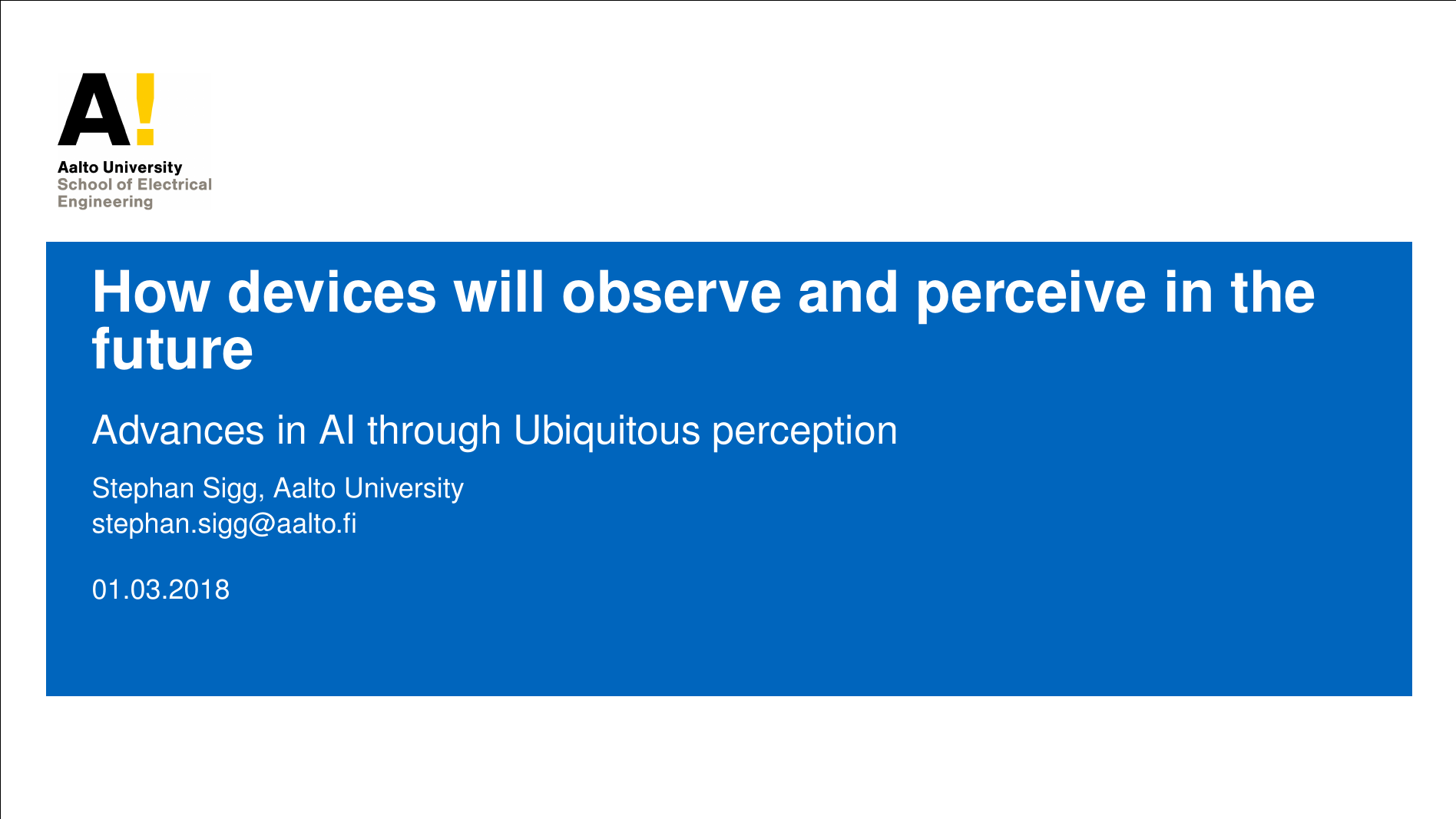

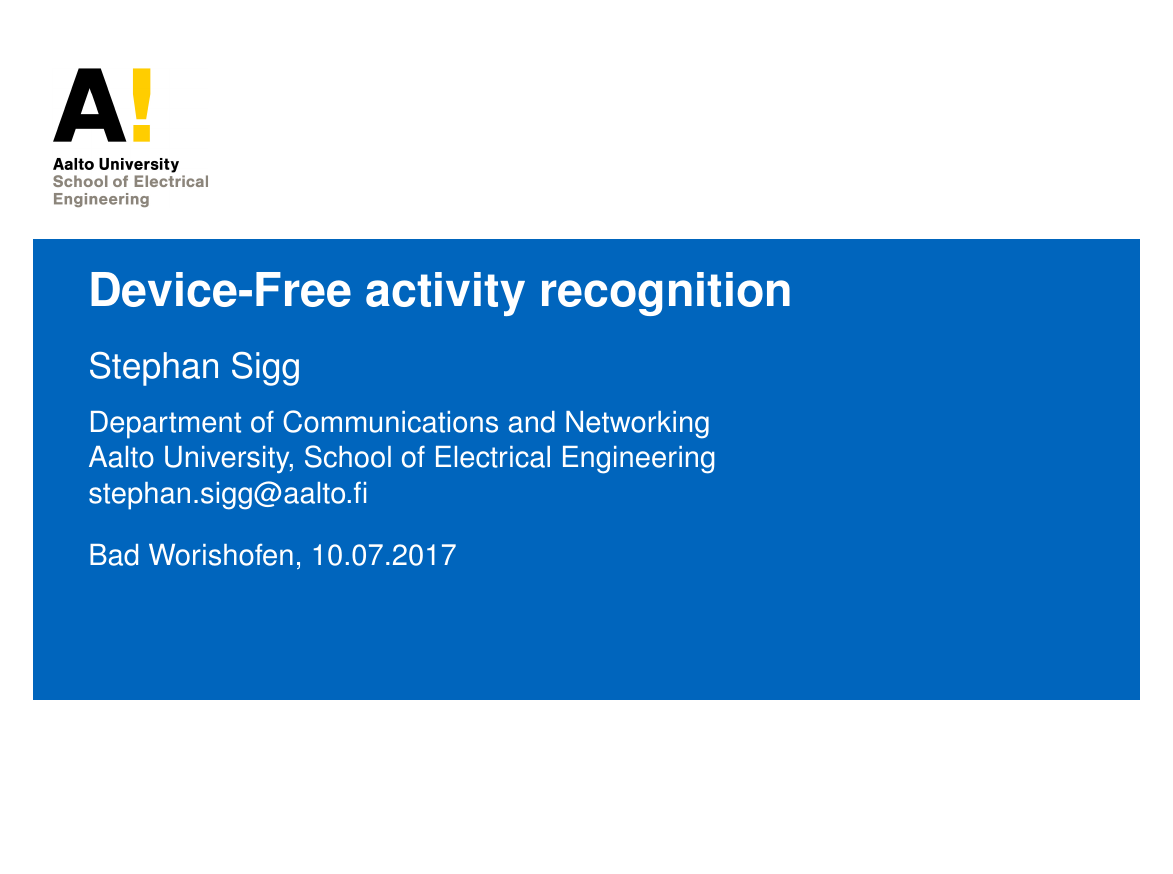
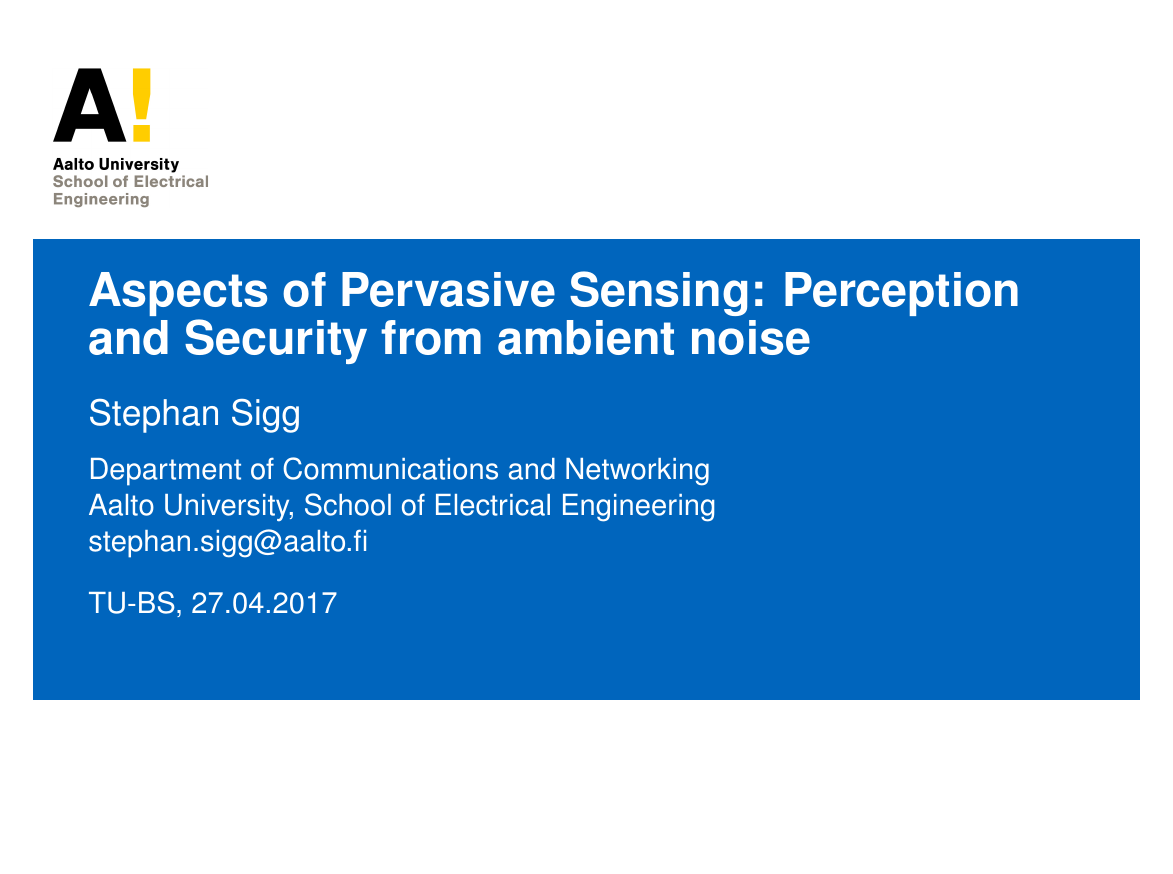

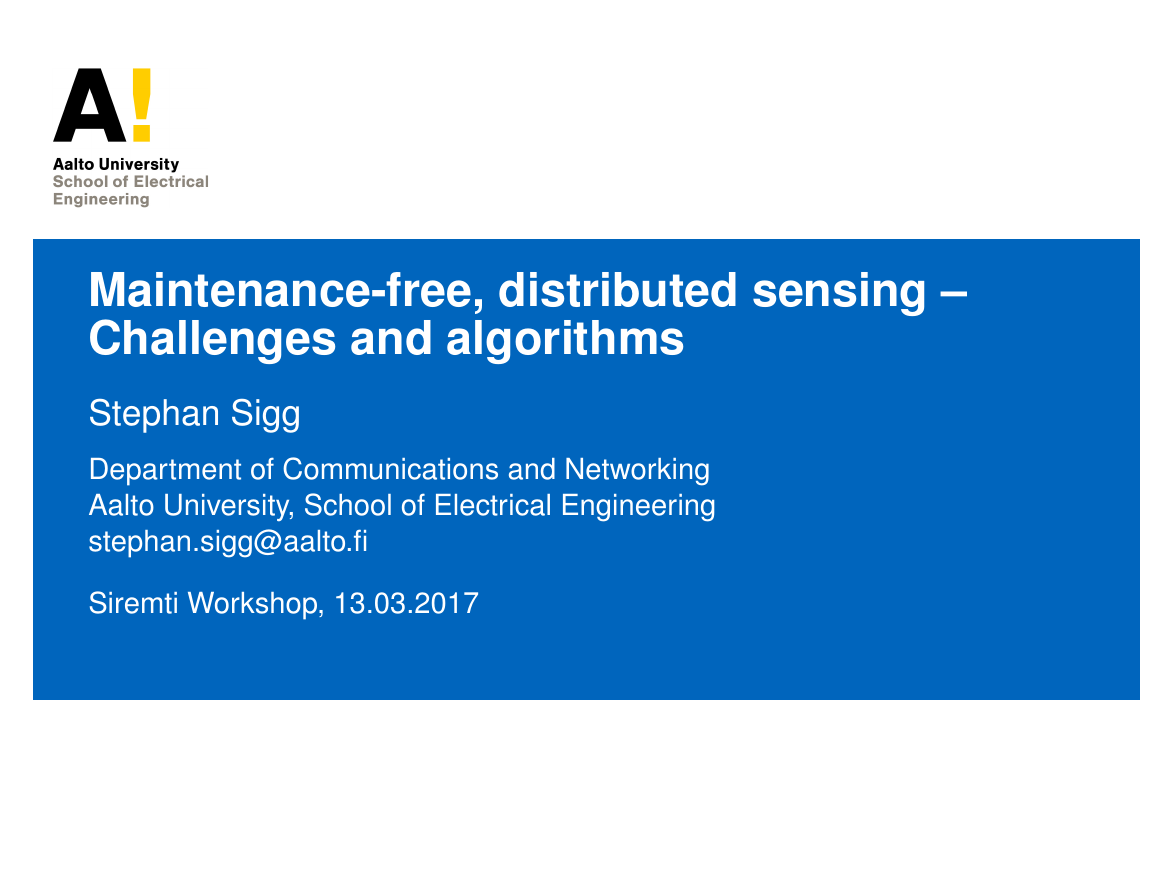
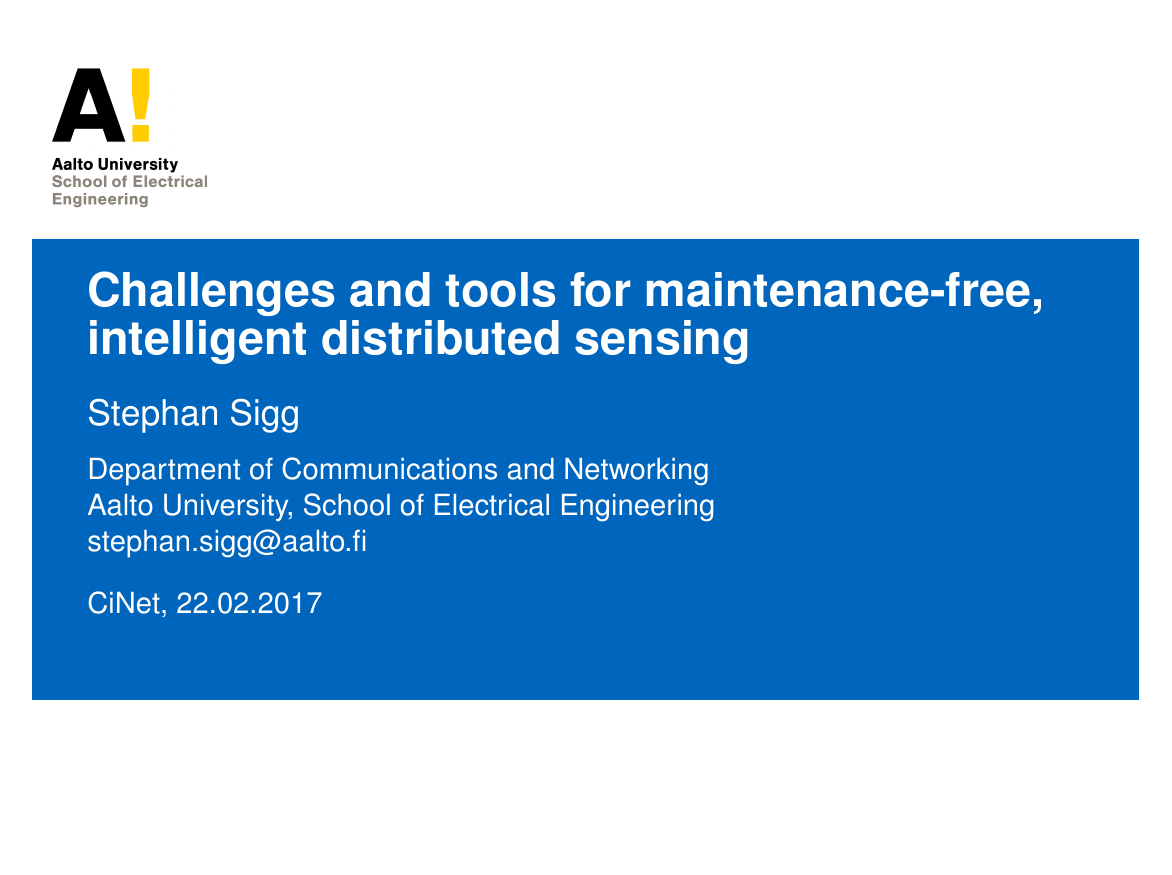
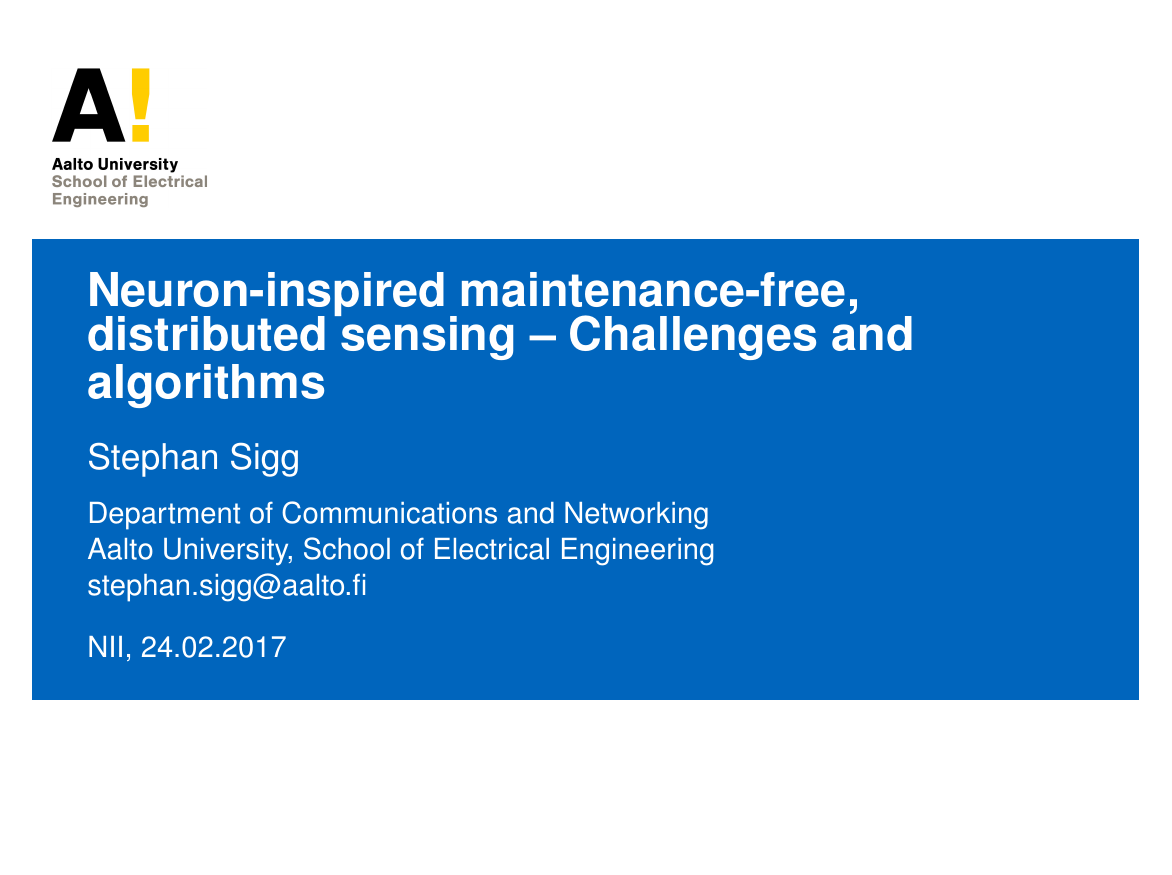
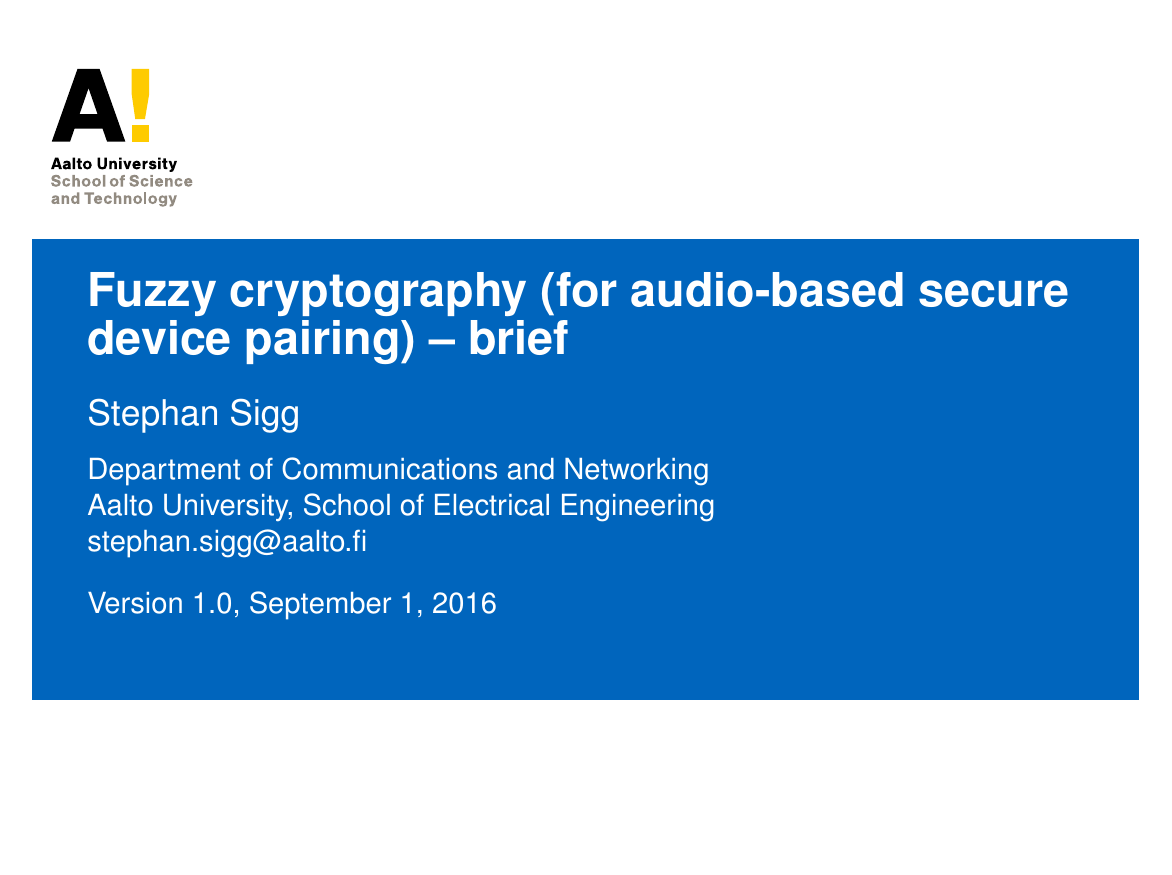
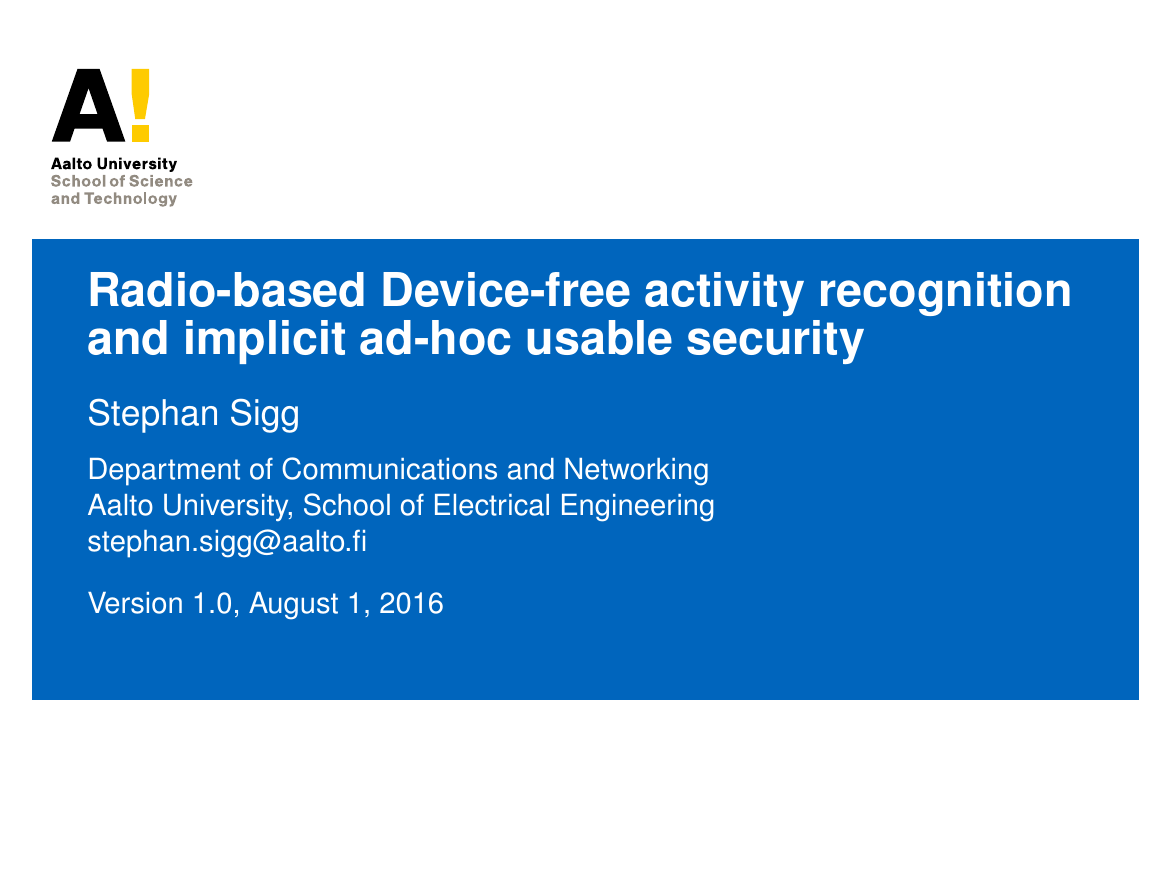
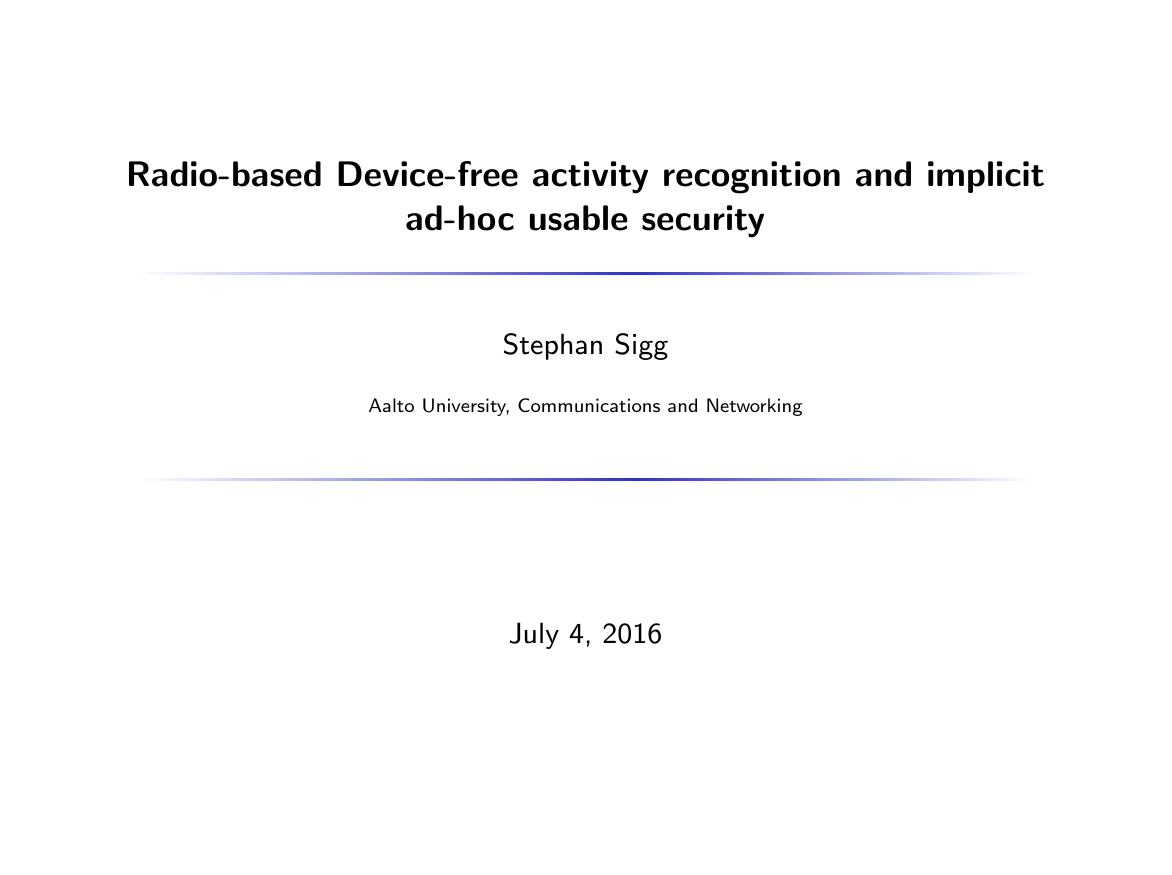
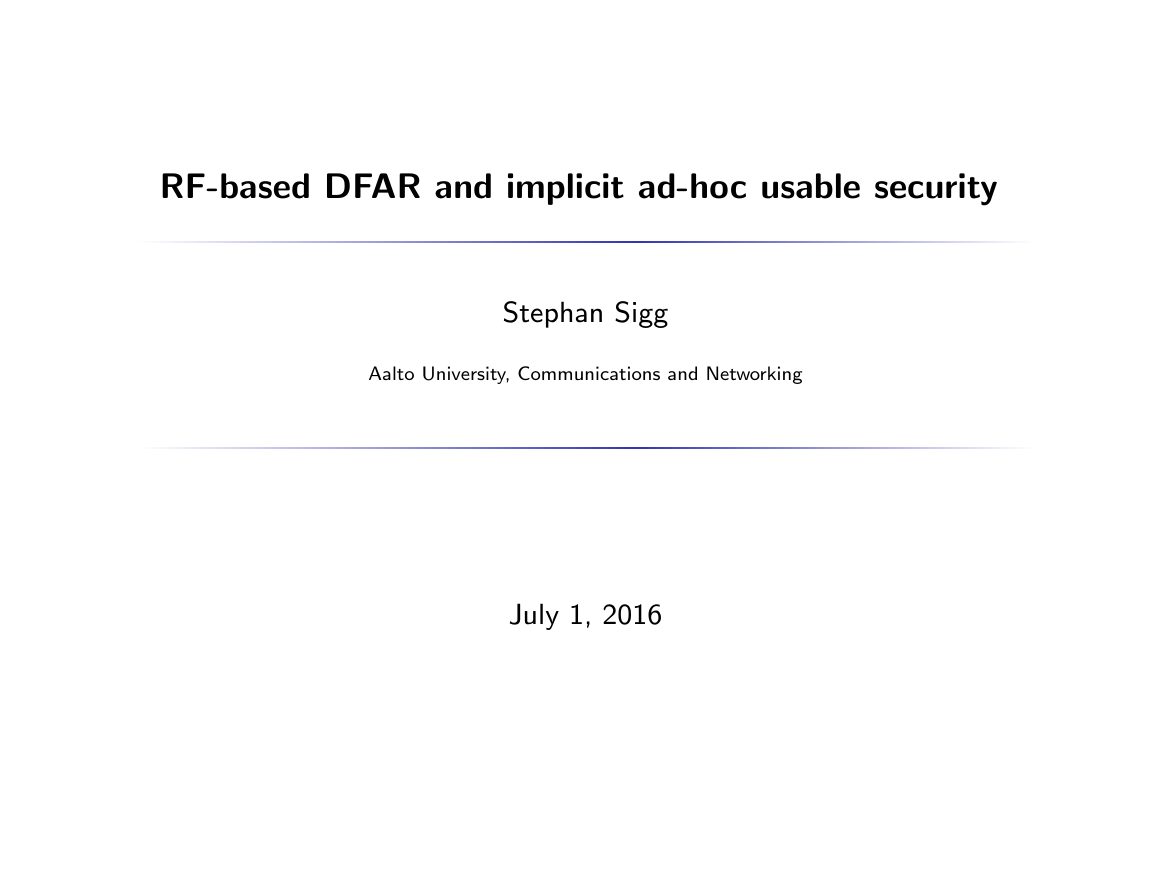
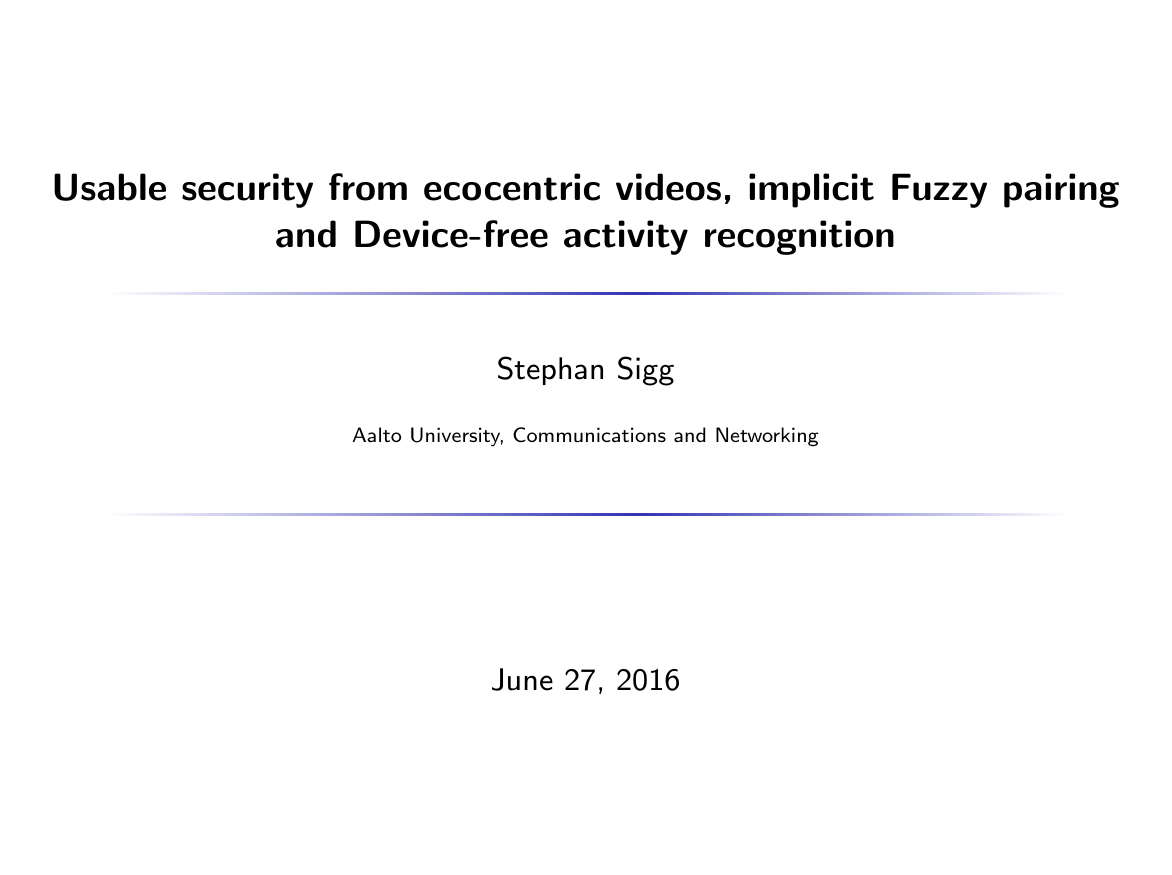
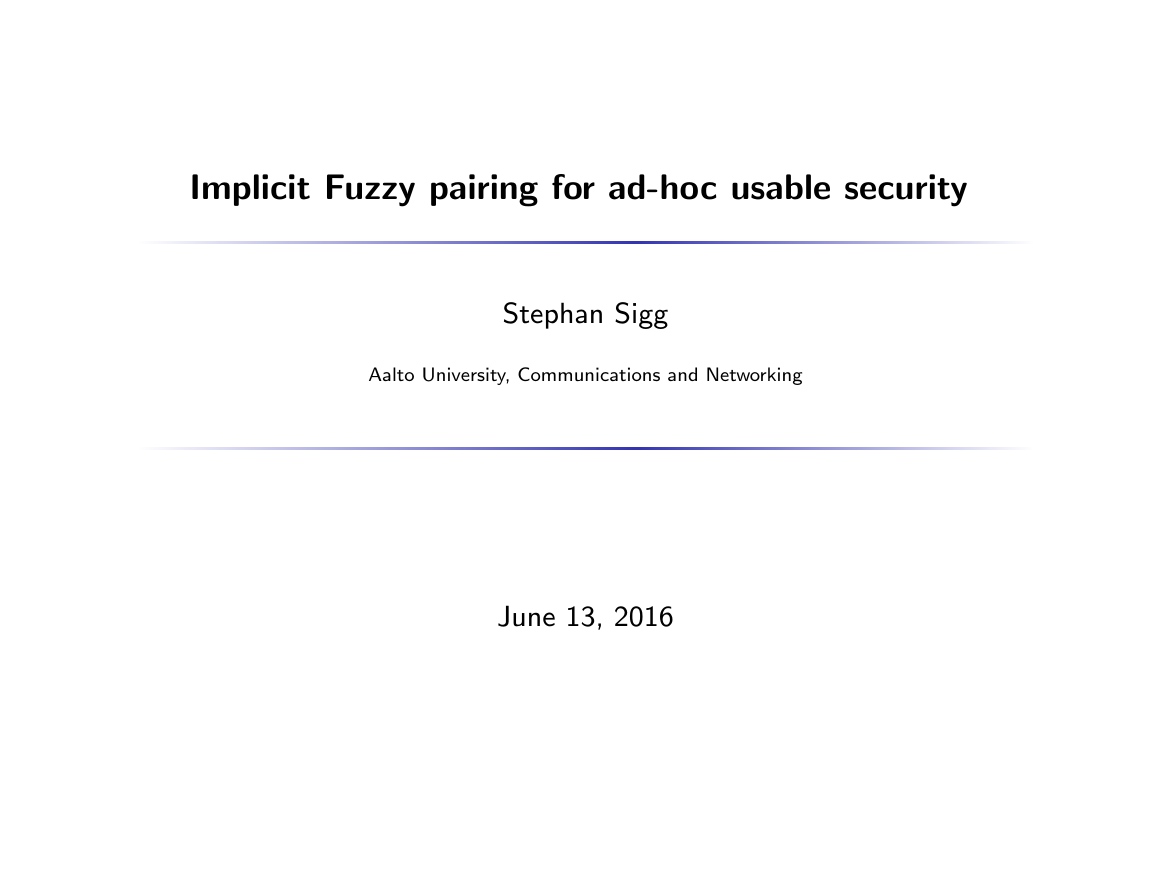
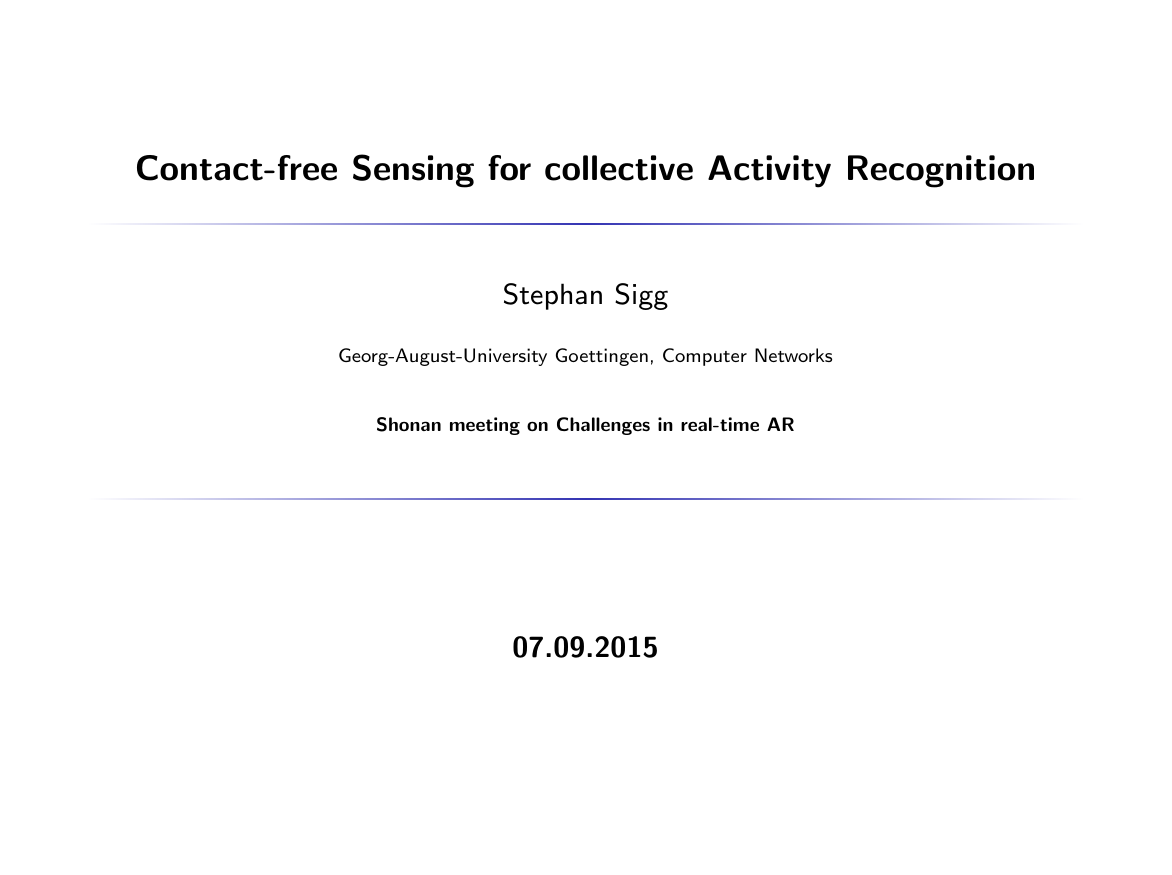
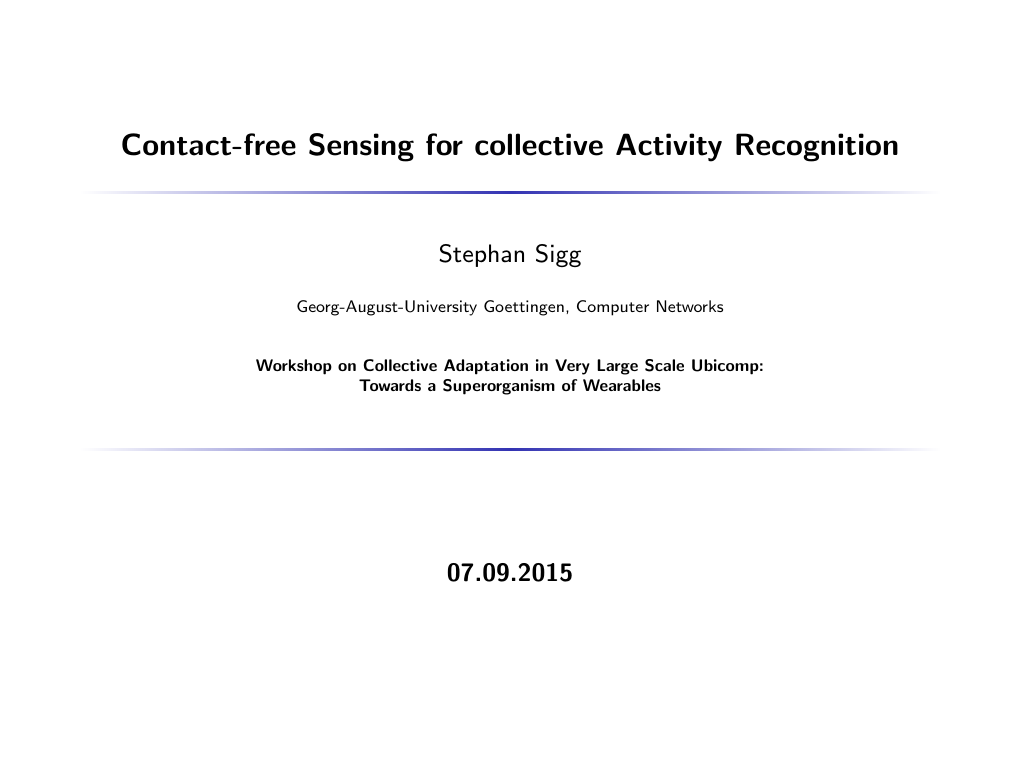
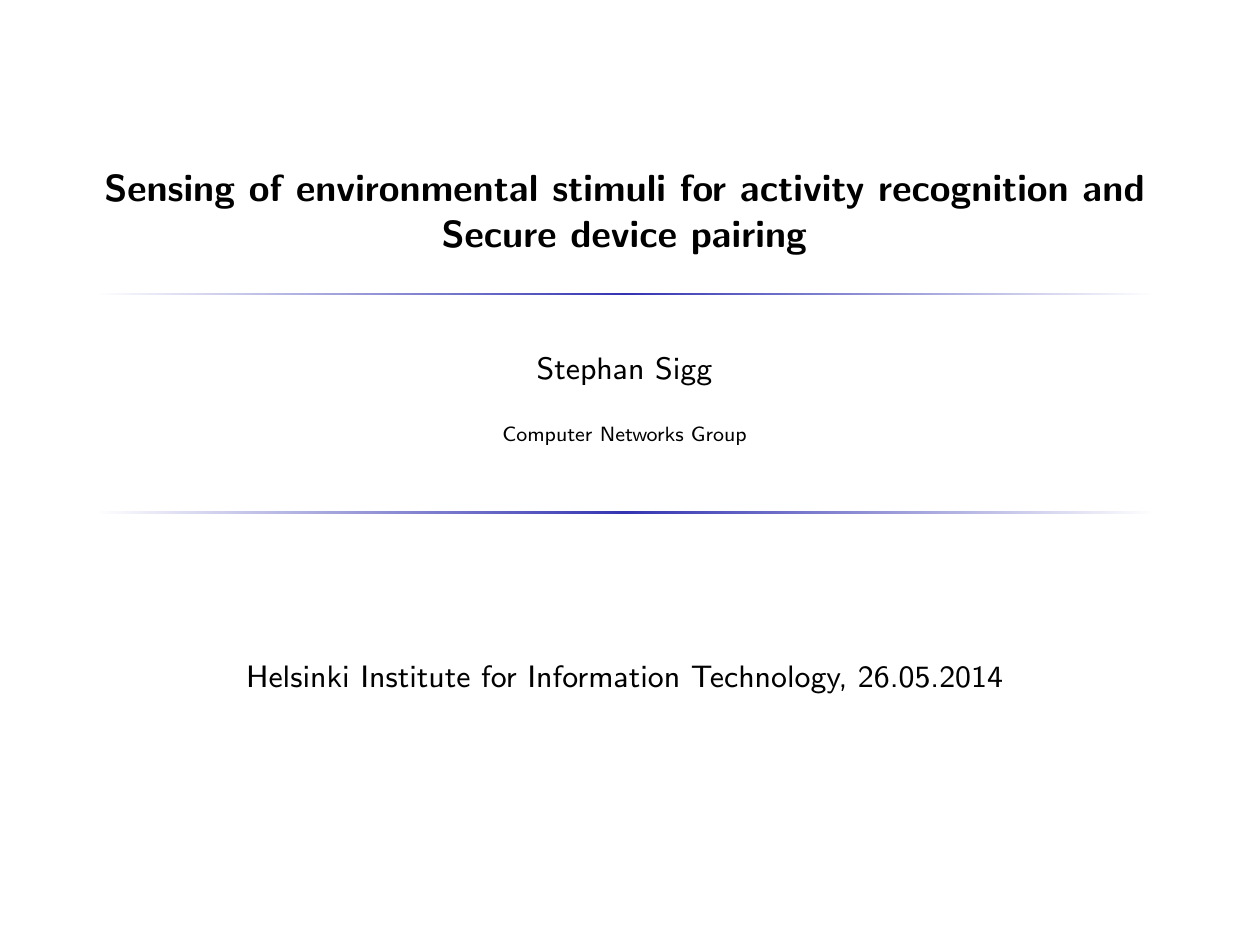
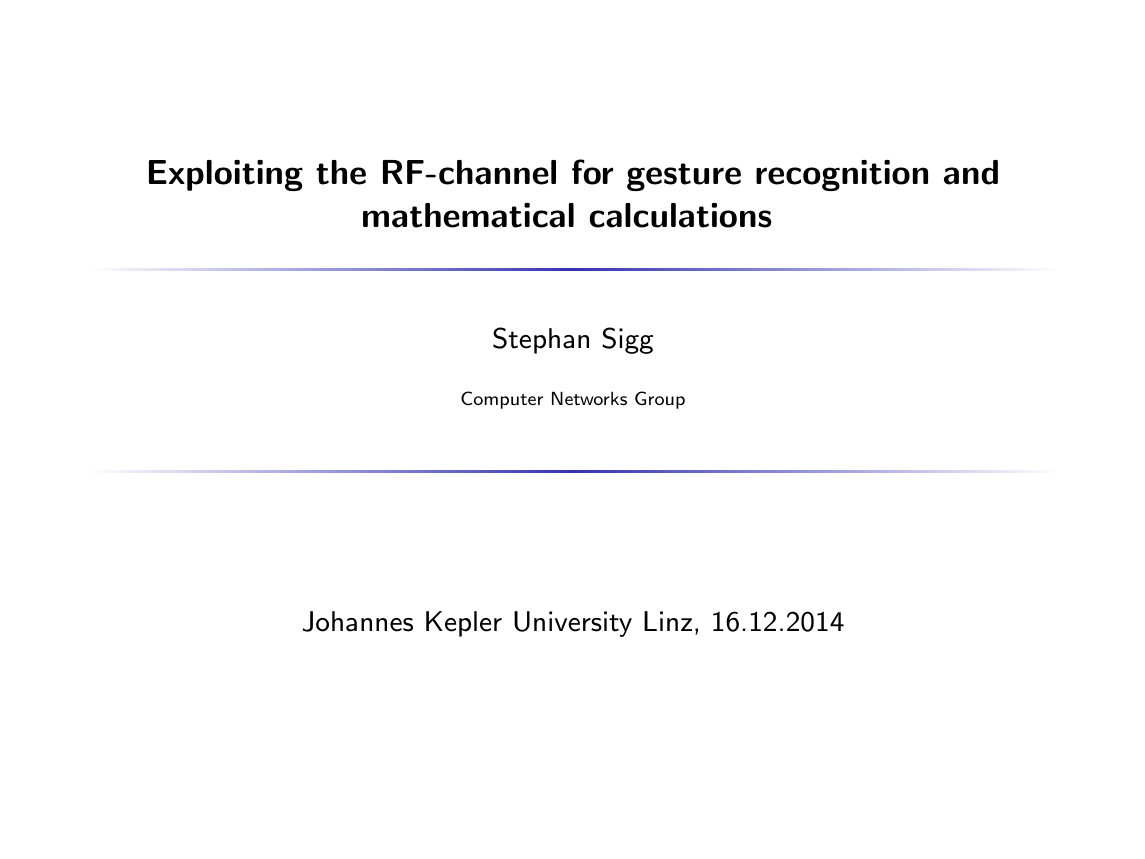
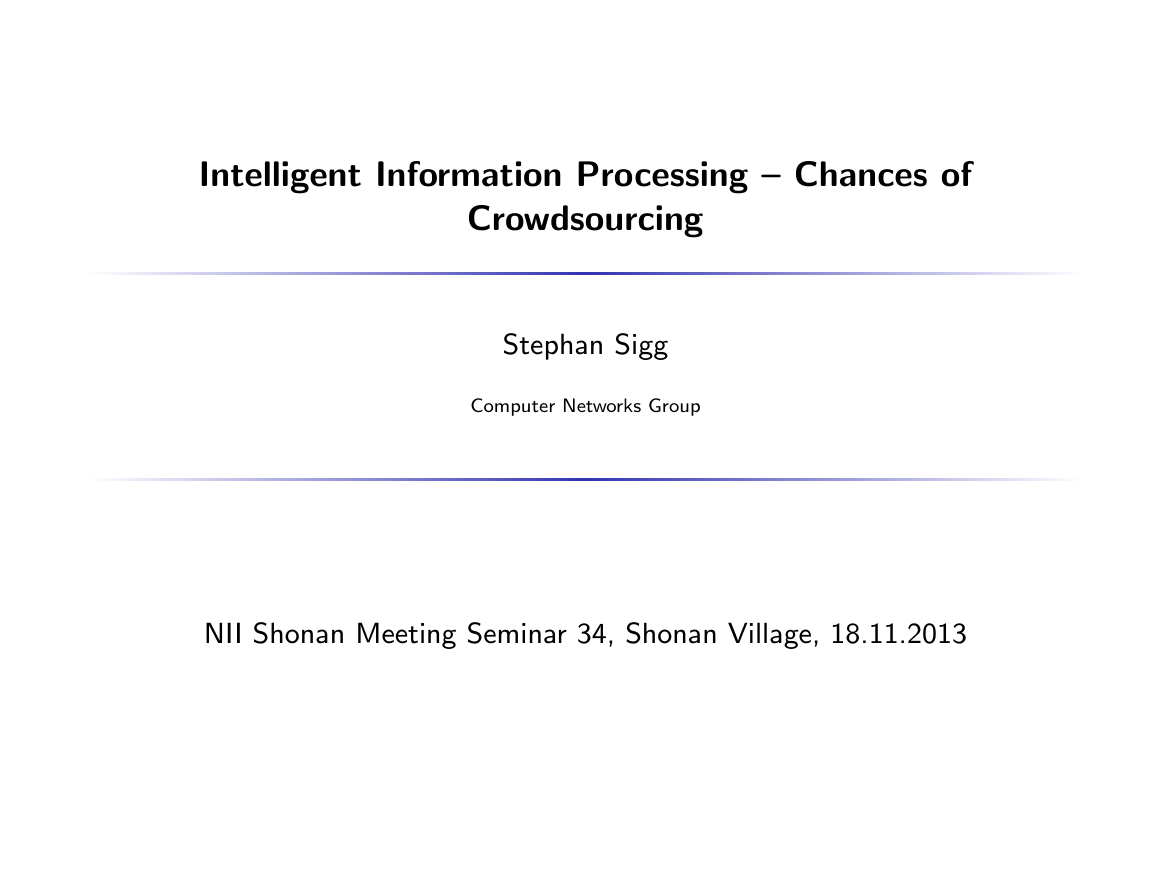
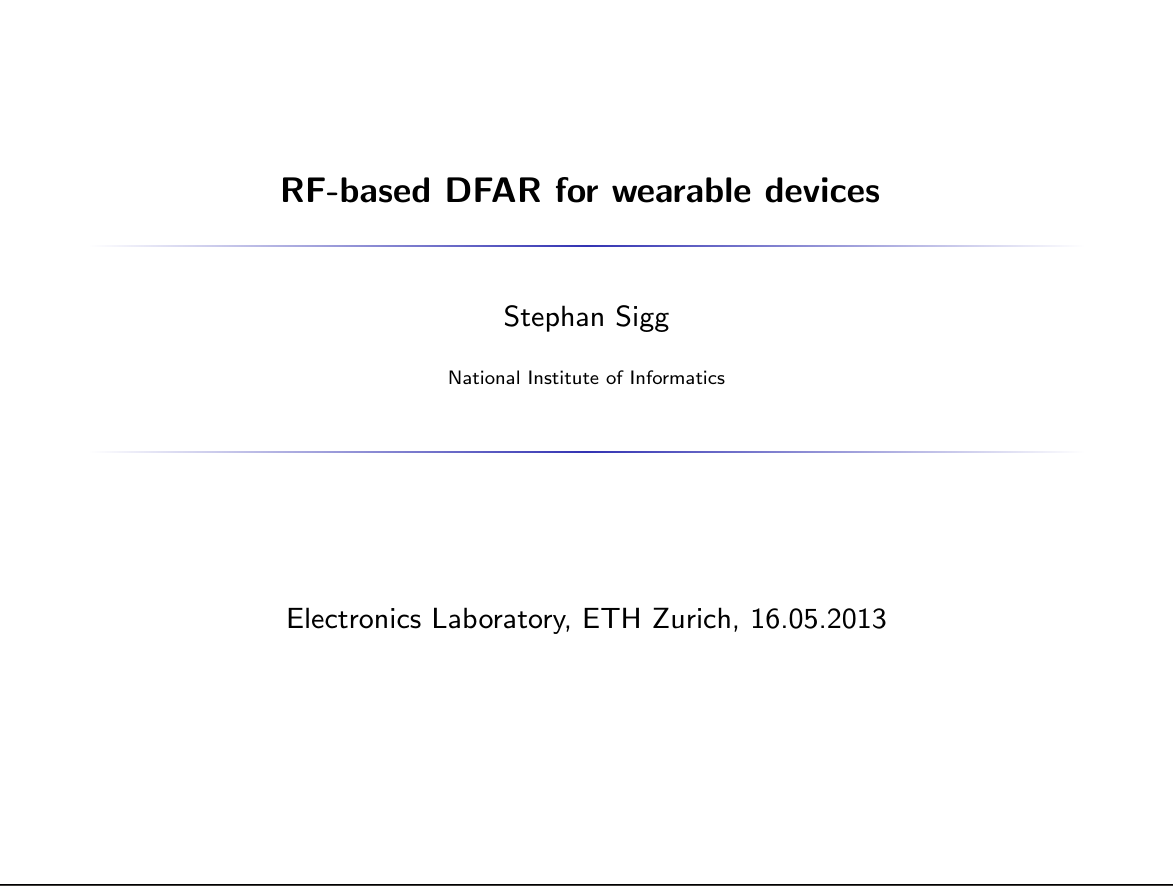
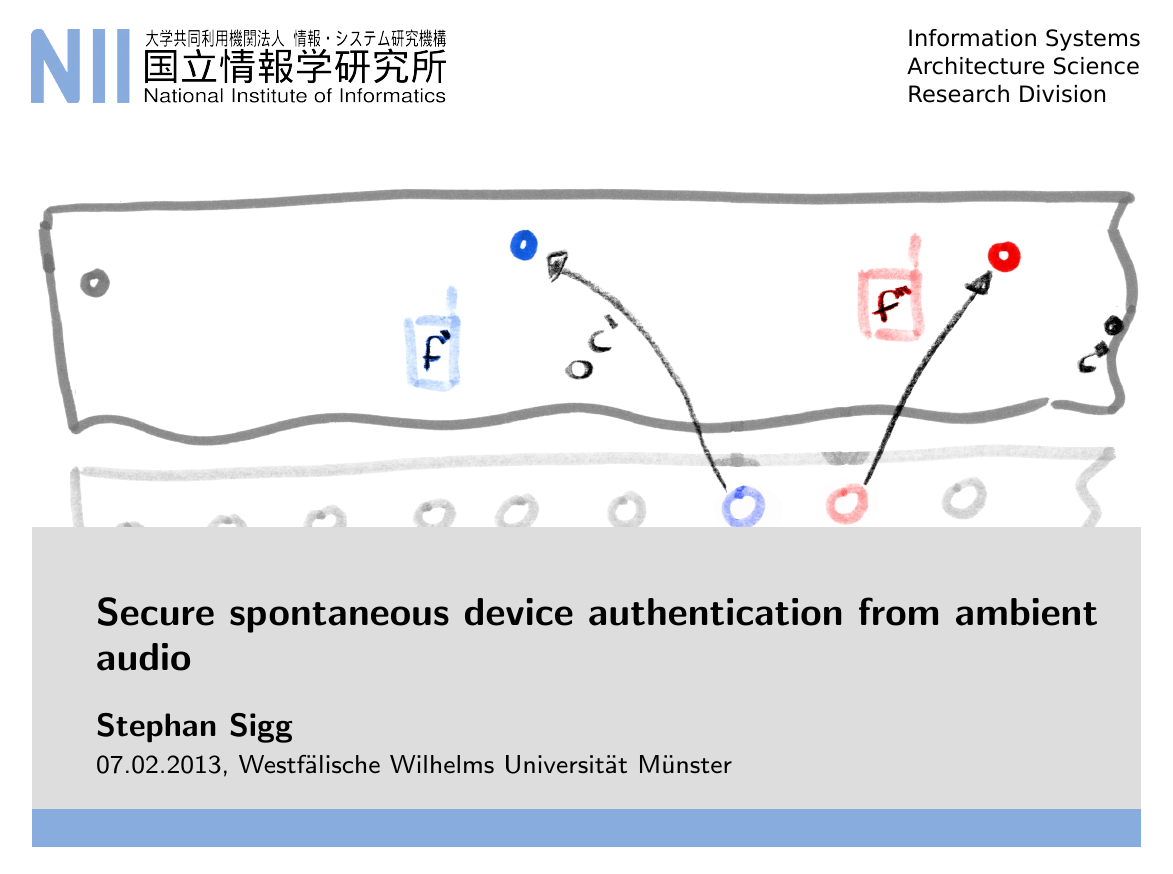
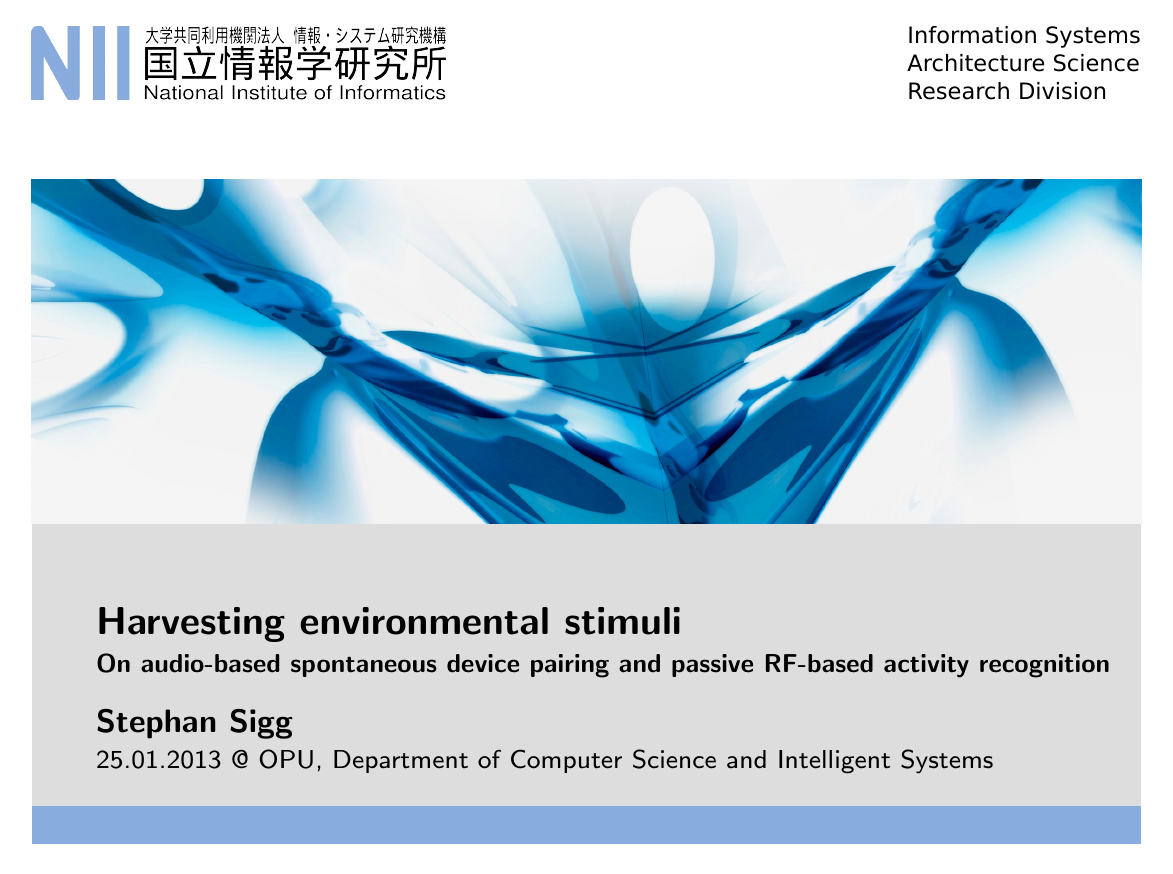
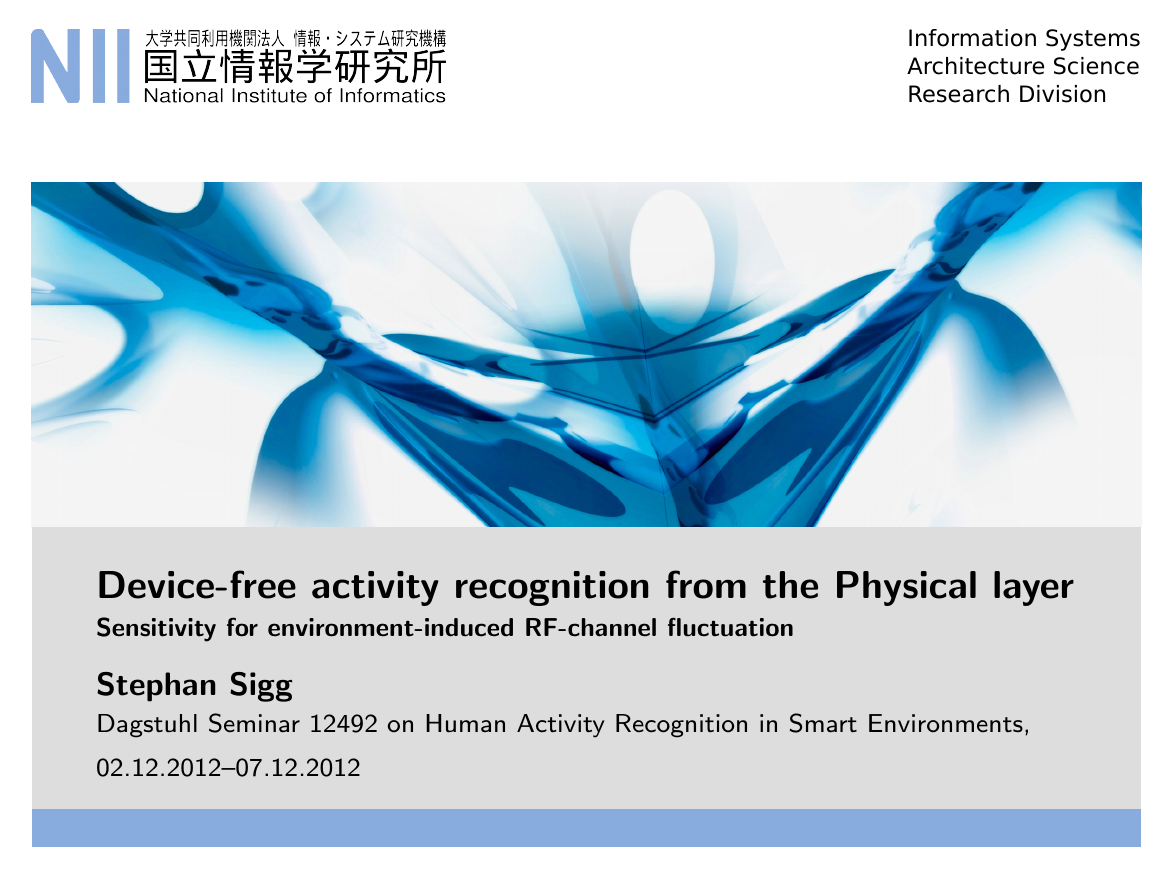
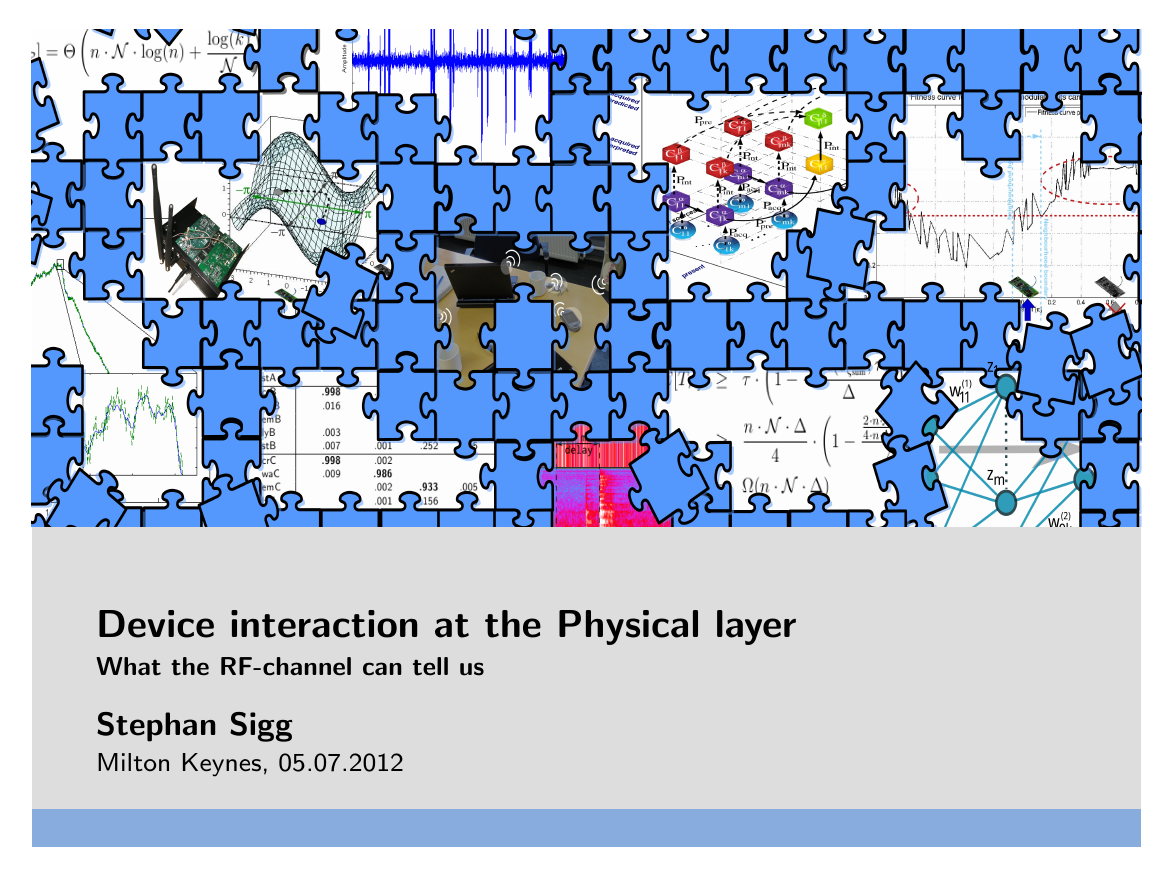
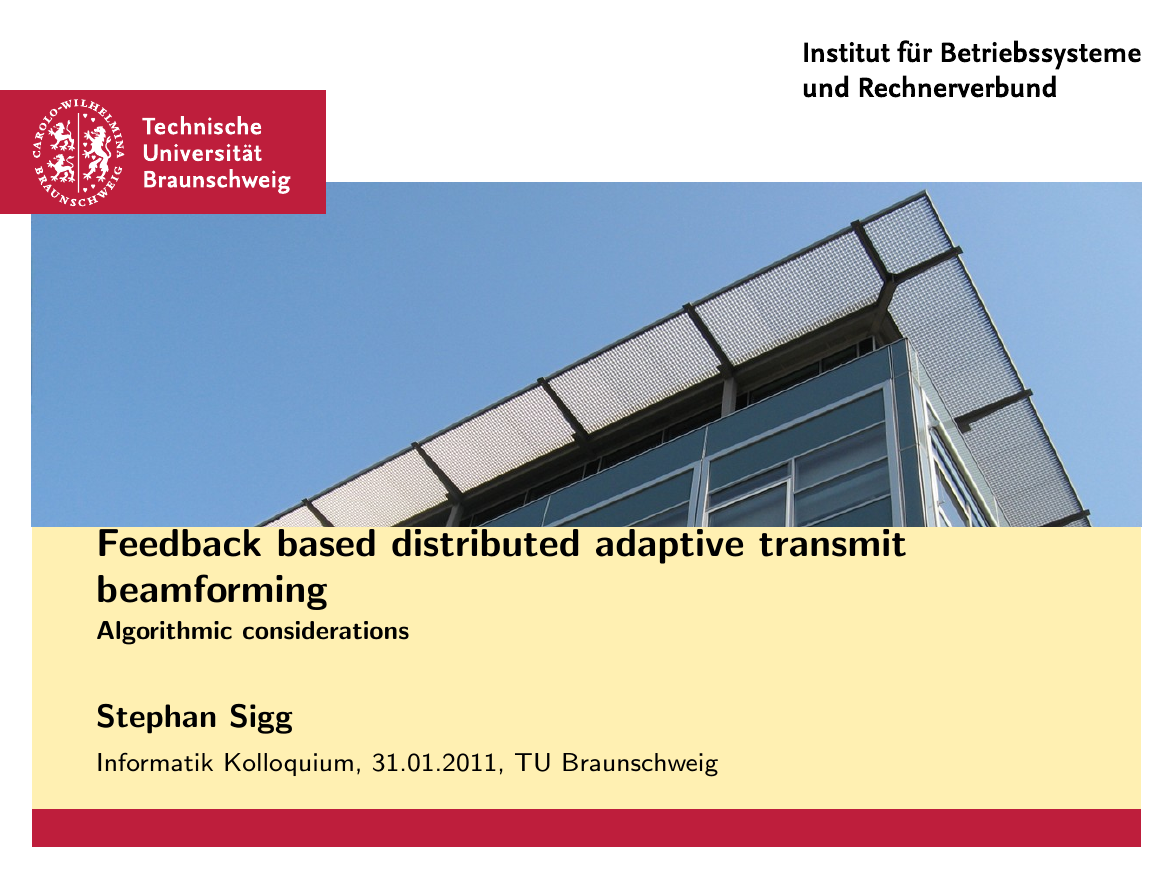
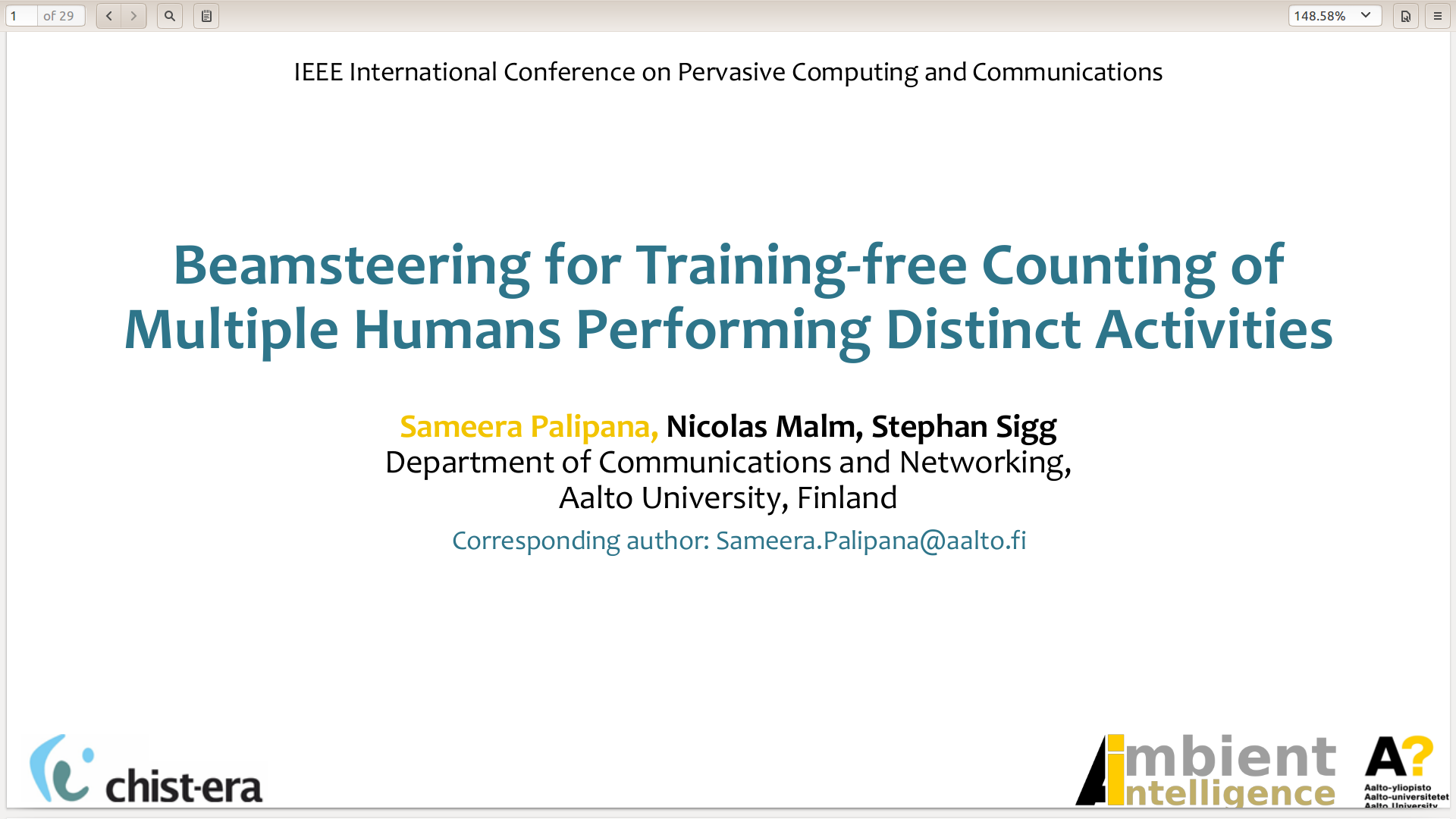 Beamsteering for Training-free Counting of
Multiple Humans Performing Distinct Activities
Beamsteering for Training-free Counting of
Multiple Humans Performing Distinct Activities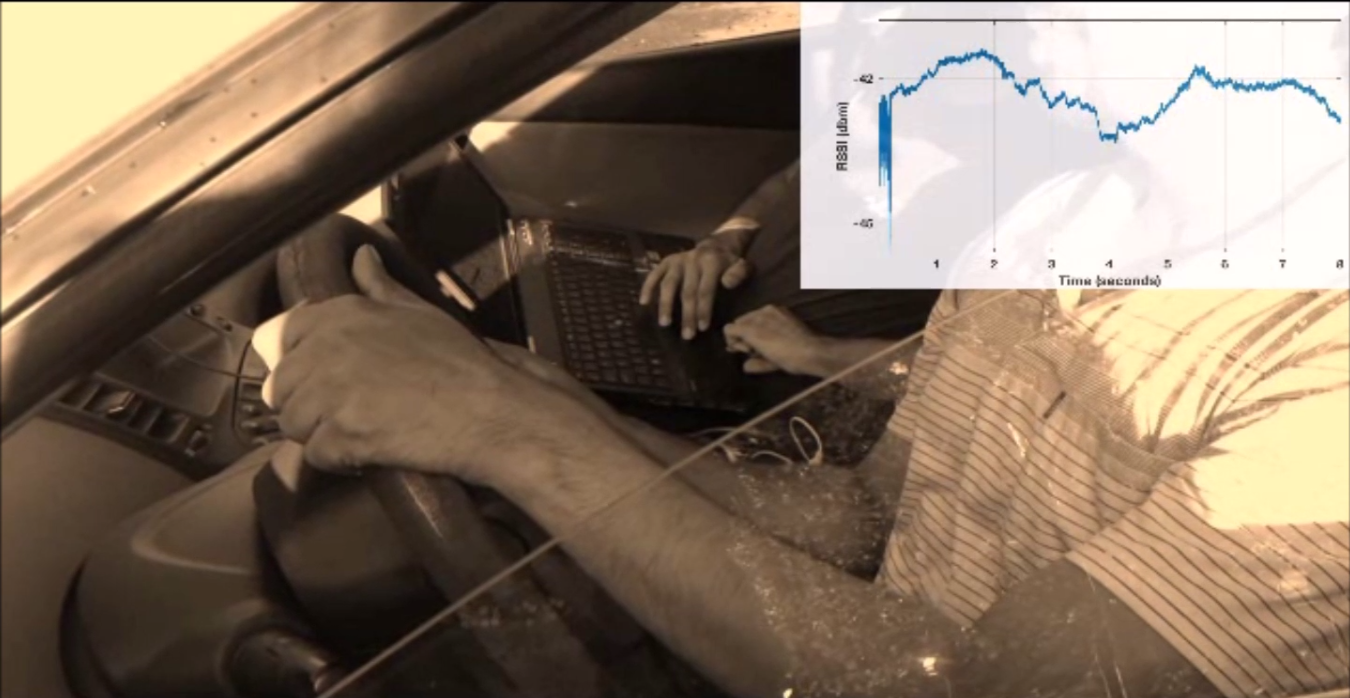 RFexpress! - RF Emotion Recognition in the Wild
RFexpress! - RF Emotion Recognition in the Wild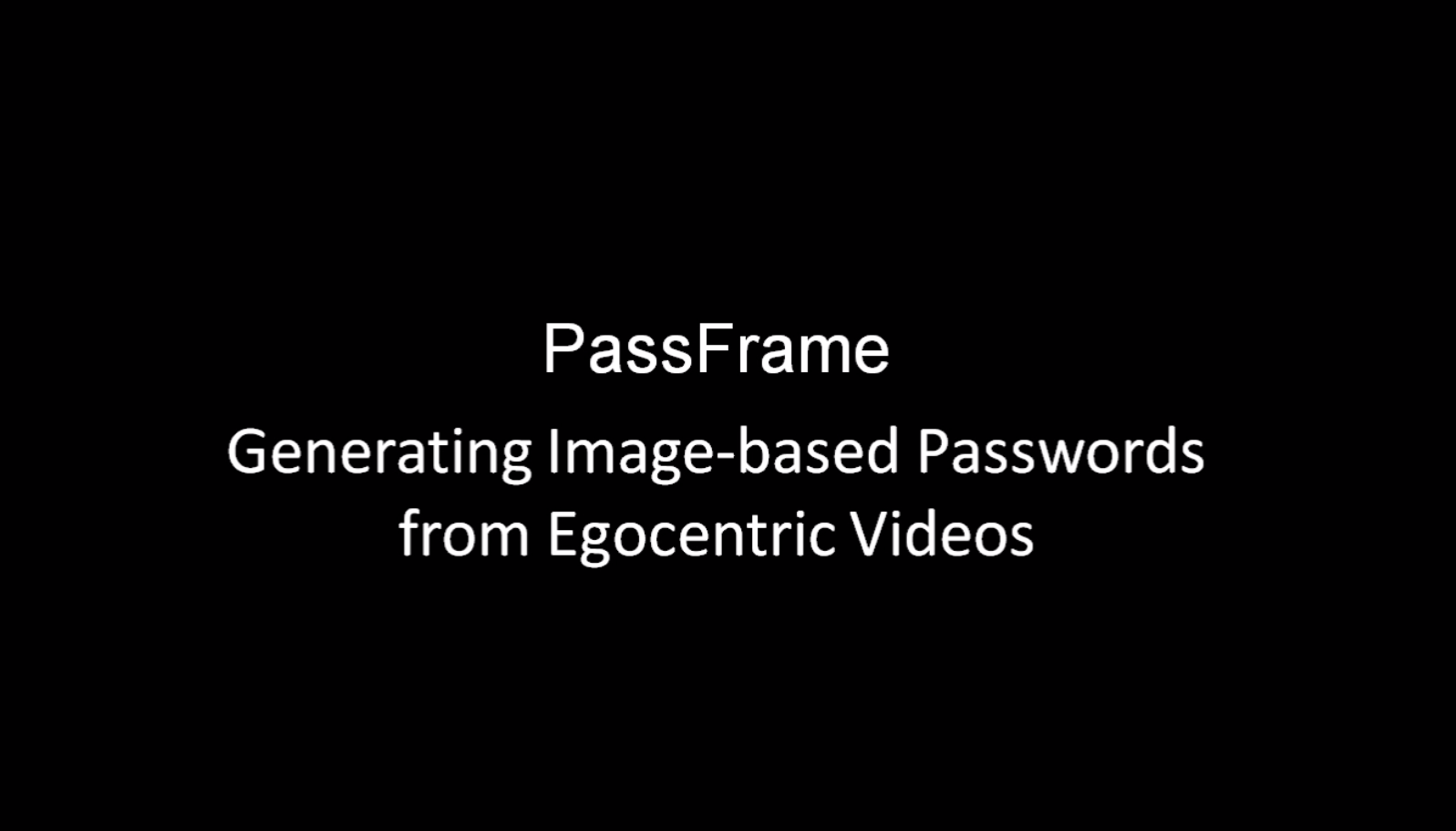 PassFrame: Generating Image-based Passwords from Egocentric Videos
PassFrame: Generating Image-based Passwords from Egocentric Videos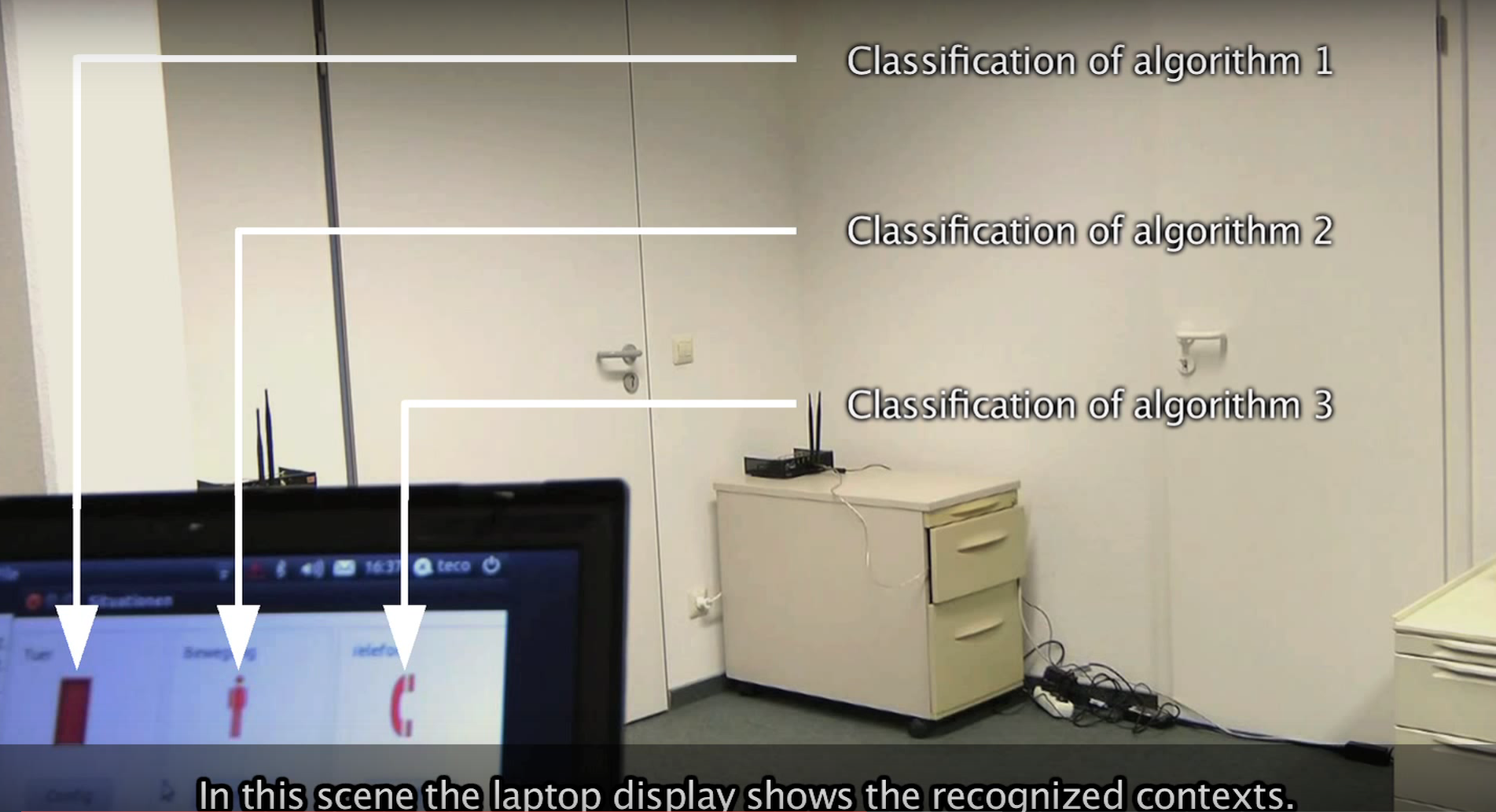 SenseWaves: Radiowaves for context recognition, Pervasive 2011
SenseWaves: Radiowaves for context recognition, Pervasive 2011